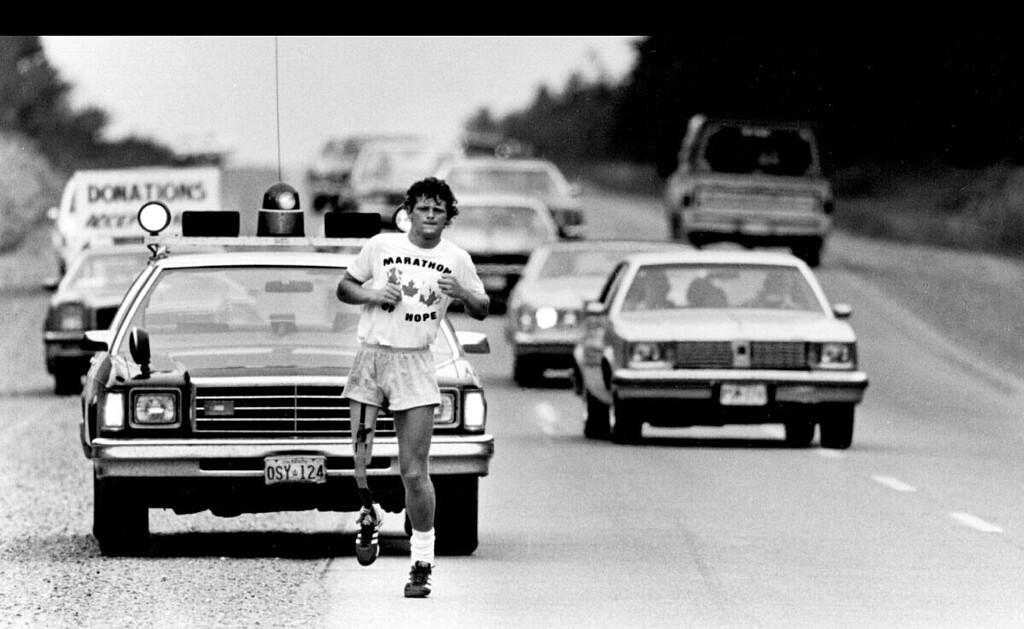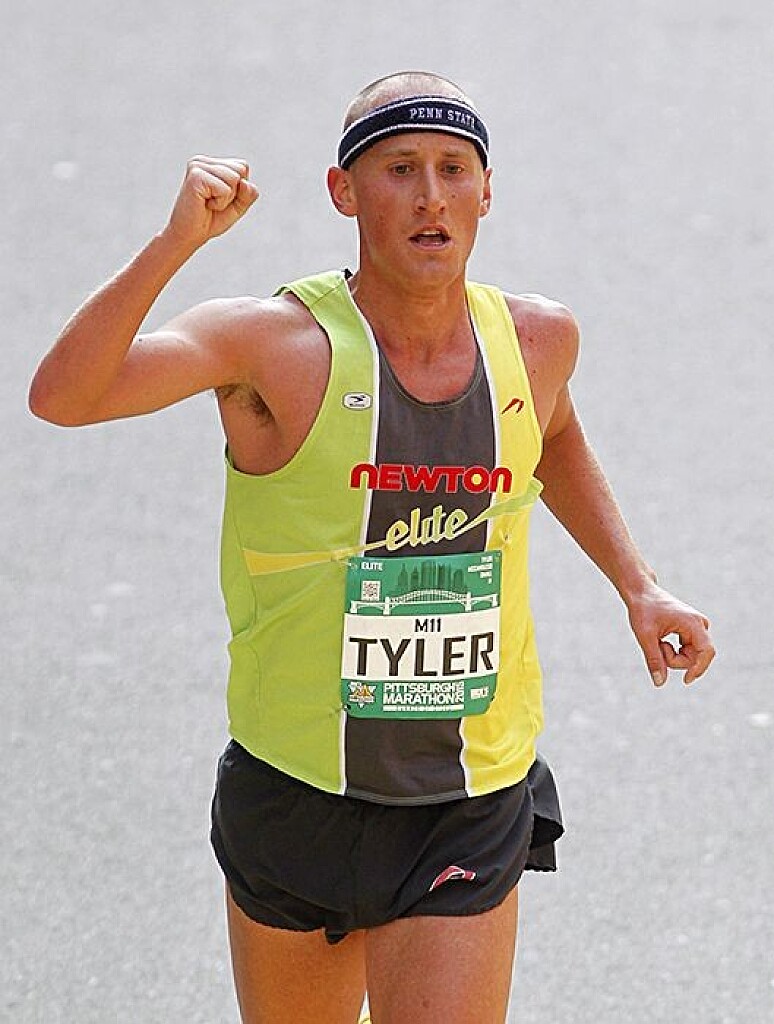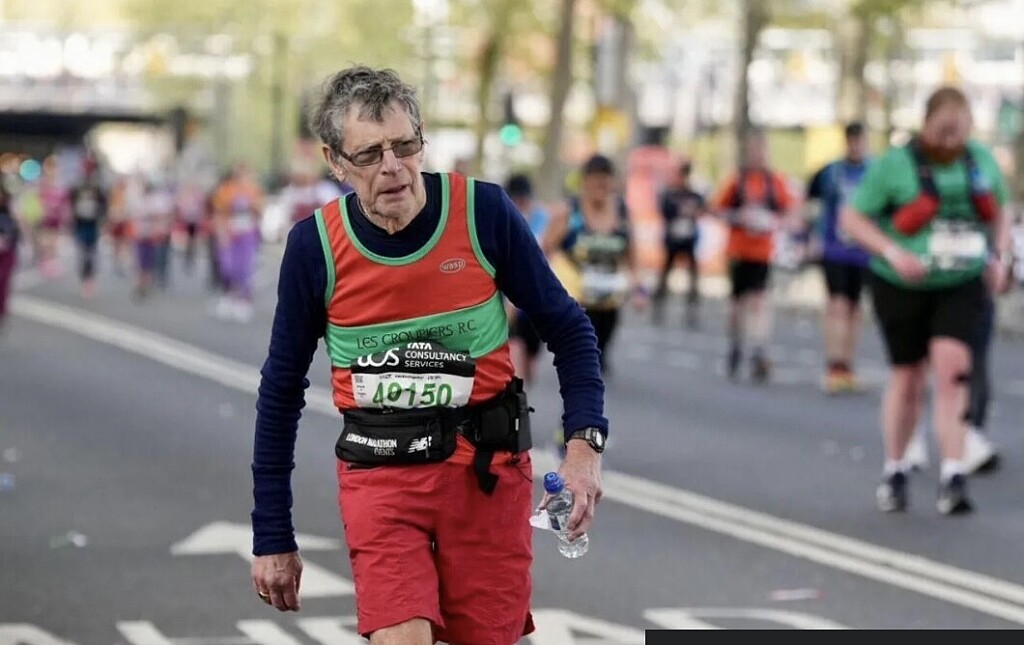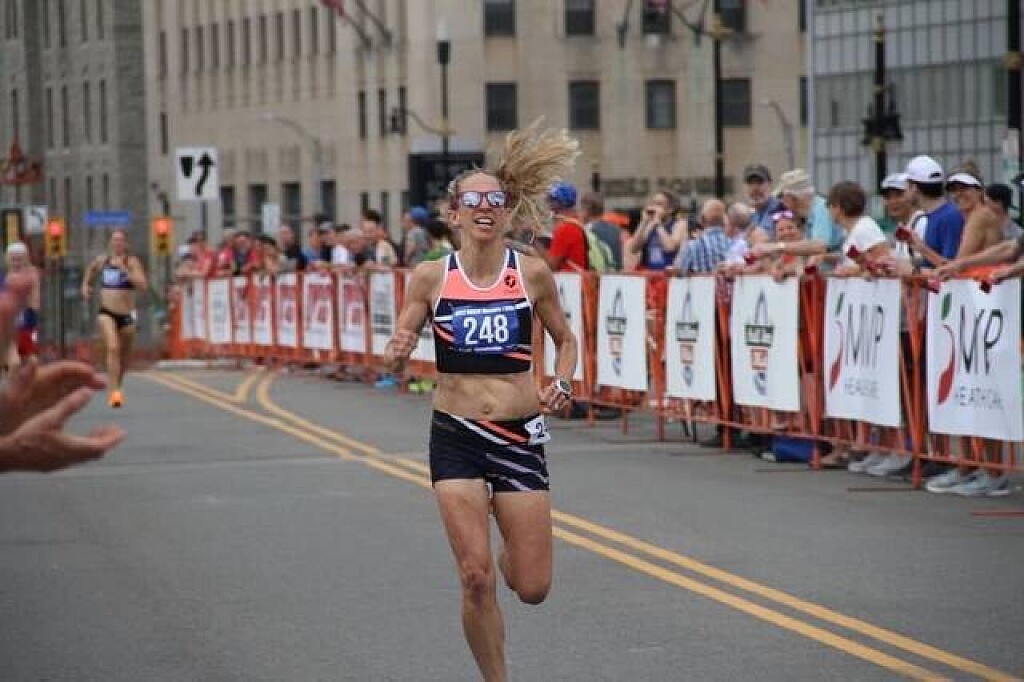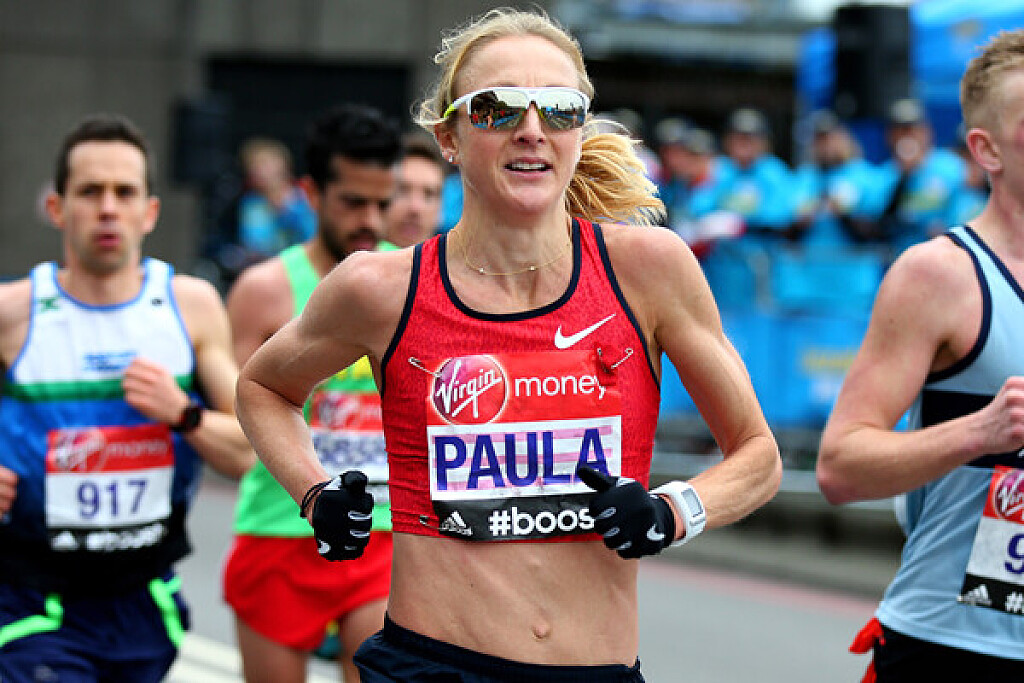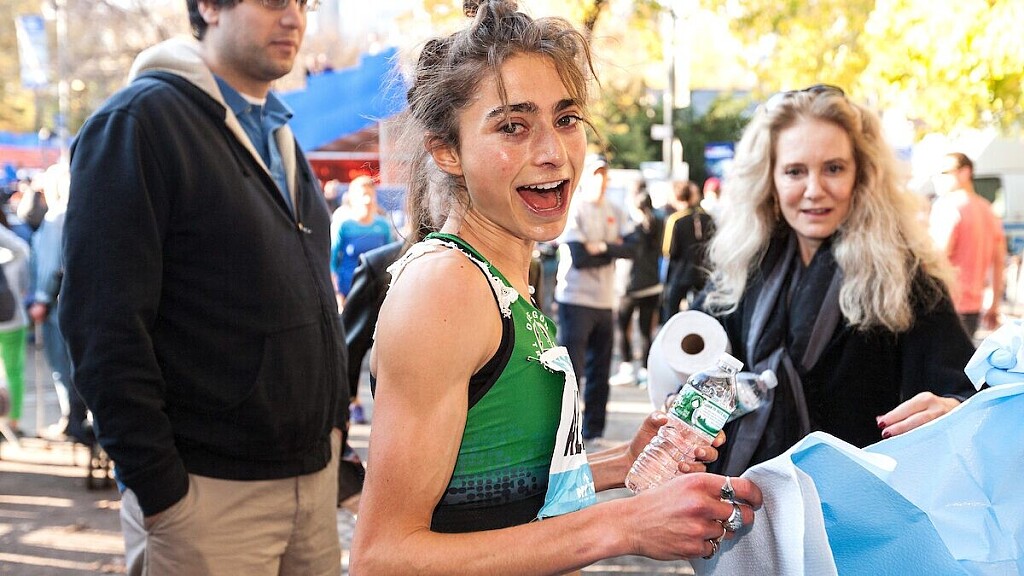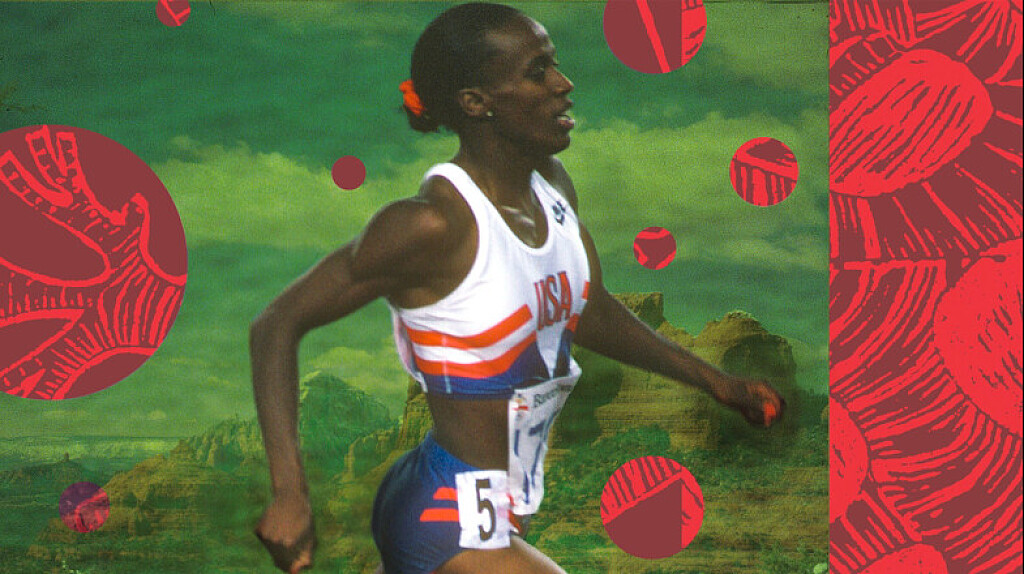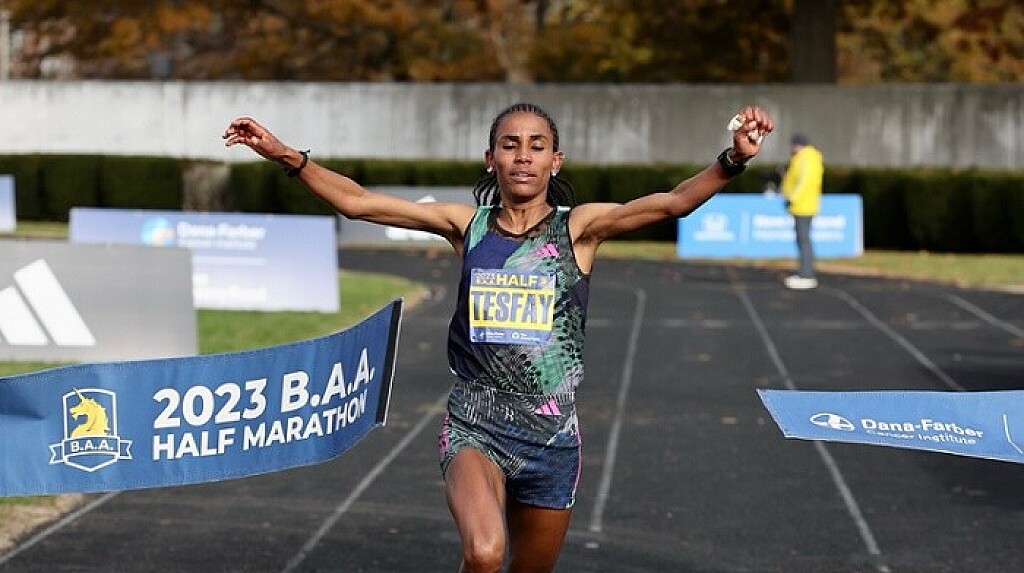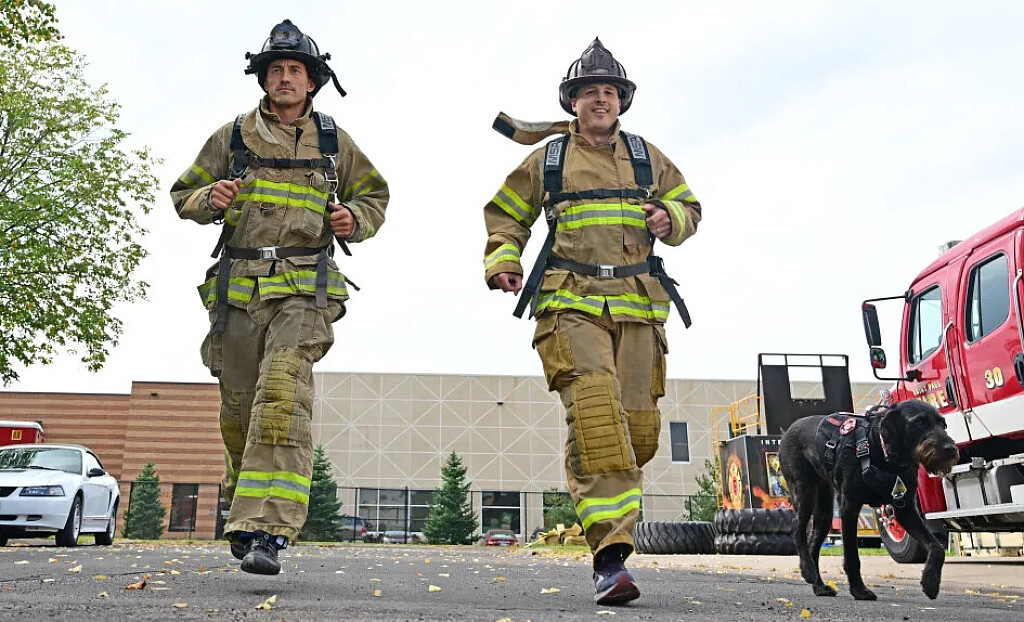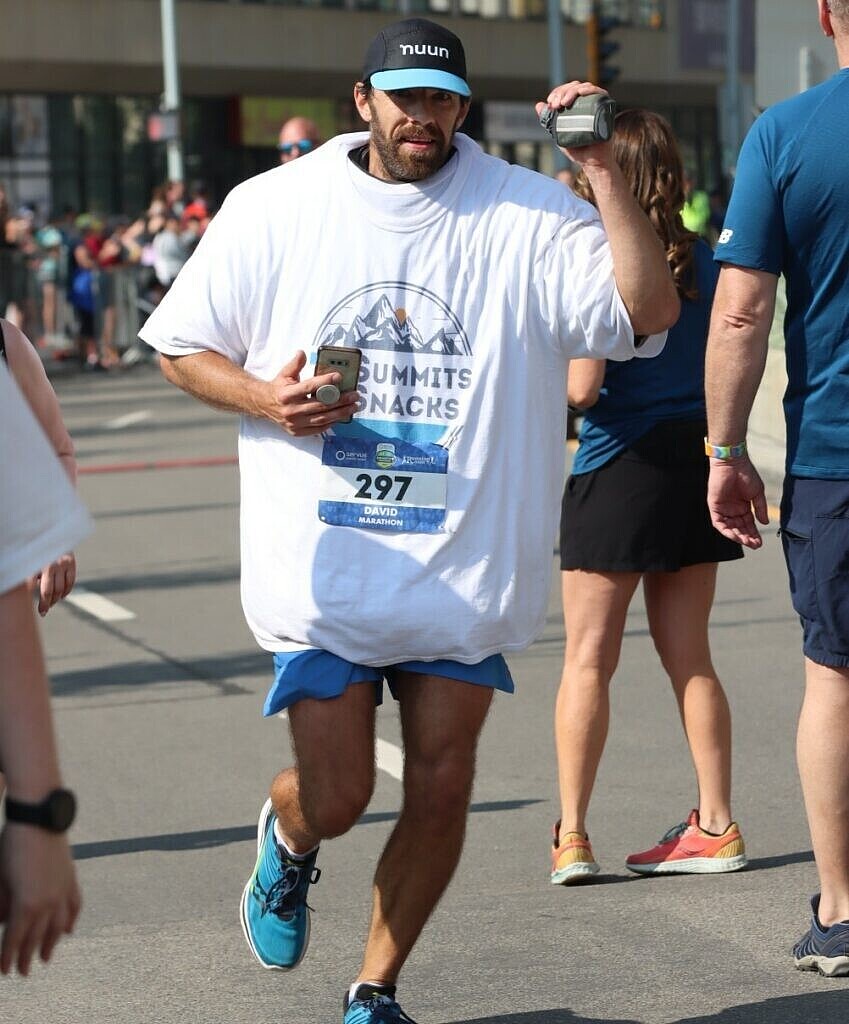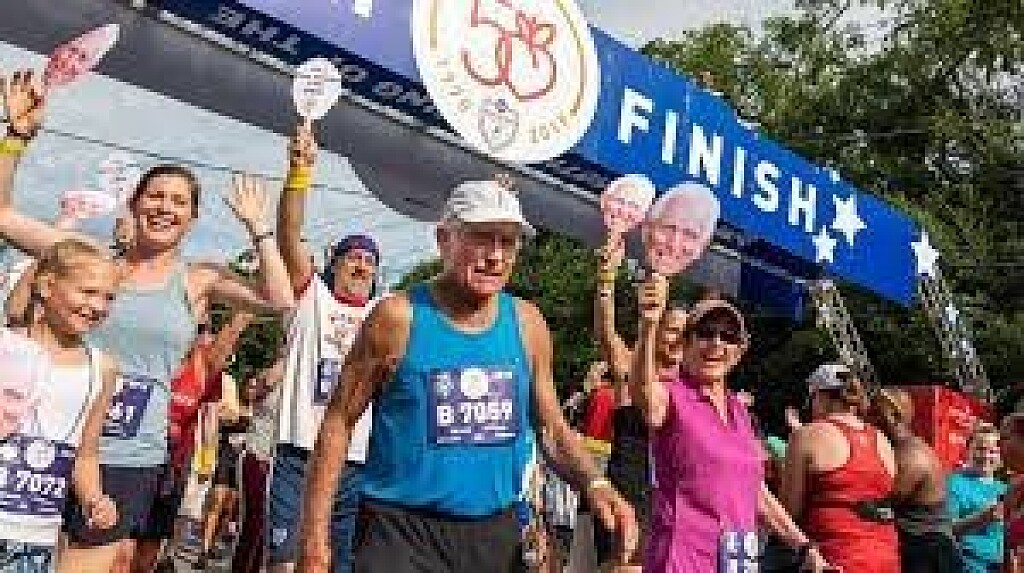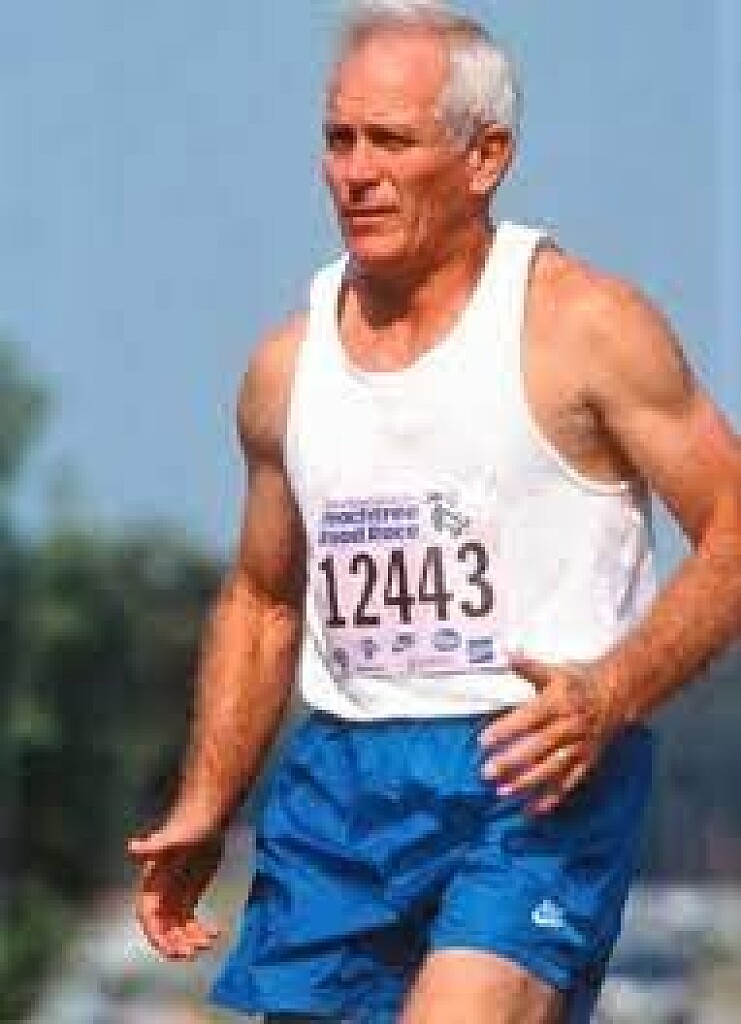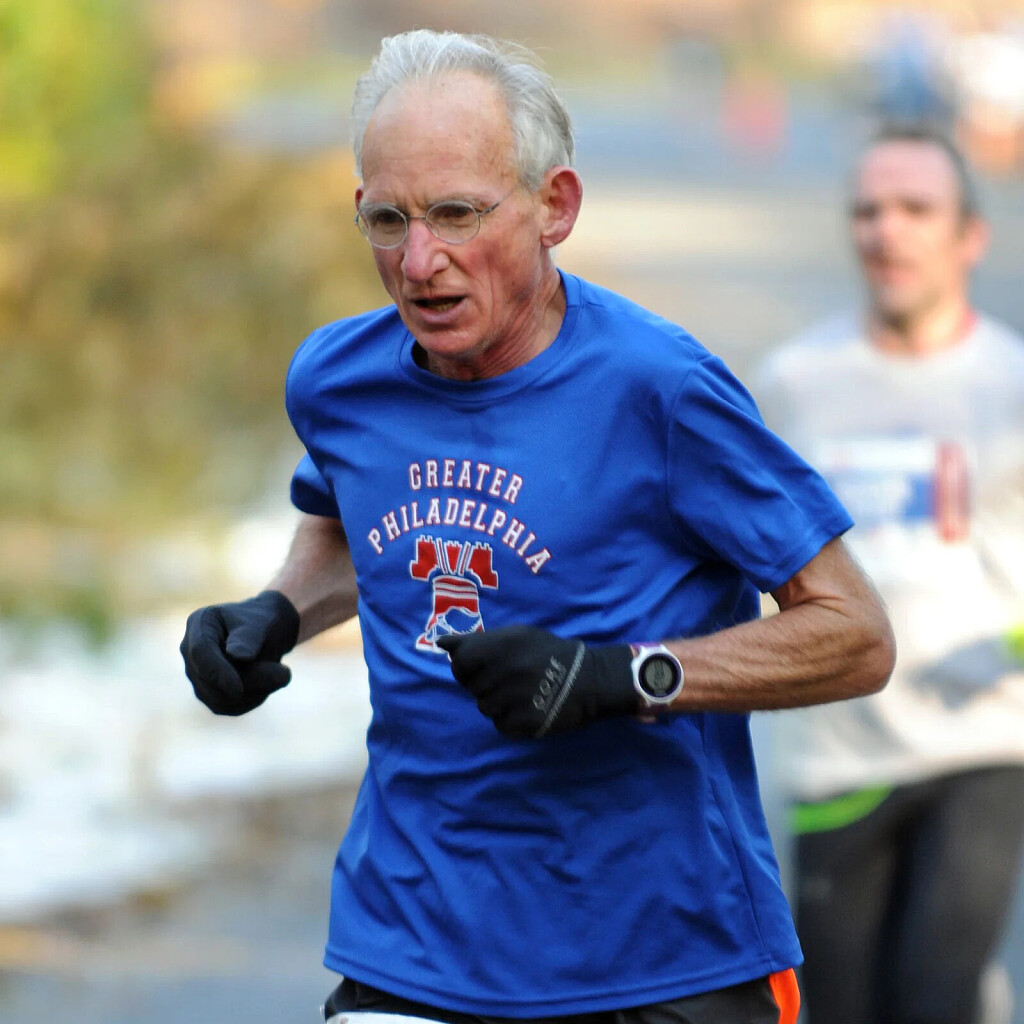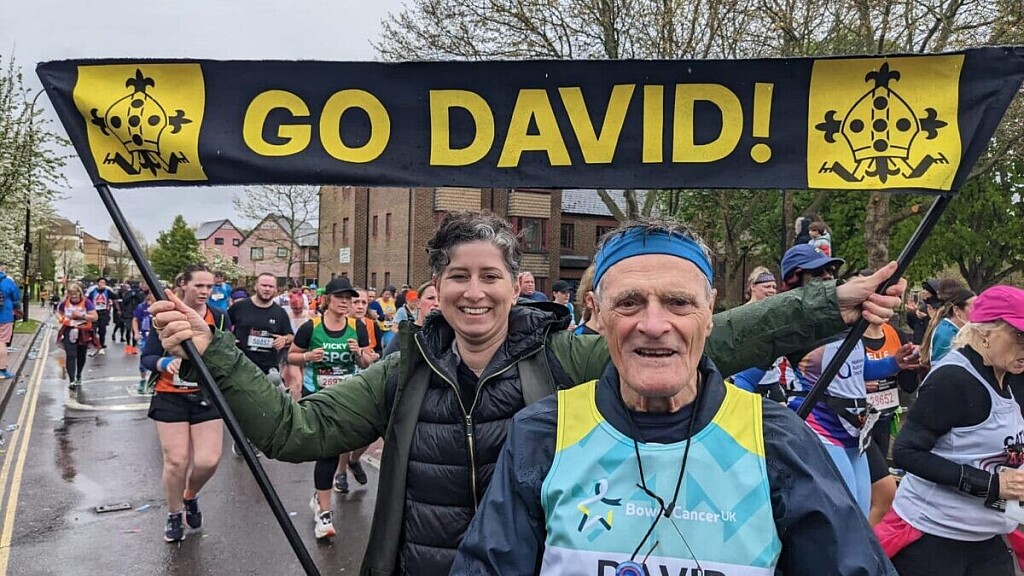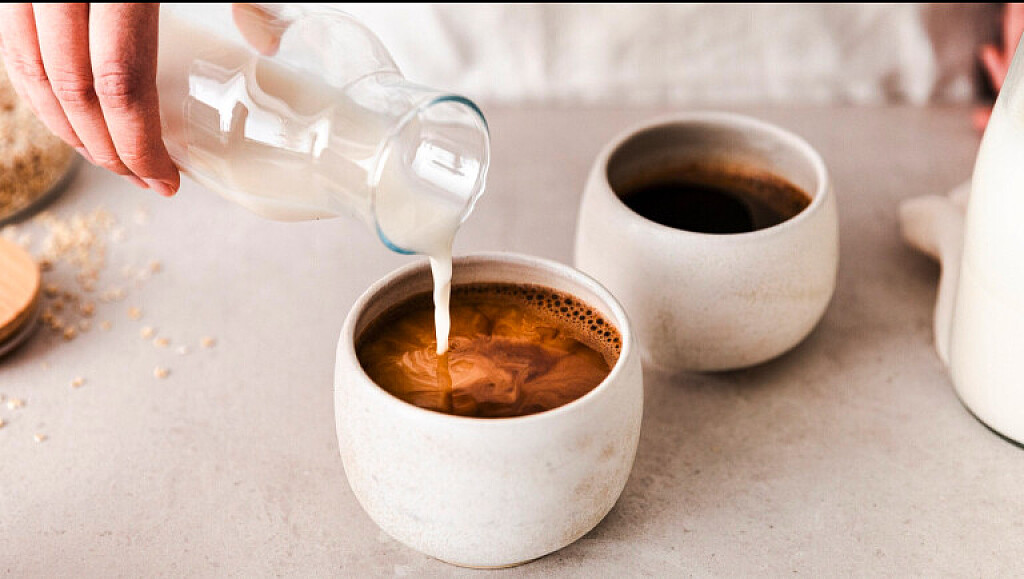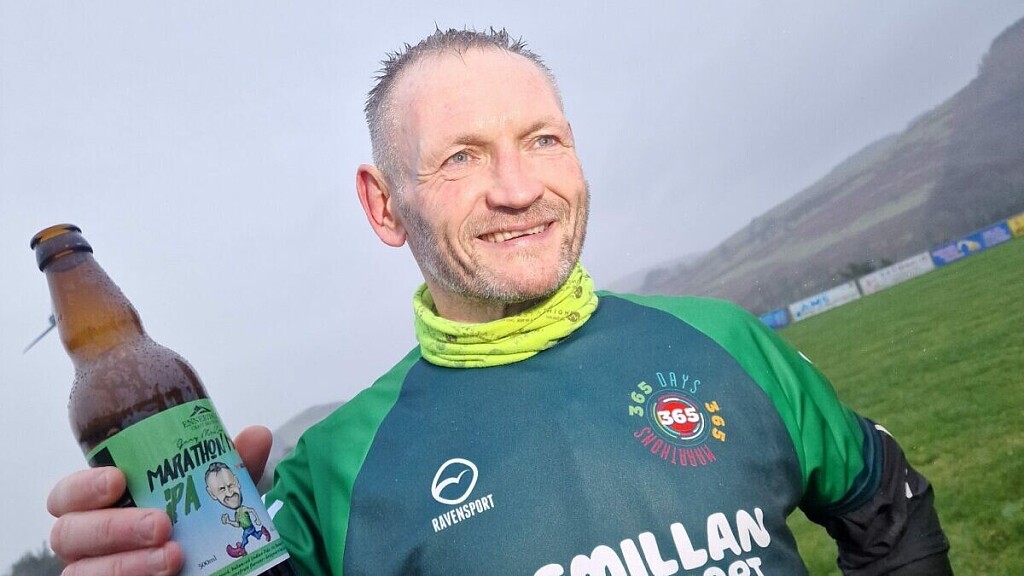Running News Daily
Running News Daily is edited by Bob Anderson in Mountain View, California USA and team in Thika Kenya, La Piedad Mexico, Bend Oregon, Chandler Arizona and Monforte da Beira Portugal. Send your news items to bob@mybestruns.com Advertising opportunities available. Over one million readers and growing. Train the Kenyan Way at KATA Running Retreat Kenya. (Kenyan Athletics Training Academy) in Thika Kenya. Opening in june 2024 KATA Running retreat Portugal. Learn more about Bob Anderson, MBR publisher and KATA director/owner, take a look at A Long Run the movie covering Bob's 50 race challenge.
Index to Daily Posts · Sign Up For Updates · Run The World Feed
Articles tagged #Cancer
Today's Running News
Terry Fox's van, prosthetic leg to be displayed at Royal British Columbia Museum
The personal belongings of Canadian running icon Terry Fox will have a new home and public display at Victoria’s Royal British Columbia Museum, with an exhibit dedicated to the late hero officially open this spring. The “All Things Terry” collection, comprising items used by Fox during his famous Marathon of Hope, include the runner’s prosthetic legs, T-shirts and the bottle of ocean water he collected in Newfoundland when he started his run. The exhibit is part of a 20-year partnership between the museum and the Terry Fox Centre Owned by the Fox family, the artifacts have been displayed in public exhibits before, but have mostly remained stored in Fox’s bedroom at his family home in Port Coquitlam.
“It is an honour to announce the preservation of iconic artifacts belonging to Canadian hero Terry Fox,” said Lana Popham, Minister of Tourism, Arts, Culture and Sport, in the original press release. “These artifacts serve as powerful reminders of Terry’s indomitable spirit and unwavering dedication to his Marathon of Hope. By safeguarding these pieces of history, we ensure that Terry’s legacy continues to inspire generations to come, encouraging perseverance, resilience, and the pursuit of helping Canadians everywhere.”
Beyond clothing items and small souvenirs gathered along his run, the collection also includes the van he and his crew slept in throughout the journey, and a large collection of letters written to Fox from school children across the country.
Fox began his cross-Canada run in 1980 in St. John’s, Newfoundland to raise money for cancer research. His daily marathons came to a halt on September 1 of that year in Thunder Bay when his bone cancer returned. Fox passed away at the age of 22.
April 12 marked 44 years since Fox set out on his Marathon of Hope.
(05/04/2024) Views: 97 ⚡AMPTyler McCandless: The Champion Returns to Conquer DICK’S Sporting Goods Pittsburgh Marathon Once More
The streets of Pittsburgh are set to witness a battle of endurance and speed as defending champion Tyler McCandless gears up to claim victory at the 2024 DICK’S Sporting Goods Pittsburgh Marathon. McCandless, who broke the finisher’s tape in 2:16:08 last year, aims to become the marathon’s first repeat American champion since 1989.
“Returning to the Pittsburgh marathon as the defending champion is an absolute honor and I’m grateful for the incredible Pittsburgh running community and P3R staff,” McCandless said. “I have had fantastic training, and I’m feeling as fit as I’ve ever been. I’m eager to run the streets of the Steel City and experience the exhilarating challenge to be champion once again.”

However, the road to triumph is not without its challengers. Alvaro Abreu, the Dominican dynamo who clinched the 2022 title with a finish of 2:16:07, is back. Familiar with the course’s rigors, Abreu is fired up to showcase his running talent and reclaim the crown.
The 2024 DICK’S Sporting Goods Pittsburgh Marathon will offer a prize purse of $32,000 with a $7,000 top prize. For more information about the 2024 DICK’S Sporting Goods Pittsburgh Marathon, visit thePittsburghMarathon.com.

About the DICK’S Sporting Goods Pittsburgh Marathon Weekend of EventsThe Pittsburgh Marathon was held annually from 1985-2003. After a five-year hiatus, the DICK’S Sporting Goods Pittsburgh Marathon was relaunched in 2009 and debuted with a sold-out field of 10,000 participants. It has grown each year since, evolving from a single race day into a weekend of events for the whole family that annually attracts nearly 40,000 runners. Read more at: ThePittsburghMarathon.com
FACEBOOK: DSGPM TWITTER: @PghMarathon INSTAGRAM: pghmarathon
About P3RP3R is the region’s go-to premier sporting event and experience expert. While best known for the annual DICK’S Sporting Goods Pittsburgh Marathon, P3R organizes up to 20 major events every year. With a rich history of working with top-tier clients such as the Pittsburgh Steelers, UPMC Hillman Cancer Center, the Pittsburgh Penguins, the National Senior Games, and more, P3R brings operational excellence to every aspect of event planning and execution. As part of P3R’s non-profit mission to inspire any and all to MOVE with us, we provide premium event experiences and robust programming – including the Run for a Reason Charity Program, award-winning Kids of STEEL program, Pittsburgh Corporate Challenge, RUN Varsity, and more – that engage everyone in the Western Pennsylvania community and beyond.
(04/27/2024) Views: 248 ⚡AMPDick's Sporting Good Pittsburgh Marathon
This race is your game - however you decide to play it. As a competitor. A fund raiser. An enthusiast. A veteran. A team player. It's whatever you want it to be. It's whatever you make it. It's YOUR game..... Run it. Play it. Own it. Love it. Runners will race on the North Shore of Pittsburgh, cross each of...
more...76 year old Jeff Aston has run every London Marathon
There are only six people who can say they have run every London Marathon and Jeff Aston is one of them.
In 1980 he spotted an advert for the event due to take place the following year and decided to go for it.
Now, four decades later, Jeff, 76, from Cardiff, is celebrating completing is 44th and has no plans on stopping.
When he was younger, Jeff enjoyed playing squash and football until the River Taff flooded the courts where he played and he started running around the playing fields.
While leafing through a magazine in 1980, he came across an advert for the first London Marathon, held the following year, and decided to go for it.
"I always wanted to run a marathon when I was a teenager," he said.
"When the first London Marathon came on to the scene, back then it was the biggest marathon in the UK."
Just six months before the event, Jeff started Les Croupiers running club in Cardiff.
Looking back on his first race, when only 7,000 people took part compared with 53,000 now, he remembers the atmosphere: "I remember it was a drizzly and windy day, with the noise of the crowds.
"By then I had run a few marathons and races so I knew what was coming. But it was the first time I had been to such a mass event at that time."
By 1983, Jeff had recorded his best time after completing the course in 2:29:31.
During the pandemic in 2020 the event was open for a select few to take part in the race where they lived.
That year, Jeff raised money for the City Hospice in memory of his late wife Val, who died in 2016 after being diagnosed with cancer.
Jeff signed up for the first London Marathon after seeing an advert in the national running magazine
An "ever-present" runner is someone who has run every London Marathon.
In 1995, organisers recognised these runners by awarding them a special commemorative medal and guaranteed acceptance for future events.
Now, there is only Jeff and five other ever presents left.
In last Sunday's race, Jeff clocked a time of 8:06:27, finishing 61st in his age category.
So why does Jeff take on the challenge every year?
"It's the challenge of the marathon distance that keeps me going. Going back every year and trying to meet your personal best.
"I'm a lot slower than what I was at my peak but I think 'what can I do to be better this year than I was last year?'
"While I still can do it, I will do it."
(04/26/2024) Views: 150 ⚡AMPby BBC
Jennifer Bigham to Headline Women’s Field at 2024 DICK’S Sporting Goods Pittsburgh Marathon
Pittsburgher Jennifer Bigham will headline the women’s field at the 2024 DICK’S Sporting Goods Pittsburgh Marathon on Sunday, May 5. Bigham, a formidable force in the local running community, has an impressive record that includes victories at the USA Masters Half Marathon Championships and the USA Masters One Mile Championships in 2022. With five wins at the City of Pittsburgh Great Race, she already has cemented her status as a local legend but is now ready to tackle 26.2 miles for the first time in PIttsburgh.
“I’ve been looking forward to running the Pittsburgh Marathon for many years, and my time has finally come,” Bigham said. “I’ve been a part of many events on marathon weekend, from the toddler trot and kids marathon, to the 5K, and half-marathon. Lining up to experience the full 26.2 in my city that I love will be very special. I know the cheers from my community on race day will power me through the tough moments. This finish line will be a special one for me!”
After taking an eight-year hiatus from competitive running post-college, she returned to the sport following the birth of her first child. Now a mother of four, Bigham’s comeback story is an inspiration to athletes and parents alike. Her remarkable comeback was highlighted by qualifying for and competing in the 2020 U.S. Olympic Marathon Team Trials.

This year she will face tough competition from Jane Bareikis, who set a marathon personal best of 2:29:00 at the Berlin Marathon last fall, and local runner Laura Harnish, who also ran in the 2020 U.S. Olympic Marathon Team Trials and holds a marathon personal best of 2:42:09.
The 2024 DICK’S Sporting Goods Pittsburgh Marathon will offer a prize purse of $32,000 with a $7,000 top prize. For more information about the 2024 DICK’S Sporting Goods Pittsburgh Marathon, visit thePittsburghMarathon.com.
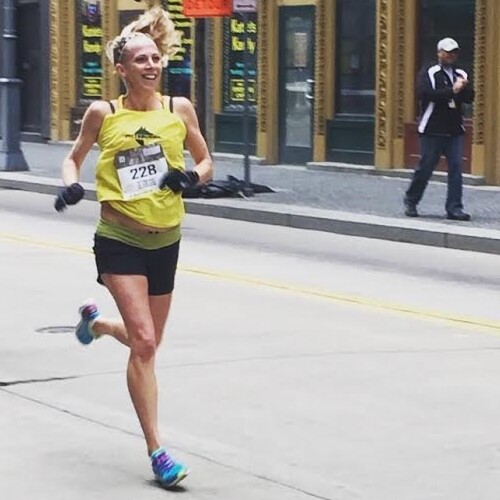
About the DICK’S Sporting Goods Pittsburgh Marathon Weekend of EventsThe Pittsburgh Marathon was held annually from 1985-2003. After a five-year hiatus, the DICK’S Sporting Goods Pittsburgh Marathon was relaunched in 2009 and debuted with a sold-out field of 10,000 participants. It has grown each year since, evolving from a single race day into a weekend of events for the whole family that annually attracts nearly 40,000 runners. Read more at: ThePittsburghMarathon.com
About P3RP3R is the region’s go-to premier sporting event and experience expert. While best known for the annual DICK’S Sporting Goods Pittsburgh Marathon, P3R organizes up to 20 major events every year. With a rich history of working with top-tier clients such as the Pittsburgh Steelers, UPMC Hillman Cancer Center, the Pittsburgh Penguins, the National Senior Games, and more, P3R brings operational excellence to every aspect of event planning and execution. As part of P3R’s non-profit mission to inspire any and all to MOVE with us, we provide premium event experiences and robust programming – including the Run for a Reason Charity Program, award-winning Kids of STEEL program, Pittsburgh Corporate Challenge, RUN Varsity, and more – that engage everyone in the Western Pennsylvania community and beyond.
(04/26/2024) Views: 148 ⚡AMPDick's Sporting Good Pittsburgh Marathon
This race is your game - however you decide to play it. As a competitor. A fund raiser. An enthusiast. A veteran. A team player. It's whatever you want it to be. It's whatever you make it. It's YOUR game..... Run it. Play it. Own it. Love it. Runners will race on the North Shore of Pittsburgh, cross each of...
more...Still running strong: Michigan woman, 73, ready for Indy Mini, her 109th half-marathon
At 73 years young, Adele Pitt is no stranger to darting through the finish line.
She's gearing up to run her 109th half-marathon in the OneAmerica 500 Festival Mini-Marathon on Saturday, May 4.

"I've run all 50 states and D.C, five continents and a couple islands," she proudly listed.
But the 13.1-mile trek that starts in the heart of downtown Indianapolis is by far her favorite.

"How many people get to run on the Indy 500 track? It's awesome!" Pitt said.
In fact, she loves the "Indy Mini" so much that she's made the trip from her home in Benton Harbor, Michigan, to run almost every year since 2004, only skipping 2018, after she was diagnosed with colon cancer. She skipped that year as she started treatment, but refused to stay down for long.
The diagnosis may have slowed her stride, but never stopped her in her tracks..
She was back the next year, not at full strength, but fully confident she'd "run the cancer away," she said.
"I had a good race that year," she said, looking at a picture from 2019. Pitt loves to look back at race day photos and is now compiling them into a scrapbook.
Now in remission, "Back and Better" seems to be one of her mottos. She's ready to lace up her running shoes, and her running dress (yes, it's a thing, she said) – as she does every year.
"I usually put on a fake tattoo and my mantra is, 'I can, I will, I am and then one foot, one foot, one foot,'" she said. "And that applies to more than just running. It's just one foot at a time, one step at a time."
Still running strong, Adele plans to tackle many more steps, miles and milestones, taking it all in full stride.
"When I got to my 100th race, there were people that were like, 'Well, are you done now?'" she said, gladly telling them, "No, we are never done! We just keep on going."
(04/24/2024) Views: 143 ⚡AMPOneAmerica 500 Festival Mini-Marathon
The mission of the 500 Festival is to produce life-enriching events and programs while celebrating the spirit and legacy of the Indianapolis 500 and fostering positive impact on the city of Indianapolis and state of Indiana. As an organization providing multiple events and programs, many of which are free to attend and impact over 500,000 people annually, our mission to...
more...New York runner receives marathon rejection email with his face on it
Getting into marathon majors like Boston and New York is hard enough, now picture the rejection email having your face on it. Well, that was the case for New York’s own Nick Parisi, as reported by NBC New York. Parisi applied for a spot in the 2024 New York City Marathon, only to receive an email with his own image giving finger guns, saying better luck next year.
When Parisi received the email on March 28, he did not expect to be the face of rejection. He also did not expect his rejection story to go viral. Almost 160,000 rejection emails went out from the New York Road Runners (NYRR), all of them with Parisi’s image on them. (But he was the only runner to see his own face.)
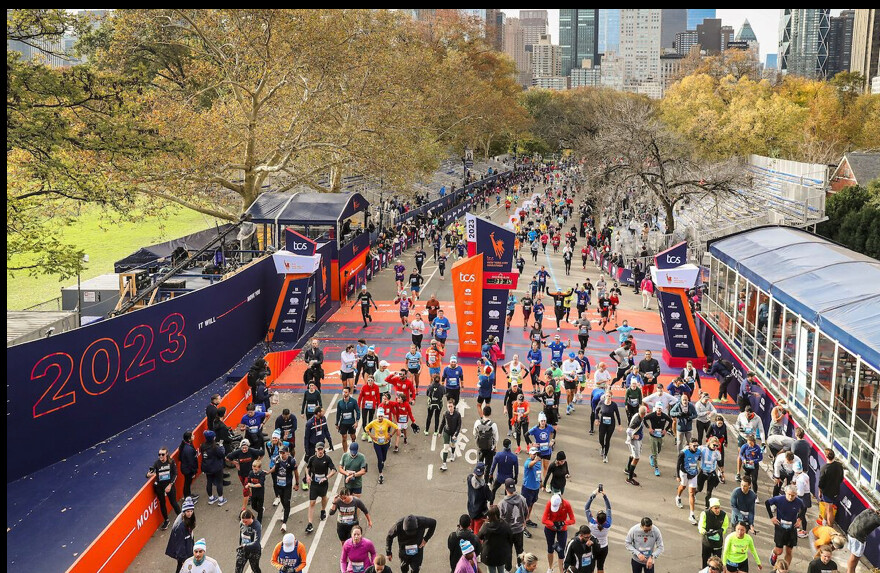
The photo generated the nickname Negative Nick online. “I did not expect to become an internet meme,” Parisi said.
The story has a happy ending for Parisi, though. The viral photo reached the NYRR marketing team, and they felt they had to make it up to him. NYRR CEO Rob Simmelkjaer showed up at Parisi’s club Front Runners NYC last week, apologizing for the mix-up and offering him a guaranteed spot at the 2024 TCS New York City Marathon start line with the bib “Positive Parisi.”
Parisi, who ran his first marathon in New York last year, is entered in his second marathon this September in Berlin. A few weeks before he races New York again this year, he will be running Berlin in honour of his mother, who passed away in 2022 from a rare form of skin cancer (mucosal melanoma). He is raising funds for Fred’s Teams and Memorial Sloan Kettering Cancer Center in New York. To go along with the apology, NYRR will match Parisi’s final donation amount. He has raised nearly USD $2,000 so far.
(04/20/2024) Views: 205 ⚡AMPby Running Magazine
Boston Marathon dog Spencer honoured with statue on race route
In a heartwarming tribute to the “official dog” of the Boston Marathon, a statue of Spencer the golden retriever was unveiled in Ashland, Mass., on the weekend, CBS News reported. Spencer’s presence along the marathon route was legendary as he stood for hours, rain or shine, to bring joy to thousands of passing runners.
The beloved furry ambassador died of cancer in 2023 after a three-year battle, with his sister, Penny, dying only days later. In a 2022 ceremony, the Boston Athletic Association (B.A.A.) named Spencer the marathon’s official dog; they unveiled a portrait of Spencer in 2023 before he died.

Spencer’s story goes beyond being a marathon spectator–he is also a symbol of resilience and compassion. From carrying the Boston Strong flag after the 2013 bombings to excelling in his role as an official therapy dog, Spencer offered encouragement to many.”We had lines of people when Spencer was with us, lines of people,” Spencer’s owner, Rich Powers, told CBS News. “Not talking like three or four people, it was like 20 people deep waiting to take a picture. They’re stopping the marathon to take a picture with Spencer, and he loved every second of it!”
The idea to immortalize Spencer with a statue came from runners and community members. After some local fundraising, sculptor Jeff Buccacio meticulously crafted a tribute that captures Spencer’s essence. Though denied a place on town property, Spencer’s statue found a home on private land, graciously offered by local residents, that overlooks the route where Spencer once stood. Powers is now training two pups, called Jimmy and Jade, to step into Spencer’s shoes and carry on his tradition along the sidelines of the race every April. “Thank you to all that helped to make this happy,” Powers said at the statue reveal. “Spencer is back on the marathon route.”
(04/07/2024) Views: 176 ⚡AMPby Running Magazine
Paula Radcliffe to open Brighton Marathon
Three-time London Marathon winner Paula Radcliffe and Paralympic gold medallist David Weir are the official starters of this year’s Brighton Marathon weekend.
Radcliffe, who set a new world record for the London marathon in 2003, will signal the start of the race in East Sussex on 7 April.

She said the start of a marathon was “inspirational” and conveyed “the warmth, empathy and power of the marathon family”.
Brighton Miles, an accessible running event on 6 April, will be launched by wheelchair athlete Weir.

About 13,000 people are expected to run in this year’s Brighton Marathon, which is now in its 15th year.
“I’m delighted to be coming back to Brighton to start the 2024 Brighton Marathon,” said Radcliffe, who is an ambassador for Children with Cancer UK.
Weir praised the inclusivity of the Brighton Miles event, saying: “No matter your age, ability or disability, the Brighton Miles is for you.”
Entries for the Brighton Miles and the 10k are still available, however the Brighton Marathon is sold out.
(03/23/2024) Views: 210 ⚡AMPby Zac Sherratt
Brighton Marathon
The Brighton Marathon is one of the UK’s favorite marathons. With stunning coastal scenery in one of the country’s most energetic cities, this is the perfect race for runners with all different levels of experience. The fast and beautiful course of the Brighton Marathon makes this a ‘must do’on any runners list. Come and experience it for yourself over 26.2...
more...Five tips from top Canadian ultrarunner Jazmine Lowther
Canadian ultrarunning star Jazmine Lowther has worked through some epic highs and challenging lows since she turned pro in 2022. Lowther took the top spot at the 2022 Canyons Endurance Runs by UTMB, followed by a fourth-place finish in the 2022 CCC race at Ultra-Trail du Mont Blanc (UTMB).
While she managed to speed to second at Transgrancanaria 128K in Spain in 2023, she has also struggled with injuries and biomechanics issues. Lowther recently shared five things she wishes she had embraced when she first dove into ultrarunning; newbies and seasoned athletes alike can learn from her wisdom and suggestions.
1.- Befriend your heart rate
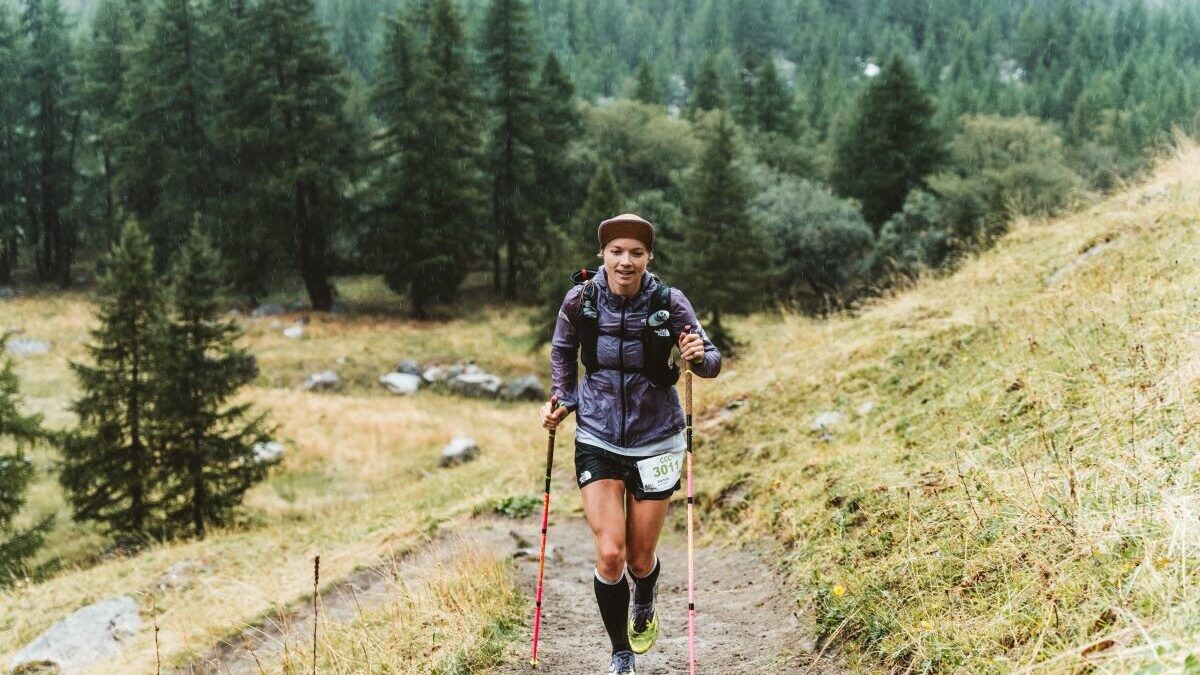
Lowther says she mostly runs by RPE (rate of perceived exertion), but adopting an approach that leans more toward heart-rate-based training has allowed her to “understand my own physiology much deeper, recover properly, and respect pacing.”
Becoming familiar with your heart rate zones can be a valuable skill, and paying attention to your performance metrics, such as pace and endurance, in relation to your zones will help you become a more responsive, tuned-in, healthy athlete. You’ll also be better able to notice if your body needs more rest and recovery time.

2.- Start a training log
While many runners count on apps like Strava to capture their running data, spending time logging more in-depth information about your training is worthwhile, as it provides unique insights over time. “Strava is great (it has most of my training),” says Lowther, “but it doesn’t include how I felt, what workouts I completed, what I ate before/after, caffeinated, fatigue, etc.”
3.- Wear sunscreen
This one is as simple as it sounds. “Protect thy skin,” says Lowther. “Ultrarunning takes you out there for mega-long hours! Slather up!” While most of us know that prolonged sun exposure during outdoor running can increase the risk of skin damage, including sunburn, premature aging and an elevated risk of skin cancer, it can be easy to forget to reapply after hours on the trails. Wearing sunscreen helps to create a protective barrier, reducing the absorption of UV rays and minimizing the potential harm to the skin, and, as Lowther notes, is an essential precautionary measure (in all kinds of weather) for maintaining skin health.
4.- Find your baseline
Lowther suggests integrating benchmark training runs into your routine to establish an initial baseline. The process involves finishing a predetermined course or distance to use as a reference tool and provides a basis for assessing your performance and comparing it to others in terms of time, pace, or other relevant metrics. “I suppose I’ve done this in an unstructured way (Strava segments anyone?) but seriously, repeating workouts in the same location/distance is great for checking in on things,” she says.
5.- Have patience in the process
Focus on consistency and long-term goals and gains. Consider each run and workout as an investment in your fitness and training bank, even if it didn’t go exactly as planned. “One day at a time, year over year,” says Lowther. “Consistency, is that you?”
(02/08/2024) Views: 294 ⚡AMPby Keeley Milne
Four runners share their mental health stories
Many runners find their sport is not only a way to gain physical resilience, but also a powerful ally in the path toward mental well-being. The road to mental health isn’t solitary, and witnessing others share their challenges and successes can be uplifting and inspiring.
From pros to amateurs, athletes are speaking out about their struggles and triumphs with mental health. Here are four runners to follow who are also mental health advocates.
1.- Alexi Pappas

Pappas is known for being a remarkable athlete (she ran the 10,000m for Greece at the 2016 Olympics in Rio de Janeiro), but she also boasts credentials as a renowned author, filmmaker, and mental health advocate. Pappas opened up about mental health in 2020: after working toward and achieving her Olympic dreams, her mental health spiralled, and she was eventually diagnosed with severe clinical depression, which was compounded by injuries, a lack of sleep and her own reluctance to take a break from training.
Pappas authored her first book in 2021: Bravey: Chasing Dreams, Befriending Pain, and Other Big Ideas, highlighting her triumphs and challenges in sports and life, and encouraging readers to be “braveys” in pursuing their passions. She continues to advocate and be a source of hope to others on social media.”What if we athletes approached our mental health the same way we approach our physical health?” Pappas asks.

Former American steeplechaser turned elite trail runner, Ostrander uses her Instagram platform to share mental health and eating disorder awareness and advocacy.
In 2021, Ostrander returned to professional competition after being sidelined with multiple injuries for the previous 18 months. During this time, she was hospitalized for treatment of an eating disorder. Ostrander qualified for the U.S. Olympic Trials, where she ran a personal best of 9:26.96 in the 3,000m steeplechase, before deciding to take a year-long break from professional running to prioritize her own mental health.
Ostrander returned to racing in 2023, and made a shift to the trails, running to ninth place at the Mammoth 26K in California in September.
3.- Evan Birch
Canadian ultrarunner and mental health advocate Evan Birch shares an unflinching look at his mental health journey on social media as he works to destigmatize the conversation around mental wellness. Birch is a former 911 dispatcher from Calgary who has been running on trails for more than a decade, and who most recently conquered Western Canada’s first 200-mile race, The Divide 200, in September 2023.
A busy father to young children, Birch recently collaborated with filmmaker Dylan Leeder to create Running Forward, a documentary illuminating the intersection between running and mental health.”It is more important to me now that I meet the truth within me, than it is to make other people comfortable with how I am,” Birch says on social media. “The gifts I have received from allowing myself to be sad are so plentiful.”
4.- Denoja Uthayakumar
From Scarborough, Ont., Uthayakumar is no stranger to hardship, but she has taken her experiences and built a social platform where she can advocate for individuals from similar backgrounds. Uthayakmar is a cancer survivor, body positivity and mental health advocate and was Canadian Running’s pick for our 2023 Community Builder of the Year award.
Uthayakumar was born into a Tamil family, and was diagnosed with thyroid cancer at age five; she shares her physical and mental health challenges alongside the joy that running and the community around it bring to her. “This year pushed me. It broke me down. It challenged me to no end,” Uthayakumar says on Instagram. “It was hard, but I rose higher with my running journey, and was able to share more of my story during my healing while being a survivor.”
(01/31/2024) Views: 284 ⚡AMPby Keeley Milne
The Mysterious Case of the Asthmatic Olympians
You won’t freeze your lungs exercising outdoors this winter, but there are reasons to be cautious about inhaling extremely cold air
When an athlete reaches the podium despite a prior medical event—a cancer diagnosis, say, or a car accident—we consider it a triumph of the human spirit. When a bunch of athletes do so, and all of them have suffered the same setback, we can be forgiven for wondering what’s going on. According to the International Olympic Committee, roughly one in five competitive athletes suffers from exercise-induced bronchoconstriction, or EIB, an asthma-like narrowing of the airways triggered by strenuous exercise. The numbers are even higher in endurance and winter sports. Puzzlingly, studies have found that athletes with EIB who somehow make it to the Olympics are more likely to medal. What’s so great about wheezing, chest tightness, and breathlessness?

The answer isn’t what you’re thinking. Sure, it’s possible that some athletes get a boost because an EIB diagnosis allows them to use otherwise-banned asthma medications. But there’s a simpler explanation: breathing high volumes of cold or polluted air dries out the airways, leading to an overzealous immune response and potential long-term damage. “It’s well established that high training loads and ventilatory work increase the degree of airway hyper-responsiveness and hence development of asthma and EIB,” explains Morten Hostrup, a sports scientist at the University of Copenhagen and lead author of a new review on EIB in the Scandinavian Journal of Medicine and Science in Sports. In other words, the athletes who train hard enough to podium are more likely to develop EIB as a result.
That trade-off might be worthwhile if it means competing at the Olympics. For those of us who simply enjoy spending our winter days vigorously exploring the outdoors, the risk of EIB remains mostly unknown territory. Activities with the highest risk involve sustained efforts of at least five minutes, particularly if they take place in cold or polluted air. Cold air doesn’t hold much moisture, so it dries the airways. This affects skiers, runners, and triathletes, among others. Indoor environments like pools and ice rinks are also a problem, because of the chloramines produced by pool water and exhaust from Zambonis. As a result, swimmers, ice skaters, and hockey players are also at elevated risk of EIB. Over time, repeated attacks can damage the cells that line the airways.
Unfortunately, many athletes develop symptoms of EIB without realizing the underlying problem. After all, the feeling that you can’t catch your breath is pretty much written into the job description of most endurance activities. But starting in the 1990s, sports scientists began to suspect that top athletes had more breathing problems than would be expected. Before the 1998 Winter Games, U.S. Olympic Committee physiologists examined Nagano-bound athletes to see whose airways showed abnormal constriction in response to arduous exercise. Almost a quarter of the athletes tested positive, including half the cross-country ski team.
One reason EIB often flies under the radar is that the usual diagnostic workups aren’t challenging enough to provoke an attack in conditioned athletes. Among the accusations against disgraced coach Alberto Salazar was that he showed athletes how to fool EIB tests to get permission to use asthma meds. “He had a specific protocol,” star 5,000-meter runner Lauren Fleshman told ProPublica in 2015. “You would go to the local track and run around the track, work yourself up to having an asthma attack, and then run down the street, up 12 flights of stairs to the office and they would be waiting to test you.” Salazar certainly gave some shady advice, including encouraging Fleshman to push for the highest possible dosage of medication. But his tips for gaming the asthma test were similar to what USOC physiologists advocate, and an IOC consensus statement published last spring also concluded that more intense exercise challenges are better for diagnosing EIB in conditioned athletes. If you’re really fit, in other words, the rinky-dink treadmill in the doctor’s office isn’t going to push you hard enough.
If you do get an EIB diagnosis, your doctor can prescribe asthma medication, including inhaled corticosteroids like fluticasone and airway dilators like salbutamol. If you’re an elite athlete subject to drug testing, you’ll need to tread carefully, since some of those medications are either banned or restricted to a maximum dosage. Hostrup and his colleagues note that there’s also evidence that fish oils high in omega-3 fatty acids, vitamin C, and even caffeine might help reduce EIB symptoms. And on the non-pharmaceutical side, you can minimize the chance of an attack by doing a thorough warm-up of 20 to 30 minutes, including six to eight 30-second sprints. This can temporarily deplete the inflammatory cells that would otherwise trigger an airway-narrowing attack.
The best outcome of all, of course, is to avoid developing the problem in the first place. In 2008, I interviewed a Canadian military scientist named Michel Ducharme, who told me stories of cross-country skiers swallowing Vaseline in an attempt to protect their airways from the cold. This is a terrible idea on many levels—and, he assured me, totally unnecessary. Air warms up very quickly when you inhale it, so there’s no risk of freezing your throat tissue. But dryness is another question, and scientists have reconsidered whether some kind of protection—just not Vaseline—could be useful if you’re going hard on cold days.
One option is a heat-and-moisture-exchange mask, which warms and moistens the air you inhale. A company called AirTrim makes them with a range of levels of resistance for training or racing. Several studies have found that this type of mask seems to reduce EIB attacks. Research by Michael Kennedy at the University of Alberta found that EIB risk increases significantly when temperatures drop below about five degrees Fahrenheit. The precise threshold depends on conditions and individual susceptibility, so if you start coughing or wheezing, that’s a sign your airways are irritated. If you don’t have a breathing mask, a scarf or a Buff over your mouth can offer a temporary solution.
Don’t take all this as a warning against getting outdoors in the winter. I live in Canada, so staying inside when it’s below five degrees Fahrenheit would be a death sentence. But I’m no longer as macho about the cold as I used to be. I wear puffy mittens and merino base layers, and when my snot starts to freeze I cover my mouth and nose. Athletes with EIB may do better than their unimpaired peers at the Olympics, but that’s one edge I can do without.
(12/03/2023) Views: 439 ⚡AMPby Outside Online
Short runs have major health benefits, research says
There’s a consensus that running has positive effects on our physical and mental health, but how many miles do runners need to log before they reap rewards? Most people know those who exercise have less risk for heart disease, cancer and diabetes and tend to live longer, and it’s a commonly held belief that the more time spent pounding the pavement, the greater the benefits. Recent research suggests we don’t actually need to run very much to reap the rewards, The New York Times recently reported.
Longer doesn’t mean better

There’s a growing body of evidence that correlates even much shorter running sessions to significant health benefits, especially those regarding longevity and mental health. Dr. James H. O’Keefe, director of preventive cardiology at St. Luke’s Mid-America Heart Institute in Kansas City, Mo., says that going for a two-mile (3.2 km) run several times a week seems to give people the full benefit of running, in terms of longevity, specifically.
O’Keefe and his colleagues have published multiple studies on running for health and longevity. In one study, he analyzed long-term health and exercise data gathered from 5,000 adults ranging in age from 20 to 92. People who ran between one and two and a half hours per week at a slow or moderate pace seem to have the biggest boost in longevity–even greater than in runners who run more, faster.
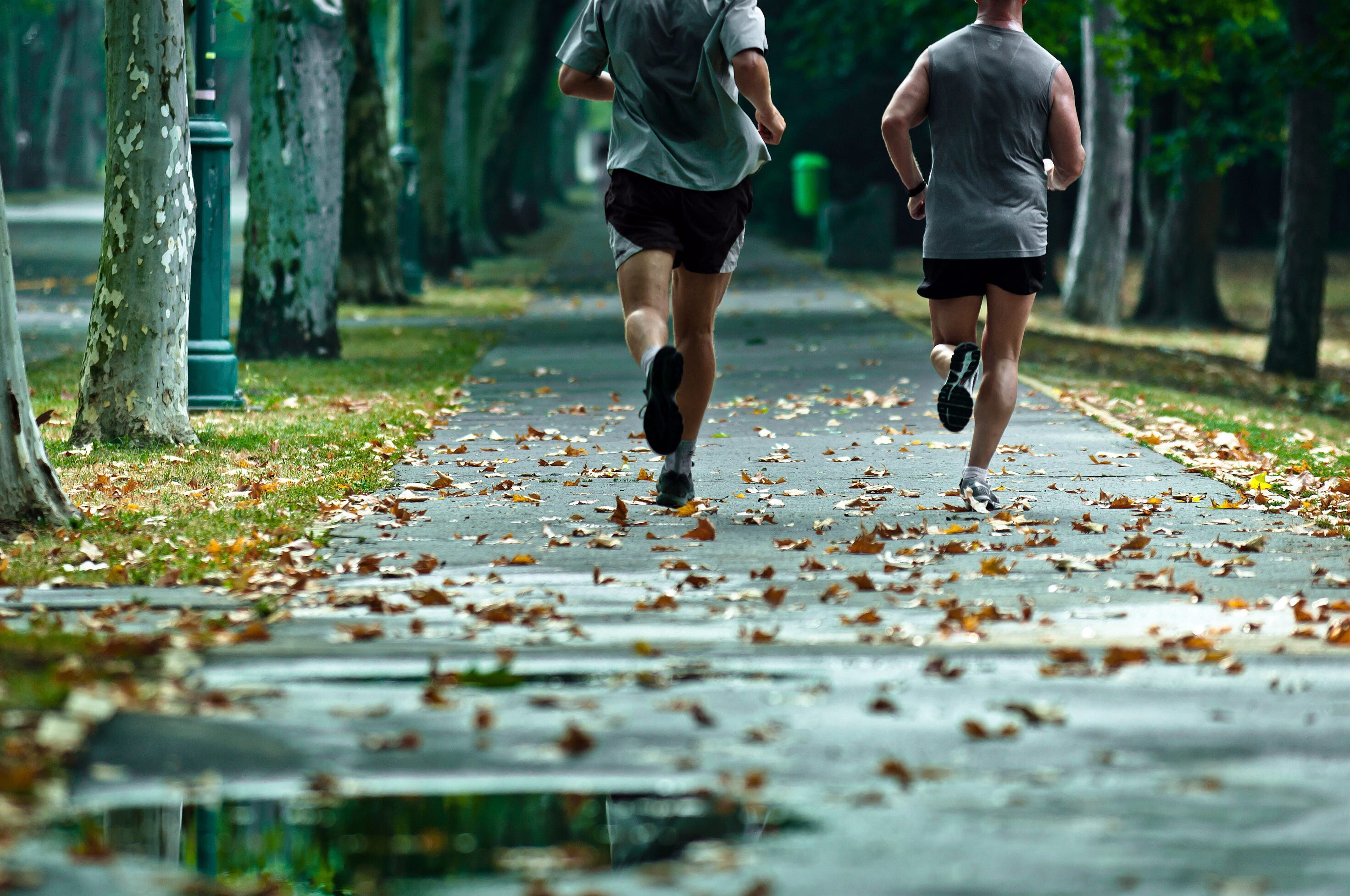
Less time training still boosts mental health
Exercise makes us feel better, but more exercise doesn’t necessarily mean more mental health benefits. A recent research review on exercise and depression reported that adults who managed to exercise for the two-and-a-half hours of physical activity per week recommended by most guidelines gained a 25 per cent lower risk of depression when compared to non-exercisers.
Can’t manage to meet the recommended guidelines? Those who completed only half of the recommended two-and-a-half weekly hours still benefited from an 18 per cent lower risk of depression compared to non-exercisers.
“The growing consensus in the field is that the benefits of running start to accrue within minutes,” said Dr. Rajesh Vedanthan, an associate professor of population health at New York University’s Grossman School of Medicine.
If you’re a newer runner easing into regular exercise, or simply can’t fit in longer running sessions, don’t stress: you’re still adding years to your life, reducing your risk of many diseases and bolstering your mental health.
(11/29/2023) Views: 350 ⚡AMPby Keeley Milne
Track and Field Historian Mike Fanelli Dies of Cancer at 67
Mike Fanelli, the owner of one of the largest track and field memorabilia collections in the United States, died on Saturday after a battle with glioblastoma, an aggressive form of brain cancer. He was 67 years old.
For over 50 years, Fanelli collected running-related memorabilia, which he stored in the “Track and Field Garage” at his home in Sonoma County, California. The expansive collection features over 4,000 artifacts, including the meet program from the first indoor track meet held in the United States in 1868, as well as every issue of Track and Field News and Runner’s World.

Fanelli made his mark on the sport of track and field throughout his life. He represented athletes as an agent, coached the Impala Racing Team, and served as the USATF National Cross-Country chairman in the 1990s. He’s also the namesake for the Mike Fanelli Track Classic, held at his alma mater, San Francisco State University, each spring.
But Fanelli’s impact, perhaps, is best exemplified by the connections and friends he made along the way. Until just days ago, Fanelli would routinely post track and field trivia facts to an audience of over 4,000 Facebook friends. If you look closely, you’ll find legends of the sport reminiscing about old races or giving their two cents in the comments.
Fanelli’s wife, Renay Weissberger Fanelli, released a statement on Monday announcing his passing: “It is with unbearable sadness that I share with you that Michael has passed away from brain cancer, at home, surrounded by loved ones. While he was a public figure in many ways, he was also a very private person. Because of that, he chose not to share his diagnosis broadly, preferring to live his life as if he was living, not dying.”

Fanelli lived his life fully up until his last moments. Last month, he completed his goal of running 115,000 miles in his life, dutifully logging each run in composition notebooks.
In 2021, Fanelli told Runner’s World why he feels cataloging running history, with the help of his track-nerd friends, is so important. Running history, he noted, is not particularly well recorded.
“I refer to it as ‘cultural storytelling,’” he said. “When a particular culture wants to pass down their history over the years, and it’s not something that can be transcribed otherwise, this is our opportunity to do that.”
(11/28/2023) Views: 389 ⚡AMPby Runner’s World
Ethiopians sweep women's B.A.A. Half Marathon, Kenyan wins men's race
The 2023 B.A.A. Half Marathon presented by Dana-Farber Cancer Institute and the Jimmy Fund took place today, November 12, starting and finishing within Boston’s Franklin Park. Personal bests and fast times were achieved on a chilly fall day. Preliminary results can be found here.
In the professional open divisions, Fotyen Tesfay (Ethiopia) and Abel Kipchumba(Kenya) took home the women’s and men’s titles respectively, while Jenna Fesemyer and Hermin Garic, both of the USA, captured the wheelchair division victories. American Paralympian Liz Willisset a world record in the T61-64 division (lower limb impairment) in a time of 1:45:19. Among today’s finishers were more than 600 athletes representing the Dana-Farber Cancer Institute and Jimmy Fund, raising more than $700,000 to defy cancer.
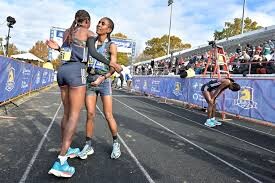
Warming up through the early miles, Tesfay and a sizeable lead pack passed 5 miles in 27:10 and 10 miles in 53:17. The race began to intensify as Tesfay, American record holder Keira D’Amato, B.A.A. 5K champion Senbere Teferi, and World Cross Country Championships silver medalist Tsigie Gebreselama covered the hilly course along Boston’s Emerald Necklace Park System.
While it was a pack with 5K to go, Tesfay was all alone entering White Stadium, breaking the tape in 1:08:46. In her Boston debut, Tesfay not only conquered the competition but also the cold temperatures.
“The pack was so big, but I managed to move ahead of them as I got close to the finish to take the win,” said Tesfay. “This is my first time running a half marathon in Boston and the coldest race I have ever run, so I am very happy to win.”
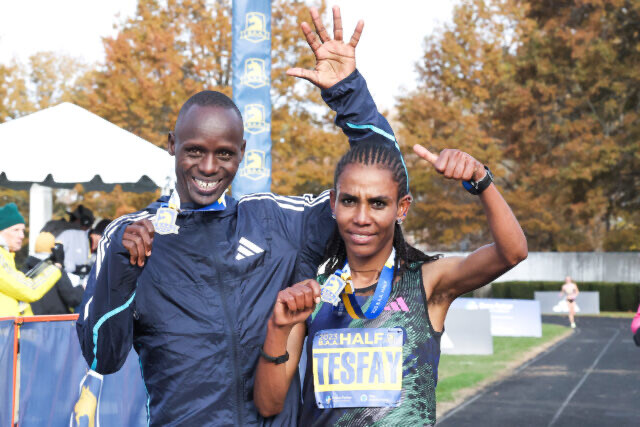
Teferi (ETH) and Gebreselama (ETH) rounded out the podium in 1:09:00 and 1:09:06, followed by D’Amato as the top American in 1:09:12.
In the men’s race, Kipchumba was determined to improve upon a ninth place finish a year ago. Running with Australian Olympian Pat Tiernan and defending champion Geoffrey Koech (Kenya) through five miles, Kipchumba began to break away little by little. At six miles it was a seven second lead, then at 10 miles the gap stood 30 seconds.
Kipchumba’s broke the tape all smiles in 1:01:32 with a hard-charging Tiernan second (1:01:56) and Yemane Haileselassie third in 1:02:17. Sam Chelanga, who won a silver medal in the 10,000m at the Pan Am Games on the track last week, was top American, seventh in 1:02:49.
“Today was difficult because it was very cold. And as we know, Boston has a lot of hills. But I managed to win the race, so I am happy,” said Kipchumba. “I like the crowds. They cheered me and I got a lot of energy to push the pace.”
(11/12/2023) Views: 414 ⚡AMPB.A.A. Half Marathon
Dana-Farber and the Jimmy Fund have partnered with the B.A.A. in the Half Marathon for 13 years as the race’s presenting sponsor. Through this relationship, team members have collectively raised more than $5 million to support groundbreaking cancer research, and enabled Dana-Farber scientists and clinicians to positively impact the lives of cancer patients around the world. Dana-Farber runners often participate...
more...Running may boost inflammation-fighting cells that enhance performance, study finds
A new study reported in The Harvard Gazette has shed more light on how exercise helps the body boost its ability to fight inflammation, which in turn improves performance.
The study, done in mice, suggests the possible role of the exercise in both reducing inflammation and improving performance. Exercise triggers natural inflammation, and our bodies counter the inflammation using something called T-cells or Tregs, which also seem to enhance our ability to use energy as fuel and improve our physical endurance.
The study

Inflammation is the body’s natural response to injury or infection, but prolonged or chronic inflammation can contribute to the development of heart disease, cancer and autoimmune conditions. Exercise causes temporary damage to the muscles and unleashes an inflammatory response–and this not only helps our bodies become stronger at fighting inflammation in general, but also may help us become faster and stronger athletes.
A team at Harvard Medical School analyzed what happens in cells that were taken from the hind leg muscles of mice that ran on treadmills. The team then compared them with muscle cells obtained from sedentary mice.

The muscle cells of the mice that ran on treadmills showed signs of inflammation and elevated levels of the inflammation-fighting T-cells or Tregs. Researchers discovered that not only did the Tregs lower exercise-induced inflammation, but they also were responsible for the broader benefits seen in regular exercises.
The animals who didn’t exercise still experienced muscle inflammation, but it was not combated by Tregs. Their muscle cells also had swollen mitochondria (a sign of metabolic abnormality). The animals lacking Tregs did not experience the same whole-body benefits from exercise, and had diminished aerobic capacity.
The takeaway
Exercise not only helps our bodies become better able to fight off inflammation, but the inflammation-response cycle that exercise generates may also help build muscular endurance.
“Our research suggests that with exercise, we have a natural way to boost the body’s immune responses to reduce inflammation,” said Diane Mathis, professor of immunology in the Blavatnik Institute at Harvard. “The immune system, and the Tregs cell arm in particular, has a broad impact on tissue health that goes beyond protection against pathogens and controlling cancer. Our study demonstrates that the immune system exerts powerful effects inside the muscle during exercise.”
While research on humans is needed, this research is an important step in understanding how, exactly, exercise makes us healthier. “Mice are not people,” researchers explained, “and the findings remain to be replicated in further studies. However, the study is an important step toward detailing the cellular and molecular changes that occur during exercise and confer health benefits.”
(11/08/2023) Views: 356 ⚡AMPby Keeley Milne
Foot Pain When You’re Running? This Issue May Be to Blame
These mysterious bumps can cause discomfort and pain, but prevention and early treatment can help you stick to your training schedule.
Picture this: You’re blissfully clocking your miles on a Saturday morning until you feel a small but growing pressure on top of your foot. It’s slight, so you ignore it, but over time that discomfort starts to become more noticeable—and once you take your running shoes off at home, you notice a bulb-like bump on your foot.

What gives? You could have what’s known as a ganglion cyst. These sometimes painful bumps aren’t often talked about in the running community, but they’re one of the most common soft tissue masses found in the foot and ankle, per a 2023 review in the Journal of Clinical Orthopaedics and Trauma. Plus, they can derail your training if not addressed.
Here’s everything you need to know about ganglion cysts as a runner, including how to prevent and treat them.
How might a ganglion cyst show up in runners?
A ganglion cyst develops slowly over weeks or months, but it may grab your attention during a run.
“There will be some soreness associated with a ganglion during a run due to shoe pressure against it,” says Karen A. Langone, D.P.M., a Southampton, New York-based spokesperson for the American Podiatric Medical Association and podiatrist who specializes in sports and fitness medicine. “You might notice a lump on the foot, which can worsen during the run.”
That lump on your foot can be easy to confuse with a number of other conditions. Found along a tendon or near a tendon, a ganglion cyst can be mistaken for an exostosis, for example, which is a benign (noncancerous) bone tumor, per the Cleveland Clinic.
“It might also be confused with a stress fracture of a metatarsal bone,” says Alex Kor, D.P.M., a spokesperson for the American Podiatric Medical Association, a podiatrist at Hendricks Regional Health in Danville, Indiana and team podiatrist for the athletic programs at Butler University. A metatarsal stress fracture is a break in the bone from repeated injury or stress, which can be caused by running.
What is a ganglion cyst?
On the other hand, ganglion cysts are noncancerous bumps that usually appear along your tendons or the joints of the wrists or hands, but they can also occur in ankles and feet, according to the Mayo Clinic. They’re filled with a jellylike fluid.
“A ganglion cyst, like any mass, makes the runner’s foot feel tight,” says Kor. “The pain can be characterized as dull or sharp if mileage is extended or there is increased shoe pressure.”
This cyst is usually caused by a bony point that’s exacerbated by shoe pressure (and possibly by your foot swelling at the end of a run), a tendon that gets overused (which may be the result of tendonitis), or from acute trauma. The fluid in the tendon sheath can “leak out” after overuse or trauma to form the ganglion cyst, adds Kor.
Once one of these things occurs, the inflammation within the tendon sheath accumulates in one area and worsens, forming the ganglion cyst.
Although they’re filled with fluid, they can feel firm to the touch, per Yale Medicine. They can be as small as a pea or as large as an inch in diameter. Sometimes, they can affect joint movement and cause pain if they press against a nerve.
The majority of ganglion cysts occur on the top of the foot or the front of your ankle, says Kor. They are rare on the bottom of the foot.
Risk factors for these cysts include sex and age (most often, ganglion cysts occur in women between the ages of 20 and 40) and osteoarthritis (particularly when they occur in the hands), per the Mayo Clinic.
Should you run with a cyst?
You can continue to run with a ganglion cyst, especially if there is no pain. Even if there is some pain, your level of discomfort will determine the best steps for treatment.
“This is not a condition that will significantly worsen [if you run on it],” says Kor. “In other words, it is not like a stress fracture that can ‘break’ to the point that surgery is needed.”
However, it’s important to check with a doctor to make sure the bump is a ganglion cyst and not something more serious, and to determine ways to avoid discomfort.
Being a runner alone does not increase your risk of ganglion cysts, but your foot shape may play a role. “They are a little more common in very high arched feet and very flat feet,” says Kor.
How can runners treat ganglion cysts?
First, visit your doctor, who may conduct imaging tests like an X-ray and ultrasound to confirm that it is a ganglion cyst (and not something else).
Once the bump has been identified as a ganglion cyst, there are a few treatment options, starting with these less invasive methods:
Padding
This can be placed around (not on) the ganglion cyst to avoid pressure from a running shoe. “A pad or blister bandage directly over the ganglion cyst may worsen the pain,” says Kor. “Typically, a horseshoe pad or donut pad is applied to offload the cyst.”
Icing
You can also ice your foot after a run and on a daily basis for 20 to 30 minutes. Place a towel between your foot and the ice pack to avoid skin irritation. “Ice can cause vasoconstriction to reduce inflammation, swelling, and pain,” says Kor.
Changing Shoes
A supportive shoe has the potential to reduce overuse, which may help in the initial stages of a ganglion cyst, says Kor. A supportive shoe should not bend at the sole (typically, this has nothing to do with the brand name or price of the shoe).
Taking Breaks from Footwear
When you’re not running, avoid shoes that exacerbate the ganglion cyst area. For instance, skip the one-strap sandal that directly rubs the cyst area. Unsupportive footwear, like flip-flops with a flexible sole, can also worsen the cyst.
Adjusting Your Shoe Laces
If the ganglion is on the top of the foot, your shoelace pattern can be changed to avoid direct pressure on the ganglion. For instance, your podiatrist might recommend a lacing pattern often used for patients with high instep (the bony structure on top of your foot).
In this case, cross your laces as usual toward the bottom of the tongue, skip crossing them over in the middle (and instead create a line along each side of the tongue), then finish lacing near the top of the tongue. This offloads the top of the foot that may be affected by the cyst. See an example of how to do it here.
Take Anti-Inflammatory Medication
If approved by your doctor, you can take over-the-counter anti-inflammatory medications to ease the discomfort of a ganglion cyst.
If you’re in pain, it’s worth speaking with your doctor about longer-term solutions for treating the cysts. Kor notes that many runners may see little to no improvement with these conservative options.
If these steps don’t help, your podiatrist might suggest an in-office procedure in which the fluid is withdrawn and sometimes injected with a small amount of cortisone to shrink the remaining cyst—or complete surgical removal of the cyst.
Even surgery isn’t a magic bullet: The recurrence of ganglion cysts after surgical removal ranges from 4 to 40 percent, according to a 2021 study in The Archives of Bone and Joint Surgery.
Clearly, it’s important to speak with your doctor transparently about your pain levels to determine the pros and cons of each treatment. Fifty percent of the time, ganglion cysts resolve on their own, according to a historic study in Current Reviews in Musculoskeletal Medicine.
How can runners prevent ganglion cysts?
Some of the methods described above for treating an early-stage cyst can also be used to prevent one in the first place, starting with your running shoe.
“Ganglions are often found over areas where the bone is prominent and there is aggravation from shoe pressure,” says Langone. “A well-fitting running shoe is an important part of avoiding ganglions, as is altering lacing patterns to avoid painful pressure.”
If your doctor has already aspirated your ganglion cyst and you want to prevent recurrence, a well-fitting shoe and altering lacing patterns may still help—along with icing after runs.
“Over-the-counter or custom-made orthotics can also indirectly help with a ganglion cyst,” says Kor. “There is some indication that increasing support within the shoe can reduce the overuse on a tendon, which may in turn reduce the irritation that contributes to a cyst.”
Your podiatrist can prescribe custom orthotics based on your foot’s specific shape. That said, if a ganglion cyst is already significantly symptomatic, an over-the-counter orthotic will typically not help.
As with most things, prevention and early detection are key. If you start to notice discomfort or an unusual bump, make an appointment with your doctor to discuss treatment options—so you can get back to pain-free miles.
(10/29/2023) Views: 331 ⚡AMPby Runner’s World
Defending Champions, American Record Holders & Global Stars Highlight 2023 B.A.A. Half Marathon Professional Field
The Boston Athletic Association (B.A.A.) announced today a star-studded professional field for the 2023 B.A.A. Half Marathon presented by Dana-Farber Cancer Institute and the Jimmy Fund. Defending champions Viola Chepngeno, Geoffrey Koech, and Jenna Fesemyer all return, while American half marathon record holder Keira D’Amato will take on the challenging course for the first time on Sunday, November 12. The B.A.A. Half Marathon starts and finishes at Franklin Park and runs along the Emerald Necklace Park System.
“As one of the most competitive half marathons in the country, we’re eager to bring many of the best open, wheelchair, and Para athletes in the world to Boston for November’s B.A.A. Half Marathon presented by Dana-Farber Cancer Institute and the Jimmy Fund,” said Jack Fleming, President and CEO of the B.A.A. “Nearly 9,000 athletes will take to the roads, led by some of the fastest and most decorated competitors in event history.”

In 2022, Chepngeno (Kenya), Koech (Kenya), and Fesemyer (USA) won the women’s open, men’s open, and women’s wheelchair divisions, respectively, while Marko Cheseto and Jacky Hunt-Broersma (both USA) persevered through rain to finish atop the podium in the Para Athletics Division. To repeat the feat, all will square off against a field that includes national record holders and global medalists.
Senbere Teferi of Ethiopia, the 2022 B.A.A. 5K champion and three-time world championships medalist, looks to continue her winning ways in Boston. She’ll battle Tokyo Marathon champion Rosemary Wanjiru, 2019 B.A.A. 10K winner Fancy Chamutai, world cross country silver medalist Tsigie Gebreselama, last year’s runner-up Bosena Mulatie, and two-time B.A.A. Half Marathon second place finisher Cynthia Limo.
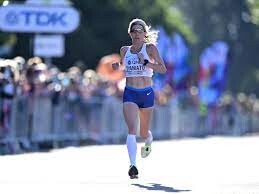
Four Americans who competed at the World Athletics Championships in Budapest in August will toe the line, including D’Amato, Lindsay Flanagan, Susanna Sullivan, and Natosha Rodgers. D’Amato set the national half marathon record of 1:06:39 at this year’s Gold Coast Half Marathon in Australia, and along with Flanagan and Sullivan made up Team USA at the World Championships Marathon. Rodgers raced the 5,000m and 10,000m on the track in Budapest, finishing 14th in the latter event. Rachel Schneider Smith, a 2021 Olympian at 5,000m for Team USA, will be making her B.A.A. Half Marathon debut.
Ten men with sub-61 minute personal bests will line up for the B.A.A. Half Marathon. Abel Kipchumba owns the fastest lifetime best in the field (58:07), while Shadrack Kimining of Kenya, second fastest in the field, placed fifth in 2022. Mohamed El Aaraby (Morocco), Yemane Haileselassie (Eritrea), Pat Tiernan (Australia), and Amanuel Mesel (Eritrea) bring international expertise. The fastest American men’s entrants are Nadir Yusuf (1:03:23), Kevin Koski (1:03:35) and Ryan Cutter (1:03:54) and sub-2:10 marathoner Ian Butler.
Dedham, Mass.-native Brian Reynolds, who set a world record at last year’s B.A.A. Half Marathon in the T62 (lower-limb impairment) category, returns, as does Marko Cheseto (T62) who ran 1:24:54 in 2022. Jacky Hunt-Broersma, last year’s women’s T62 champion, and Liz Willis, a three-time Boston Marathon T62 winner, will compete as well.
In the wheelchair division, Fesemyer set a course record 59:50 in 2022 to become the first women’s wheelchair athlete ever to break one hour in race history. Fellow 2022 women’s wheelchair podium finishers Yen Hoang (second place) and Michelle Wheeler (third) return as well.
James Senbeta and Hermin Garic, veterans of many B.A.A. events, headline the men’s wheelchair field. Garic was victorious at this year’s B.A.A. 10K.
The B.A.A. Half Marathon course runs along the picturesque Emerald Necklace Park System, past landmarks such as the Arnold Arboretum, Jamaica Pond, and Franklin Park Zoo, before finishing at White Stadium in Franklin Park. The B.A.A. Half Marathon is a family-friendly event for athletes and spectators of all ages. Free youth events will be offered on race morning within Franklin Park, including races and medals for all.
Dana-Farber Cancer Institute and the Jimmy Fund has partnered with the B.A.A. Half Marathon since 2003 as the race’s presenting sponsor and exclusive charity team. Through this relationship, Dana-Farber runners have collectively raised more than $8 million to support groundbreaking cancer research, and enabled Dana-Farber scientists and clinicians to positively impact the lives of cancer patients around the world. In advance of the 2023 event, 640 Team Dana-Farber athletes have raised $375,000 to date.
(10/18/2023) Views: 421 ⚡AMPB.A.A. Half Marathon
Dana-Farber and the Jimmy Fund have partnered with the B.A.A. in the Half Marathon for 13 years as the race’s presenting sponsor. Through this relationship, team members have collectively raised more than $5 million to support groundbreaking cancer research, and enabled Dana-Farber scientists and clinicians to positively impact the lives of cancer patients around the world. Dana-Farber runners often participate...
more...St. Paul firefighters tackling the Twin Cities Marathon in full gear for a cause
Among the sea of runners in shorts and tank tops in the Twin Cities Marathon, two will stand out for what they’re wearing: They’ll be in their St. Paul firefighter turnout gear and helmets.
Their heavy gear won’t be ideal for the expected temperatures, but that’s not why they’d rather not be there. It’s because of what their presence represents: Capt. Kyle Bode and firefighter Bryan Buxton are taking part in the marathon for their fallen co-workers, who they wish were alive and not having people run in their memories.
They’re trying to bring attention to the job-related risks to firefighters: cancer, cardiac problems and suicide linked to trauma that builds up from what firefighters witness in their work. Five active-duty St. Paul firefighters have died of such causes in the last eight years.
After St. Paul Fire Capt. Chris Parsons passed away of a heart attack at age 48 in June, Bode said he was sick of seeing his friends from the fire department die.

“I don’t like sitting around and I’m frustrated and I want to do something,” Bode said recently. He said the community might notice when individual firefighters die unexpectedly, “but I don’t know if anyone realizes the big picture of how many people we’ve lost.”
Bode and Buxton enjoying taking on challenges — like the impromptu time they decided to see who could do the most burpees (Buxton reached 750 over three hours). And the men knew they needed to do something on a large scale. Running a 5K in their full gear wouldn’t cut it.
They thought participating in the marathon in their gear would be a way to raise awareness and donations to a nonprofit foundation for firefighter wellness.
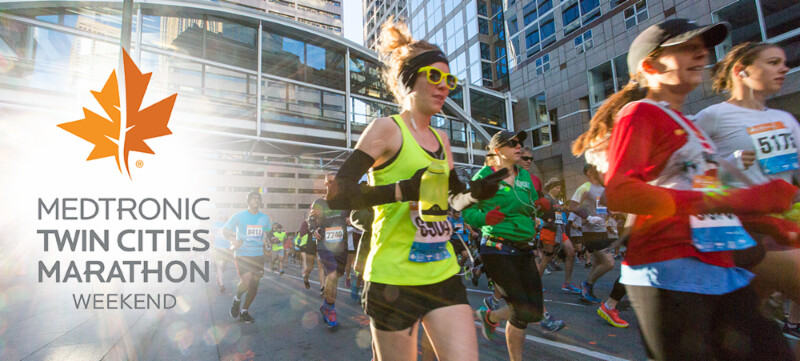
More than 20,000 people are registered for the Twin Cities Marathon and 10-mile race on Sunday. With projected highs in the 80s this weekend, and the National Weather Service saying it will feel more like summer than fall, organizers are warning racers to prepare for high temperatures and high humidity. St. Paul firefighters and paramedics will be along the route in the Capital City to ensure racers are safe and healthy, said Deputy Fire Chief Roy Mokosso.
Getting support from fellow firefighters
Some of the stigma around mental health has meant firefighters not talking about the horrors they respond to on emergency calls, and Bode and Buxton are trying to break that down just by asking for help with the marathon.
“In the past, it’s been very difficult for firefighters to ask for help because we’re the ones that help people,” Buxton said. “We’re making that change and we’ve reached out to people at the fire department and said, ‘We need help. We’re not sure if we’re going to be able to complete this task.'”
Off-duty firefighters will be along the marathon route to provide nutrition and hydration to Buxton and Bode, as well as moral support.
Buxton has run the distance of a marathon (26.2 miles), but not an official marathon; he’s done triathlons, mud races with obstacle courses, and rucking events (long walks while carrying a weighted rucksack).
Bode has run seven marathons, mostly the Twin Cities Marathon, and competed in Iron Man triathlons.
“I’m pretty slow,” Bode said. “I wouldn’t qualify for Boston (the marathon) or anything. I just like to push myself.”
They’ll stick together through the race course
Bode has been a St. Paul firefighter for nearly 18 years and the department’s health and wellness coordinator for about a year. He works with all firefighters and with cadets as they go through the department’s fire academy.
“My focus has been on trying to prevent some difficulties that firefighters face later on, whether it be mental health or making sure they keep their health a priority,” he said.
The St. Paul Fire Department has a peer support group, a peer fitness team and a cancer task force that works to reduce how much exposure firefighters have to dangerous chemicals from fires.
Buxton is a St. Paul firefighter of 10 years who’s currently a training assistant. He’s helping to run the fire academy that started Monday.
Buxton and Bode initially thought they’d walk Sunday’s marathon, but then they realized the time limit is six hours. They’re planning a combination of jogging and fast walking, and their goal is to complete it in time.
They’re going to start at the back of the pack and stay together the whole time. They plan to wear about 40 pounds of turnout gear — that’s the protective jacket, air tanks (but not the breathing masks they’d usually wear with them) and helmet that firefighters don to battle fires. They’ll likely start and end the race in pants that are part of the gear, but otherwise wear shorts.
Both men are also paramedics for the fire department, and said they’ll be watching over each other. They’ll be making sure they get plenty of electrolytes and hydration. If they feel overheated, Bode said they’ll take off their jackets until they cool down.
“We have a rule in the fire service: Two in, two out. You go in the fire together, you leave the fire together,” Buxton said. “We don’t want anybody to be alone and we’re taking that same tactic in this race. We’re going in together, we’re coming out together.”
Mokosso, the deputy fire chief, will be running Sunday’s 10-mile race for Capt. Parsons. Mokosso wasn’t planning to run this year, but after he saw that Parsons had signed up before he died, he asked Parsons’ family if he could take his spot and run in his honor.
“Chris has been at the top of my mind every run,” Mokosso said of his preparation for the race. “We were both the same age, we had a lot of things in common, and he and I had run a couple of marathons together.”
Annika Parsons, Chris’ younger daughter, said every way that people honor her father is meaningful to her and her family.
Chris Parsons was known for his statewide advocacy for firefighter health and safety, and he was physically fit, “so when it happened to him, it showed how it can happen to anyone,” Annika Parsons said. “Getting the word out really can help firefighters in the future, too.”
When Bode and Buxton need motivation, they expect they’ll be remembering their co-workers and families they left behind: Capts. Chris Parsons and Mike Paidar, and firefighters Tommy McDonough, Jason Woodbury and Shane Clifton.
(09/30/2023) Views: 358 ⚡AMPby Mara H. Gottfried
Medtronic Twin Cities Marathon
The Medtronic Twin Cities Marathon Weekend offer races, walks and activities for every age and ability level! Learn more about the weekend's events and activities by using the navigation bar at the left or top of your screen. The Twin Cities Marathonis a running event in the Minneapolis-Saint Paul area. The TCM was first run in 1982, and typically takes...
more...Molly Bookmyer who overcame cancer now challenges TCS Toronto Waterfront Marathon
Marathoners endure much suffering in order to excel in their sport but few have struggled with brain cancer.
American Molly Bookmyer underwent two surgeries eight years ago following a diagnosis of a brain tumor while finishing up her degree at Ohio State University.

With that awful period behind her now, as an elite marathoner, her path has led her to the 2023 TCS Toronto Waterfront Marathon where she, and a growing number of American elites, will attempt to qualify for the 2024 US Olympic Trials, to be run in Orlando, Florida on February 3.
Her current best is 2:31:39 and she sees Toronto Waterfront – her first international race – as an opportunity to knock off a significant chunk of time.

“I want to run 2:27,” she reveals. “I feel I haven’t had a breakthrough in my marathon I have had some good races at shorter distances. I ran a 1:10:51 half marathon last fall. So I have had some success at the shorter distances and I haven’t quite figured out the full marathon distance yet.
“My first goal is to get the world championship standard and the second goal is to get the Olympic standard.”
Bookmyer graduated from Ohio State in 2013 with a Bachelor of Science in Business Administration, Management and Operations. While she was a member of the Buckeyes’ cross-country and track teams she was not a scholarship athlete. Now she has a better understanding as to why she was limited.
“I was a walk-on at OSU. I got better but I wasn’t a star in college,“ she explains. “When I look back at it, it was probably because I was sick at the time. I didn’t know I had a brain tumor. I competed on the team but my times weren’t spectacular. I lettered in cross country and track but I wasn’t All American and I didn’t make it to the NCAA’s.”
A series of stress fractures also held her back and it was by a stroke of luck that the tumor was discovered.
“In different blood tests to try to find why I got stress fractures they found one of my hormones prolactin was high,” Bookmyer says. “This (hormone) is associated with tumors near your pituitary gland. They did a scan and they found the tumor in my ventricle. It was kind of luck. I probably had symptoms but thought it was normal.”
Following the diagnosis she underwent a spinal tap to determine if the cancer cells were in her spinal column. Fortunately, it came back negative. But the surgery to remove the growing tumor was vital.
Originally from Cleveland, she moved to Columbus to study at OSU and remained there ever since. That’s also where she met her husband, Eric.
Immediately after graduation she worked for the Abercrombie & Fitch company. Then, having dealt with her own serious illness, Eric was diagnosed with testicular cancer. Running was helpful in both relieving the stress of being a full-time caregiver to him as well as helping in her own recovery.
“I am healthy now,” she says through a smile. “I get a brain scan every year. It used to be every six months. After the first surgery I had complications from the surgery. The tumor has not come back.
“Eric just had his 5-year checkup, He had a couple of surgeries and ‘chemo’ so now he is healthy as well, I guess we are lucky we went through a lot and came out the other side healthy.”
Two years ago she was recruited by one of her former contacts at Abercrombie & Fitch to work for Hawthorne Gardening Company which is involved in the hydroponics industry selling lights, pots, containers, benches and other gardening equipment in both the cannabis and general botany industry. Most importantly, the job allows her to work remotely, something that helps while training full time.
Down time is limited but she says she enjoys spending time with Eric and her dog Cooper. Listening to music is another relaxing pastime with Rob Thomas of Matchbox Twenty remaining a favorite. With the Toronto Waterfront Marathon rapidly approaching she is confident she will perform at her best on the big occasion.
“Training is going really well,” Bookmyer declares. “I had a little setback in the spring. I tore my plantar fascistic but that’s fully healed. My mileage has gone to 115 to 120 miles (185km – 193km) a week which is higher than I have been before; paces are good, I am feeling strong. I am excited for what that means.”
(09/08/2023) Views: 388 ⚡AMPby Paul Gains
TCS Toronto Waterfront Marathon
The Scotiabank Toronto Waterfront Marathon, Half-Marathon & 5k Run / Walk is organized by Canada Running Series Inc., organizers of the Canada Running Series, "A selection of Canada's best runs!" Canada Running Series annually organizes eight events in Montreal, Toronto and Vancouver that vary in distance from the 5k to the marathon. The Scotiabank Toronto Waterfront Marathon and Half-Marathon are...
more...These Expert-Recommended Kinesiology Tapes Could Help Your Running Recovery
To overcome a nagging running injury, just tape yourself back together.
Kinesiology tape, created by Japanese chiropractor Dr. Kenzo Kase in 1973, is a stretchy therapeutic tape made of mostly cotton that uses medical-grade acrylic adhesive to stick to your skin. When stretched tight, the tape pulls the skin away from the tissues beneath, reducing the pressure against the underlying tissues. In theory, this promotes circulation and the removal of waste products through lymphatic drainage.
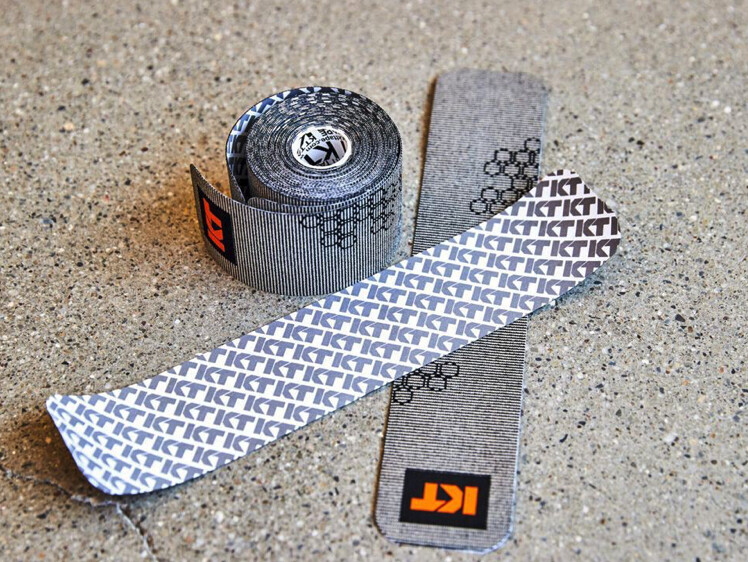

Our experts said that some runners use kinesiology tape to reduce pain. “Once you reduce the perception of pain, you can get an increase in range of motion and an increase in muscle activation,” says Dr. Karena Wu, clinical director of ActiveCare Physical Therapy. Because nerve fibers associated with touch stimulation are larger than pain fibers, the brain receives the touch stimulation faster, reducing your perception of the pain.
The tape can also inhibit certain muscles or facilitate others. Instead of immobilizing muscles and joints like athletic tape, kinesiology tape is stretchy, and runners can use that elasticity to adopt a stronger, healthier stride. “People who have shoulder or trap pain as they’re running tend to hike their shoulders up toward their ears,” says Denise Smith, PT and owner of Smith Physical Therapy + Running Academy. “We’ll tape down their shoulders. As their shoulder creeps up as they fatigue, that triggers a sensation of the tape pulling on the skin, so they relax their shoulders.”
Scientific research confirms some of kinesiology tape’s purported benefits. A 2022 meta-analysis of eight studies conducted by the University of Padova in Italy found that kinesiology tape was able to improve gait function, range of motion, and muscle activation in athletes. However, a 2020 study out of Leeds Beckett University in England found that the tape made no difference in cutaneous blood flow, calling into question some of the tape’s purported benefits for muscle soreness and recovery.
Even without hard science behind all of its claimed benefits, kinesiology tape has been widely adopted by athletes and trainers. At less than $20 per roll on average, it’s a low-cost, low-risk way to at least try to optimize your training regimen.
What to Consider When Picking Out Kinesiology TapeAllergies and Sensitivities
Most kinesiology tapes are made from hypoallergenic materials like cotton and nylon, and specifically avoid using those that commonly trigger allergies, such as latex. Even so, make sure to check the composition of any tape before applying it if you have a skin allergy.
Even if you don’t have a specific, intense allergy, some adhesives may irritate sensitive skin. Several brands offer “gentle” tapes with weaker adhesives that are less likely to cause redness or swelling.
Separately, keep in mind that removing kinesiology tape will likely affect your skin, since the adhesive is very strong. Make sure to read the removal instructions before yanking the tape off—some manufacturers recommend using baby oil to break down the adhesive before removal.
Body Hair
You don’t need to shave your body hair to use kinesiology tape, but you should know that too much body hair will defeat even the stickiest adhesives. If your tape is coming off more quickly than it should on a hairy area, shaving down to a quarter-inch or less may improve the tape’s staying power.
Positioning
Some areas of your body are easier to tape yourself than others, so consider where and how you’ll apply the tape before you buy. Ideally, you should consult a doctor or physical therapist before using kinesiology tape so they can show how to properly cut and apply it in a way that will enhance your performance, instead of harming it. “It is very important to know the anatomy where you are trying to apply the tape,” said Bruce Allen, DC, a chiropractor and certified kinesiology tape practitioner at the San Diego Running Institute. “If taped incorrectly, you could give yourself a separate injury.”
We also have a guide to using kinesiology tape, with expert instructions for taping yourself up to deal with a handful of common running injuries, including plantar fasciitis and shin splints.
If you’re concerned about mis-taping, we recommend looking for pre-cut kinesiology tape strips and patterns, which are made to support specific trouble spots, including knees, shoulders, and the lower back.
How We Selected the Best Kinesiology Tapes
To choose the best kinesiology tape, we consulted eight physical therapists, trainers, and running coaches to find out which ones they use and recommend to their athletes. We also gleaned insight from popular running forums like Slowtwitch, impressions from additional experts, and hundreds of customer reviews at major retailers, such as Amazon and Walmart.Vikash Sharma DPT, OCS, COMT of Perfect Stride Physical Therapy in New York City is a doctor of physical therapy and a certified running coach with the Road Runners Club of America and USA Track and Field. An avid runner, Sharma competes in road races around the Northeast.
Karena Wu, DPT, OCS, COMT, CSCS, CKPT, CPI, FAAOMPT is the owner and clinical director of ActiveCare Physical Therapy in New York and Mumbai. Wu is also the former director of education for Spidertech Kinesiology Tape.
Bruce Allen, DC, CKTP is a doctor of chiropractic medicine and certified kinesiology tape practitioner based in San Diego. Allen received his Bachelor of Science in Kinesiology, specializing in kinesiotherapy, from San Diego State University.
Denise Smith, PT is the owner of Smith Physical Therapy + Running Academy in the Chicago suburbs. A certified running technique specialist, Smith has consulted for the Russian olympic and national triathlon teams and travels the country educating runners on proper form using the Pose Method.
Robyn Pester of Robyn Pester Physical Therapy in Eugene, Oregon has been the lead PT for the 2022 World Athletics Championships, the Olympic Track & Field Trials in 2016 and 2020, and other high-end local track meets. Her manual therapy skills have developed over a 30-year career that has helped hundreds of clients return to active lifestyles.
Ryan Sweeney, DPT earned a doctorate in physical therapy at Duke University in 2013 and now works as an orthopedic clinical specialist and muscle activation technique specialist at Specialists in Sports and Orthopedic Rehabilitation in Overland Park, Kansas.
Matt Silver, DPT at Alpha Project Phyzio and Performance and a certified running gait analyst, helps injured runners regain their stride with athlete-focused physical therapy.
Peter Dills, DPT is the clinical director of Therapeutic Associates Physical Therapy in North Portland, Oregon. A certified therapeutic pain specialist and manual therapy specialist, Dills is particularly passionate about treating runners, especially foot and ankle disorders.
Dan Roe, author of this piece, is a former Runner’s World test manager and a former Division I distance runner at the University of Missouri. Kinesiology tape is a component of many top athletes’ training regimens, and a crucial aid for all kinds of runners who want to relieve soreness and remain cognizant of their form. Kinesiology tape mimics the elasticity of skin and lifts your skin away from tissues beneath, creating space that may help relieve joint pain, improve circulation, stabilize muscles, and reduce muscle soreness. Physical therapists also use it to help runners correct bad habits by helping them focus on activating muscles they may be underutilizing.
At the same time, it’s not a panacea for muscular health. In fact, it isn’t for everyone. We’re here to help you figure out whether kinesiology tape can help you support your muscles, improve circulation or prevent injury. We’ll also point you toward the best kinesiology tapes you can buy right now, from KT and other brands, based on expert advice from physical therapists who recommend the tape to their athletes.Who should avoid using kinesiology tape?
You should avoid kinesiology tape if you have a condition where more blood flow would be bad—deep vein thrombosis, diabetes and active cancers are among conditions that have excluded people from participating in kinesiology tape research. Also avoid taping over open wounds due to the risk of an infection.
If you’re unsure how your skin will react to an acrylic-based adhesive, or any of the components in a specific tape, test it first by applying an inch-long strip and waiting a few minutes to see how you react.
How long should I leave kinesiology tape on?
According to our experts, you should leave your KT tape on until it starts to slide or fall off. “The tape is meant to be a sensory stimuli so it is meant to be worn for the length of the activity and even afterwards,” said Wu. “In rehabilitation, it should be used for a few weeks in order to retrain or support or inhibit tissues during the recovery process.”
In most cases, a piece of tape should last for a few days, up to a week. Most of these tapes are water-resistant so you will be able to shower after a run while wearing your tape, but it will likely weaken the adhesive.
How do I prepare my skin before applying KT tape?
Our experts recommend applying rubbing alcohol to the area to remove natural oils before taping up. Make sure the skin is not red or irritated before putting it on, especially if you are reapplying to a recently taped area. “You never want to take the top layer of skin off or irritate the skin or else you cannot re-tape until the skin has calmed down,” Wu said.
How do I remove KT tape?
Dills advises his clients to remove the tape in the shower using warm, soapy water. To avoid leaving a residue, “don’t pull the tape straight away from your skin,” Dills said. “Gently peel it back a little at a time.” If your tape does leave some adhesive behind, Smith recommends starting with soapy water and a sponge or scrub brush, and graduating to an adhesive remover pad for persistent adhesives.
(09/03/2023) Views: 1,372 ⚡AMPby DAN ROE Runners World
Edmonton runner breaks world record for most T-shirts worn in a marathon
David Eliuk celebrated a top-heavy triumph at the Servus Edmonton Marathon on Sunday, setting a world record for the most shirts worn while completing a 42.2-km race.
The Edmonton man sported 78 running shirts as he crossed the finish line in 5:01:50, absolutely smothering the official Guinness World Record of 54 shirts set by British runner David Smith in 2022.

His new marathon crown, which has yet to be ratified by Guinness World Records, will be a familiar fit for Eliuk (and certainly a more comfortable one than his race outfit on Sunday), who previously held the Guinness World Record of 120 for the most shirts worn in a half-marathon.
While being encased in scores of T-shirts may look comical to outsiders, it’s a different story altogether on the inside, Eliuk told Canadian Running on Tuesday.

“It hurt. It actually caused restriction of blood flow to my hands and my lower arms,” Eliuk said of his effort at this year’s Hypothermic Half Marathon in Edmonton, where he officially set the half-marathon record.
He said his marathon attempt Sunday was originally part of his bid to simultaneously hold both the half-marathon and marathon titles. However, his half-marathon record fell in May to American Dan Harvey, who sported 127.
Eliuk said while Sunday’s shirt count of 78 was much less constricting and painful than his three-digit total for the half, his run at the Servus Edmonton Marathon presented a different set of challenges—not the least of which were the temperatures of a summer race.
“While I’m wearing fewer shirts and I don’t have the restriction and I don’t have the mobility issues, I also have to be very aware of my body temperature and sustaining myself through hydration and fuel for five hours,” he said. “It was still uncomfortable, still almost 30 pounds of shirt, and the weight on my shoulders and my back especially was really, really hard.”
Fortunately, race organizers allow runners who expect to take longer than six hours to finish to set out an hour before the usual 7 a.m. start time, which helped allay Eliuk’s concerns over heat.
“I was able to talk with the race director and the race crew and was allowed to enter that wave. So I actually started an hour before the regular marathon. I think it was about 8 C at 6 a.m. Being able to start out running in 8 C temperatures instead of 15 C makes a huge difference when I’m doing what I’m doing.”
Weighing on Eliuk, besides the shirts, was the clock. Guinness World Records rules require that record attempts for the most T-shirts worn in a marathon be completed within six hours.
“My morning was really solid and really good,” he said. “I was able to keep moving for the majority of it and I hit the half at around two hours and 11 minutes, so I had almost four hours to complete the second half of the race.”
Eliuk said he’s content just to appreciate his latest accomplishment, and doesn’t plan on chasing his former goal of holding both the marathon and half-marathon T-shirt records at the same time.
“I know how hard it is at 120 shirts, so for this other guy to go to 127, he’s just at a different level. I’ve been in his shoes before. I know how uncomfortable he was, so I’m happy letting the half-marathon record go.”
Next on his race calendar is the New York City Marathon in November, which he and his girlfriend will be running in support of Think Pink Rocks, a campaign supporting genetic testing for the detection of breast cancer.
“I’ll just be wearing the one shirt in New York,” he said.
This year’s Servus Edmonton Marathon was won by Meng-Tsung Chu from Colorado Springs, in 2:22:54 (one of the fastest times in the race’s 32-year history) and Janelle Bykowski of Lethbridge, Alta., in 2:51:53–and it was her very first marathon.
(08/23/2023) Views: 521 ⚡AMPby Paul Baswick
Running can help cut risk of 9 different cancers in men
Maintaining high levels of cardiorespiratory fitness in young adulthood can help men lower their risk of developing nine different forms of cancer later in life, according to research released this week.
In a study published in the British Journal of Sports Medicine, researchers analyzed the rates of cancer in a cohort of more than a million men in Sweden over an average period of 33 years, beginning at age 18.
Using the results from fitness tests that were used to gauge the men’s suitability for military service—assessments that were formerly mandatory in Sweden—researchers divided the participants into low, moderate and high levels of cardiorespiratory fitness, and compared cancer rates among men in these groups in later life.

The researchers found the men who showed the highest levels of fitness in young adulthood had a 20 per cent lower risk of kidney cancer and a 19 per cent lower risk of head and neck cancer compared to men in the low-fitness category.
The study also suggests high cardiorespiratory fitness can play a major role in reducing the risk of gastrointestinal cancers. Participants in the high-fitness category saw their risk of cancer of the liver, the bile ducts, the esophagus and the gallbladder slashed by nearly 40 per cent, and their risk of stomach and colon cancer reduced by 20 per cent.

The greatest difference was seen in rates of lung cancer. The study shows men in the high-fitness category cut their risk of lung cancer by 42 per cent compared to the low-fitness group. However, the researchers attributed this wide gap to smoking habits rather than cardiorespiratory fitness on its own.
The study also identified two forms of cancer that members of the high-fitness cohort were more likely to be diagnosed with, compared to men in the low-fitness group. Diagnoses of skin and prostate cancers were slightly higher in the high-fitness group. The researchers attributed the difference to physically fit men being more likely to spend more time in the sun, and to undergo screening for prostate cancer.
The study adds to a growing body of research linking cardiorespiratory fitness to reduced cancer risks in men. A separate study published by the Swedish School of Sport and Health Sciences in June also showed lower rates of colon and lung cancer in men with high cardiorespiratory fitness. However, that study, unlike the research published this week, linked high fitness levels to a lower risk of prostate cancer.
Although both the above studies looked specifically at cancer risks in men, other research has shown that cardiorespiratory fitness in early adulthood can also lead to reduced cancer risks for women later in life.
(08/19/2023) Views: 482 ⚡AMP
by Paul Baswick
Does Sunscreen Expire? Experts Answer Your Qs
Here’s how to tell if your sunscreen needs a refresh. Plus, the best ways to store it for optimal efficacy.If you’re like many runners, you might have the same bottle of sunscreen sitting in your bathroom cabinet for longer than you can remember. And, like many, you probably face a common dilemma: Keep or toss?
The simple verdict: Sunscreen definitely expires, so toss yours if it’s past its prime.

MORE FROM RUNNER'S WORLD ON APPLE NEWS
According to the Skin Cancer Foundation, slathering on sunscreen every day can prevent premature skin aging and slash your melanoma risk by 50 percent. (ICYMI, melanoma is the most dangerous form of skin cancer.) But sunscreen that’s passed its expiration date won’t do your skin any good.
As runners, we log more hours in the sun than most people, which puts us at greater risk for sunburn and skin cancer. We owe it to our skin (and overall health!) to give it the best sun protection possible.
Here, we explain why sunscreen expires and how to tell if yours has.
Why does sunscreen expire?
Sunscreen contains active ingredients that shield your skin from UV rays. In chemical sunscreens, you may find ingredients such as octisalate and/or avobenzone. According to the Skin Cancer Foundation, these ingredients absorb UV rays like a sponge before they can do any damage. In mineral sunscreens, common ingredients include titanium dioxide and zinc oxide, which physically block the rays before they enter your skin.
Over time, these active ingredients break down. When this happens, they become less effective at protecting your skin from harmful UV rays, leaving your skin vulnerable to sunburn and damage, says Cameron Rokhsar, M.D., the founder and director of the New York Cosmetic, Skin, and Laser Surgery Center and an associate clinical professor of dermatology at Mount Sinai Hospital in New York City.
Therefore, it’s essential to keep tabs on your sunscreen’s status. Using an expired product is not only pointless, but it can give you a false sense of security during sunny runs.
Are there signs to look for that show my sunscreen has expired?
“Unfortunately, there’s no reliable way to test if a sunscreen has expired,” says Shari Lipner, M.D., Ph.D., a dermatologist with Weill Cornell Medicine in New York City. However, some sunscreen manufacturers print an expiration date on the bottle or label.
For products that don’t have that expiration date (or if you threw the packaging away), know that all sunscreen manufacturers have to prove that their product will remain effective for at least three years, per the U.S. Food and Drug Administration (FDA). If that’s the case, write the purchase date on the bottle to track how long you’ve had it, Lipner suggests. Consider your sunscreen expired at the three-year mark.
Sunscreen can also expire earlier if exposed to heat, humidity, and sunlight. According to the Cleveland Clinic, chemical sunscreen is especially vulnerable because the active ingredients tend to be more unstable when exposed to heat than mineral sunscreen ingredients.
The takeaway? Don’t rely on expiration dates alone. “If you notice any changes in the consistency, color, or scent of the sunscreen, it could indicate that it’s expired or undergone some degradation, and it’s best not to use it,” Rokhsar says.
For example, many chemical and mineral sunscreens contain inactive ingredients that help the formula spread evenly. When these ingredients break down, you may notice that the sunscreen is gritty and/or tough to rub into your skin, according to the Cleveland Clinic.
You may also experience skin reactions like acne and rash when inactive ingredients degrade, Rokhsar says. Plus, many sunscreens contain preservatives. When these deteriorate, bacteria and fungi are more likely to grow inside the container, leading to skin infections and acne, the Cleveland Clinic notes.
So, if you start breaking out or developing rashes after using your sunscreen, it’s time to get a fresh bottle.
What’s the best way to store sunscreen?
“To extend the life of your sunscreen and ensure its effectiveness, store it in a cool, dry place,” Rokhsar says. In other words, don’t leave it in your car during hot summer runs or on top of your towel during beach days. Excessive heat breaks down the active ingredients that protect your skin from harmful UV rays, Rokhsar explains.
A better approach: Apply sunscreen before leaving home so you don’t have to keep it in your car during your run. “If you’re at the pool or beach, I suggest wrapping [the sunscreen] in a towel,” Lipner says. You can also stash it under some shade or keep it in the beverage cooler.
Also, keep the container tightly closed to prevent exposure to air, “which can also contribute to the breakdown of the active ingredients,” Rokhsar says.
So, can you use expired sunscreen?
Using sunscreen that’s gone bad won’t protect your skin from the harmful UV rays that cause skin damage and cancer. You’ll likely irritate your skin to boot. So, toss your sunblock if it’s passed its expiration date, it’s been three years since you purchased it, or you notice changes to the product or your skin.
You can prolong the shelf-life of your sunscreen by storing it in a cool, dry place. However, you don’t need to worry about expiration dates if you use sunscreen the way you should. “If you’re using sunscreen properly, which means applying a generous amount [or about a shot glass’ worth] and reapplying frequently, such as after swimming or sweating, a bottle shouldn’t last more than a season,” Rokhsar says.
(08/13/2023) Views: 388 ⚡AMP
by Runner’s World
7-year-old runs to beat clock in mom's cancer battle
A seven-year-old British girl has completed a multi-day marathon challenge in a desperate bid to pay for a brain biopsy that could help save her mother’s life.
The U.S. Sun reports that Lolita Oakes of North London and her friend Juliet Deilinger, also seven years old, recently ran the 42.2-km marathon distance to help fund Oakes’s mother’s fight against brain cancer.

In 2018, at age 36, Cordelia Taylor was diagnosed with glioblastoma, a form of brain cancer that has an average survival time of 12 to 18 months. Only five per cent of patients live more than five years.
Following aggressive treatment—including surgery that involved removing a quarter of Taylor’s brain without any resulting neurological impairment—Taylor was declared cancer-free this past April. The results of a scan just two months later, however, showed that the cancer had returned and was inoperable.
She told the Sun she is hoping to self-fund a private biopsy and potential targeted treatment of the malignant tumour. The need for timely funding is what inspired daughter Lolita to take up the weeklong marathon challenge.
The run not only succeeded in raising awareness of, and financial support for, her mother’s treatment—nearly three-quarters of the campaign’s $170,000 goal has been raised—but also encouraged others to join in. Lolita and Juliet were joined during the multi-day challenge—which involved running at least 5 km before school every day (and additional kilometres after school) for seven days—by an ever-growing group of friends, schoolmates and teachers.
“It was quite hard, how much I had to run, and the not stopping,” Lolita told the Sun. “The hardest part was when I fell over. It was tiring, but I’m proud of me and Juliet for running the marathon, and doing it for my mum"
Although seeing the challenge through wasn’t easy for Lolita, her mother said she had every confidence her daughter would finish what she started.
“Loli is joyful and spirited, full of happiness and confidence,” said Taylor. “She’s a very determined girl and unbelievably good at saying to herself, ‘I can do this.’”
(08/12/2023) Views: 387 ⚡AMPby Running Magazine
Amputee ultrarunner Jacky Hunt-Broersma takes on 5,250 kilometer challenge for cancer research
Bladerunner Jacky Hunt-Broersma celebrated being 21 years cancer-free by setting out on a new challenge: the Arizona-based athlete and coach will be running a half marathon a day (21.1K a day) from Aug. 1 until she reaches 5,250 kilometers. Aug. 1 is both the athlete’s amputee anniversary and marks 21 years of being cancer-free, she shared on social media, and this challenge is to honor cancer survivors, those fighting cancer and those who have lost their lives.
Dubbed the ‘Doing Hard Things’ project, Hunt-Broersma chose the distance to represent the number of people fighting cancer each day.”I had Ewing sarcoma,” the runner shared. “I was one of the lucky ones to survive and I’m so grateful to be alive and be able to move. I think movement is so important to not only keep us healthy but also help us cope mentally.”
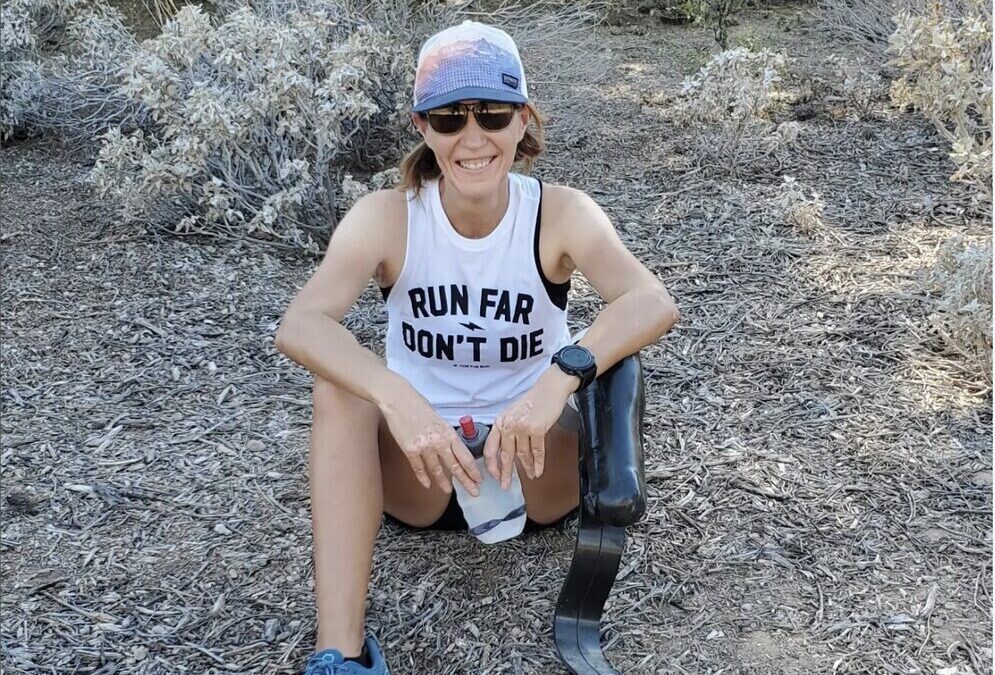
Hunt-Broersma is raising funds for cancer research and will be dedicating each day to someone fighting cancer or who has lost their life to the disease, and guesses it will take her about 250 days to complete the distance.
Hunt-Broersma lost her lower left leg to Ewing sarcoma, a rare form of cancer that affects the tissue around bones, in 2002. While she always lived a healthy lifestyle, she didn’t start running until 2016, when she signed up for a 5K race. Taking on challenging adventures is not new for Hunt-Broersma: she ran 104 marathons in 104 days in 2021, raising over $200,000 for amputee runners, and ran 50K a day for two weeks in July 2022.
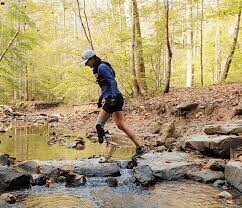
The name of her latest project comes from a phrase that carried her through her 104 marathon streak. “When I was running the 104 marathons in 104 days I’d often need encouragement and I’d whisper to myself ‘you can do hard things’ to keep me going when it got really hard,” she explains. “At one point during the marathons, I started believing in myself and that whisper changed to a louder mantra: ‘I can do hard things, I can do hard things.’ ”
The athlete invites runners and walkers of all levels to come out and join her on her daily half-marathon, and will be sharing the location and times of her runs on social media. Runners can show their solidarity from afar by joining the Strava group she has created, called “I can do hard things.” Hunt–Broersma wants everyone to feel included, she shared on Instagram. “I’m hoping it will create an encouraging space where everyone will feel welcome.”
(08/03/2023) Views: 613 ⚡AMPby Keeley Milne
A Higher VO2 Max May Offer Protections Against Cancer, Study Suggests
More evidence of the connection between cancer risk and exercise levels.
A new study found a link between higher cardiorespiratory fitness and lower risk of certain cancers.

The researchers also found an association between higher fitness level and lower risk of dying from cancer.
Cardiorespiratory fitness (CRF), marked by your VO2 max, refers to the capacity for your circulatory and respiratory systems to supply oxygen to the muscles during sustained exercise, and the American Heart Association notes that it’s an important health marker for both physical and mental health.
As new research in JAMA Network Open suggests, it’s also a factor in reducing risk of colon and lung cancer in men.
Looking at data from a large cohort study in Sweden, researchers analyzed health and physical activity information on almost 18,000 men between the ages of 18 to 75, collected over nearly 10 years. CRF was assessed using a cycle ergometer test, which measures heart rate and oxygen consumption.
They found that higher levels of cardiorespiratory fitness were associated with lower risk of developing colon and lung cancer. For those who did develop those cancers, higher fitness was associated with lower risk of death from those cancers within the study’s timeframe.
One possibly counterintuitive finding from the study is that higher CRF was associated with higher prostate cancer incidence. However, even in that result, researchers noted that those with high fitness levels showed a 5 percent lower death rate from that cancer.
Given the wide range in ages, researchers were able to determine that the cancer hazard risk was lowest for younger, non-smoking men at a normal weight and with the highest CRF.
Overall, researchers concluded that having very high CRF levels for any age could prevent up to 8 percent of all colon cancer cases, 4 percent of all deaths from lung cancer, and between 4 to 19 percent of deaths from prostate cancer. They added that it’s likely higher-intensity physical activity could have even more protective effects.
Although the recent study was done only on men, there is ample other research showing similar benefits for women in terms of both cancer prevention and longer survival rates for those who do develop cancer.
For example, a recent study in the British Journal of Sports Medicine about cancer recurrence in men and women with stage III colon cancer found that for physically inactive patients, disease recurrence peaked within two years of treatment, but that wasn’t true with physically active patients, according to that study’s lead author, Justin Brown, Ph.D., director of the Cancer Metabolism Program at Pennington Biomedical Research Center.
Brown told Runner’s World that even for people who had not been very physically active before a cancer diagnosis, making the effort to get consistent exercise can improve health outcomes overall. That means you don’t just potentially live longer through reduced cancer risk or lower recurrence risk, you live better as well.
“Whether someone has cancer or they’re considering what could lower their risk, there’s something about this disease that causes people to step back and evaluate decisions like how they’re treating their health,” Brown said. “Health is comprised of many components, of course, but physical activity is a key starting point, and a crucial factor when it comes to lowering your risk level with cancer.”
(07/30/2023) Views: 475 ⚡AMPby Runner’s World
Tommy Rivers Puzey inspires in short film about his Boston Marathon
Beloved endurance athlete Tommy Rivers Puzey shares his “why” for running in a short film about his experience at the 2023 Boston Marathon, which the formerly-elite runner finished in 4:53:44–which is remarkable, considering that three years ago he was stricken by a rare and aggressive form of lung cancer that nearly killed him. “I don’t love to run fast, I just love to run,” Puzey says.
Puzey, or “Rivs” (as fans and friends call him), has for years been an inspiring force to the endurance world and casual runners alike. Once known for being an elite marathoner, ultrarunner and triathlete, Puzey now runs to celebrate his incredible recovery and to strengthen his body in case of a relapse. His illness and recovery are documented in a recently published book, Everything All At Once, written by his wife, Steph Catudal.
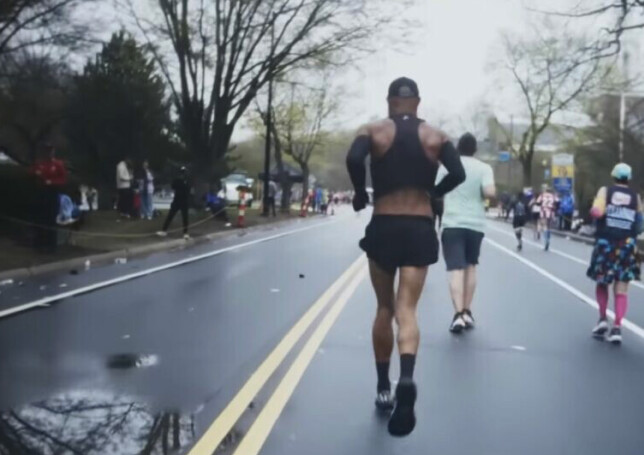
“Steph Catudal shares how her ultrarunner husband’s terrifying illness sparked transformation” — Canadian Running Magazine
View on the original site.
The short film poses the question of why we run: something Puzey can find a multitude of eloquent ways to answer.”It’s an expression of what we are as human beings,” Puzey shares in the film. “It’s what we’re meant to do.” Puzey, who lost 75 per cent of his lung capacity from his illness, has accepted and embraced his slower pace. “I don’t think anything has changed necessarily except that I’m not able to do it as fast,” he explains. Puzey returned to racing with the 2021 New York City Marathon, sharing high-fives and smiles as he walked the course with Catudal in 9:18:57.
The 2017 Boston Marathon was where Puzey ran his best, finishing in 2:18:57 for 16th place. In 2022, Puzey ran a vastly different, yet even more remarkable race. Due to his reduced lung capacity (and despite looking incredibly fit) Puzey must rest for 15-20 seconds for every 30 seconds of running, and he still manages to pull off a sub-five-hour finish.
Puzey explains that post-illness, the draw to the sport remains the same to him. Returning to the level of fitness he formerly had is not the goal; rather, he wants to “do everything [he] can to reach [his] greatest new potential.” Puzey has so many fans for a reason–he comes across as thoughtful and genuine and speaks with humility and grace. The film will have you pondering your why, and leave you inspired by a runner who never gives up.
(07/23/2023) Views: 851 ⚡AMPby Running Magazine
Regular exercise has a beneficial impact on the body’s response to inflammation: Study says
For years, researchers and health practitioners have known that regular, moderate exercise has a positive impact on your body’s response to inflammation, but exactly why it has that effect has remained a mystery. A new study out of York University has helped to shed light on this poorly understood phenomenon.
The researchers at the School of Kinesiology and Health Science discovered that regular exercise impacts the production of white blood cells that are responsible for killing infections and healing injuries.
Inflammation–friend or foe?
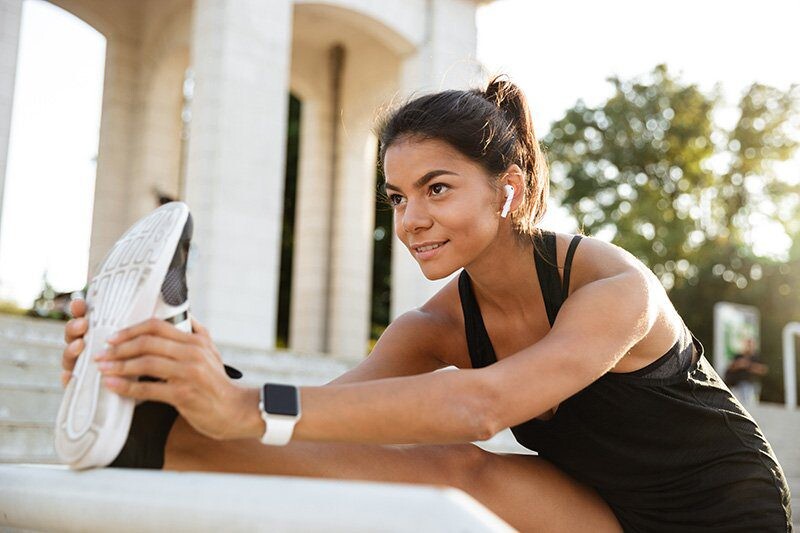
Inflammation is often treated as a bad thing, but it has an important role to play in our immune response. When you get sick or injure yourself, a certain amount of inflammation is necessary to fight off an infection or heal the injured tissue. Problems begin when you have excessive inflammation. Heart disease, diabetes, many autoimmune diseases and cancers all start because of an excessive inflammatory response from your body’s immune system. (COVID-19 was another example of the deleterious effects of an excessive immune response, which ended up attacking otherwise healthy organs in the body.)
Exercise is known as an immunomodulator. This means it helps your body moderate its immune response at the onset of illness or injury, ensuring its inflammatory response is just enough to allow for healing, without going overboard and causing a cascade of other problems

The study
The study, which was performed on mice, showed that moderate-intensity exercise had a “training effect” on the precursors for macrophages (the white blood cells that are responsible for mounting an inflammatory response and are your body’s first line of defense against infections). After the mice underwent a regular, moderate-intensity exercise regime, they experienced a “persistent metabolic rewiring and changes to chromatin accessibility in bone marrow-derived macrophages (BMDMs), which, in turn, tempers their inflammatory responses.”
In other words, exercise changed the way the cells breathed, according to Faculty of Health Associate Professor and York Research Chair Ali Abdul-Sater.
“Much like if you train your muscles through exercise, we showed that exercise of moderate intensity ended up training the precursors of those macrophages in the bone marrow,” says Abdul-Sater. “The way that exercise is doing this is by changing the way those cells breathe, essentially, how they use oxygen to generate energy and then changing the way they access their DNA.”
The cool part about these results is that the changes they were seeing weren’t temporary. While there are plenty of studies demonstrating the temporary immune-boosting effects of exercise, these results showed that the changes to the mice’s immune systems were still evident a week later.
Of course, if you’re wondering how well a mice study translates to humans, the researchers believe their findings are very applicable to us. As complex as our immune system is, it is also very ancient, which means that it is much the same across all mammals.
“The thing with humans is there’s no intervention that will work on everyone. We know that, but what this study suggests is that moderate and persistent exercise not only improves metabolic health, but also will improve immune health in the long run,” says Abdul-Sater.
The takeaways
If nothing else, this study reinforces the importance of exercise in a healthy immune system. But note that these benefits were demonstrated with a regular, moderate-intensity exercise regime.
Marathon training, for example, is generally not considered to be moderate exercise, and this study did not look at how a high-mileage or high-intensity running program affects the immune system. In fact, there is some research to demonstrate that bouts of high-intensity exercise (like running) in excess of one hour can actually have a temporary immuno-suppressing effect.
This doesn’t mean you should stop training, but runners need to be particularly careful that they’re eating enough to support their activity, that they’re eating plenty of fruits and vegetables, getting enough sleep and prioritizing recovery. It’s equally important that when you do get sick, you cut back on your training or take a break until you’re better, for the sake of your immune system.
(07/18/2023) Views: 527 ⚡AMPby Running Magazine
Higher VO2 max may protect against certain cancers, study shows
Men might be able to boost their protection against certain types of cancer by running or engaging in other forms of cardiovascular exercise, according to a new study. Researchers from the Swedish School of Sport and Health Sciences have linked cardio-respiratory fitness to a lower risk of dying from prostate, colon and lung cancer—the three most common types of cancer in men.
For the study, researchers pored over 10 years of data from 177,709 Swedish men ranging in age from 18 to 75, with the objective of determining how various levels of cardio-respiratory fitness might offer protection against contracting or dying from these specific cancers. Participants were ranked into four groups, from lowest to highest cardio-respiratory fitness.

After measuring participants for VO2 max—the maximum amount of oxygen your body can use during dynamic exercise—the researchers found those with higher VO2 max had a significantly lower risk of dying from prostate, colon and lung cancer. They also found that those with a higher VO2 max were at lower risk of developing colon or lung cancer; that data did reveal a slightly higher risk of developing prostate cancer among this group, however.
While this latest study is unique in its examination of how higher fitness levels can curb rates of certain cancers in men, it adds to a growing list of research linking cardio-respiratory fitness to lower cancer risks. Previous studies have associated exercise with lower rates of stomach cancer as well as lower rates of cancer among girls.

Recent studies have also linked regular physical exercise to other aspects of health and well-being. A study published by researchers in the United States and Mexico earlier this year, for example, found that sticking to a regular running regimen throughout middle age may help prevent or slow memory loss associated with getting older.
Research has also shown that reaping the health benefits of a more active lifestyle doesn’t require a huge investment in time or energy. A report published by the American Heart Association last year showed adults needed only 21 and a half minutes of vigorous exercise—defined as running, walking, bicycling or swimming—a day to lower their risk of premature death.
(07/07/2023) Views: 571 ⚡AMPby Paul Baswick
92-year-old Bill Thorn crosses Peachtree Road Race finish line to end 53-year streak
Bill Thorn is the only runner to have participated in Atlanta's Independence Day race every year since it began in 1970.
92-year-old runner marked the end of an incredible 53-year streak at the Peachtree Road Race on Tuesday, as the only person to have run in Atlanta’s famed Independence Day 10K every year since it began in 1970 crossed the finish line one last time.
Bill Thorn, who served as grand marshal of this year’s race, officially ended the streak Tuesday when he ceremonially broke the tape in a short walk to the finish line as crowds cheered him on.

Although Thorn now uses a walker to get around, he took his final steps toward the finish line of Tuesday’s race unaided, raising his hands triumphantly as he broke the tape.
The former high school track coach told Atlanta’s 11Alive the decision to stop running the race was “hard” but that he was “definitely at peace” with putting the streak to bed. “To be honest, I’m kind of relieved,” he said.

For Thorn, who was inducted into the Peachtree Road Race Hall of Fame in 1994, keeping the streak alive wasn’t always easy. One year, he ran the race with a sprained ankle. He also once finished the race during treatment for prostate cancer. But with his balance becoming more of an issue in recent years, Thorn said he agreed with his family that it was time to celebrate his record streak by officially bringing it to a close.
Thorn was one of 150 runners who ran the first Peachtree Road Race in 1970, and among the group of only 110 to finish that first race. He told 11Alive that the idea of a streak never occurred to him before it ballooned to the quarter-century mark. “I would just show up every year; no one said anything (about the streak) until the 25th year,” he said.
In 2019, to celebrate the 50th running of the race, Thorn crossed the finish line with four generations of his family and Julia Emmons, former executive of the Atlanta Track Club, which organizes the run. “It could’ve been just a fad,” Thorn said of his streak that year. “But as you go along through the years, people like Julia say to me every once in a while to ‘keep going’ and that was really encouraging, and so it just became a year-after-year thing.”
Since the pandemic, Thorn has completed the virtual edition of the Peachtree, running the distance around his neighbourhood.
Saying he still works out six days a week, Thorn told the Atlanta Track Club that “it’s been really exciting over the years, but there comes a time when you have to let go,” adding that “no one else will be able to say they did the first 50.”
(07/05/2023) Views: 507 ⚡AMPby Paul Baswick
AJC Peachtree Road Race
The AJC Peachtree Road Race, organized by the Atlanta Track Club, is the largest 10K in the world. In its 48th running, the AJC Peachtree Road Race has become a Fourth of July tradition for thousands of people throughout the metro Atlanta area and beyond. Come kick off your Fourth of July festivities with us! If you did not get...
more...Bill Thorn Ends His 53-Year Peachtree Road Race Run Streak This July 4
The 92-year-old is the only runner to have completed the famous 10K every year since it began in 1970.
This year’s running of the historic Peachtree Road Race in Atlanta will mark the end of an era. Bill Thorn, the only person to have run what has become the largest 10K in the world every year since it began in 1970, is ending his 53-year race streak. At 92 years old, Thorn thinks it’s finally time. He’s dealt with balance issues over the past few years, and has been racing with the aid of a walker.

“It’s been really exciting over the years, but there comes a time when you have to let go,” he said in an Atlanta Track Club press statement.
In a year that features the deepest women’s field in the history of the race, including five women who have personal bests faster than the course record of 30:22, it’s not just the elite runners who will be anticipated at the finish line.
On Tuesday, Thorn will be honored as the Peachtree’s Grand Marshal, and he’ll be chauffeured down the 6.2-mile course that he arguably knows better than anyone else in history. Just before the finish in Piedmont Park, he’ll emerge from the vehicle to be celebrated as he crosses the finish line on foot for the last time.
“There is only one way to stop worrying about not finishing, and that is to just be finished,” he said, “I’m going into a new era.”
Thorn has been a lover and booster of running for a long time. He coached athletes across various sports for 64 years, and in 2019, he retired from Landmark Christian School in Fairburn (an Atlanta suburb) where since 1995, he’d led his teams to 42 state championships in football, track, and cross-country.
For many years, Thorn had good company as one of the “Original 110” finishers from the inaugural 1970 road race, but those numbers dwindled over time. He and Don Gamel were the only two who ran every year through 1992, and by 1993, Thorn was carrying that torch alone.
Every Fourth of July, he’s shown up on the start line and hustled up the infamous “Cardiac Hill” in the stifling summer heat and Georgia humidity, whether he was coping with an ankle sprain, heel gash, or something as serious as prostate cancer. In his younger years, he raced his fastest times in the 39-minute range, but over time, the race became more about having fun with his family—his 30-year-old granddaughter, Kenzie Bayman, was his “race day buddy” for several years. The senior runner has been completing the race virtually since the COVID-19 pandemic, running a carefully measured route in his neighborhood.
On the Peachtree’s 50th anniversary in 2019, Thorn said, “It could’ve been just a fad, but as you go along through the years, people like Julia [Emmons, the former Atlanta Track Club Executive Director] says to me every once in a while to ‘keep going’ and that was really encouraging, and so it just became a year after year thing.”
This year, Thorn will be honored with his name engraved on the Peachtree Cup, an honor that up until now has been reserved for race champions, including Aliphine Tuliamuk, Stephanie Bruce, and Jeff Galloway. This distinction is all his own. “No one else will ever be able to say they did the first 50,” he said.
You can stream the AJC Peachtree Road Race on the 11Alive YouTube channel on Tuesday for free. The elite women will start at 6:50 a.m. ET and the elite men will set off at 7 a.m. ET.
(07/02/2023) Views: 670 ⚡AMPby Runner’s World
Why You Need Zone 2 Training in Your Workout Plan
How easy workouts can bring big rewards.
A minute ago, high-intensity interval training (HIIT) was king. Now that gut-it-out-and-get-the-glory work might need to share the crown with slow and steady efforts, thanks to what they do for your body, your longevity, and maybe even your mind.

These are the famous zone 2 workouts—keeping your heart rate between about 70 and 80 percent of its maximum—that runners, smart gymgoers, and everyone with a podcast is talking about these days. Think of zone 2 as the range between easy and moderate cardio, where you can carry on a conversation but someone on the other end of a phone would know you’re not sitting down. (Find out more on how to know you’re in the zone by checking out the chart below.)
What happens in zone 2 powers up your endurance, your lifting routine, and your general performance as a human being, proponents say. Here’s what to know about the zone.
How an Easy Effort Brings You Gains
Endurance athletes, such as marathoners, cyclists, and Ironmen, have long understood that zone 2 training is a key to performing well on race day. Look at Eliud Kipchoge, the world’s fastest marathoner, who spends four days a week running in zones so low that any decent runner could keep up with him. Lower-zone training yields high results in endurance sports, says Mike T. Nelson, Ph.D., C.S.C.S., owner of Extreme Human Performance, possibly “because the athletes aren’t out there just trying to fry themselves crazy every single day.” A long Z2 effort today leaves room for more time on your feet or in the saddle the next day. But another huge perk of Z2 training, no matter your sport, is the adaptations your body is making deep within your cells.
It all goes back to your mitochondria, the parts of your cells that generate ATP—that’s the fuel that drives muscle contractions. With age, your mitochondria get kind of like old dog fur: sparse, damaged, and inefficient. “Zone 2 cardio basically helps build your mitochondria,” says Kenneth Jay, Ph.D., a sports scientist who’s done research with the National Research Centre for the Working Environment in Copenhagen. These workouts help you produce more of those cellular powerhouses and shed old, damaged ones. When you get out of that zone, you start using a different energy system that doesn’t stimulate mitochondria to the same extent.
These cellular improvements can help you make gains in lifting, too, by aiding your recovery between sets. People without healthy and plentiful mitochondria “just don’t have the capacity to regenerate ATP fast enough to repeat something. And what they are repeating is half the output of what they were doing at the beginning, so they’re not getting the stimulus that they could,” Nelson says.
Building mitochondria might not get you ripped, but it deserves a lot of cred given that “mitochondrial dysfunction” has been linked to cardiovascular disease, cancer, diabetes, and obesity. Shoring them up with Z2 essentially gives you a more efficient engine to get through life on. “It’s like a hybrid car,” explains Stephen Seiler, Ph.D., a professor of sports science at the University of Agder in Kristiansand, Norway, who’s studied the effects of high- and low-intensity zone training in athletes. Redlining your workouts saps battery power. “You can run off the battery for a little while, but to pay it back, you’ve got to have your main engine.” Consistent Z2 work not only helps you recover better between sets or workouts, but it also helps you get better at everyday challenges: a family hike, an extra-long-haul rush to your flight gate, or a grueling workweek.
Does Zone 2 Work Have to Be Cardio?
In general, yes. That’s because a big benefit of zone 2 cardio is that it helps keep your heart strong and, basically, stretchy. When you lift heavy, your heart’s left ventricle—the one that pumps oxygenated blood to the rest of your body—gets tough, too. Heavy loads make your heart contract in a way that causes it to lay down more muscle fibers. But it lays them down inside the chamber, so there’s less room for blood. (Don’t get smug, endurance folks; a huge amount of cardio makes yours too thin and can leave you vulnerable to issues like atrial fibrillation.) Zone 2 cardio moves blood through the heart in a way that keeps walls at a healthy thickness and stretchiness, so it functions better, says Jay.
There’s debate on exactly how much time you need in Z2 to get the benefits. If you’re mostly sedentary now, any amount of low-intensity movement will help. If you’re somewhat or very fit, experts typically promote a minimum of 30 to 40 minutes of zone 2 cardio twice a week. (For endurance athletes, 80 percent of total training volume in Z2 is a good guideline). The trick is not turning that cardio workout into a sprint endorphin rush. Once you start pushing the intensity, cellular by-products (lactate) begin to accumulate and a different energy-producing process starts to take over. And that’s not what you want to train in these workouts.
Zone 2 is chat-paced work, so bring friends. Fit people might need more than a casual walk; hiking and rucking uphill can get you there. Keep it interesting in the gym by giving ten minutes each to the rower, bike, and treadmill. The key is control. “There is a warrior aspect to this as well,” Seiler says. When you have the discipline to stay in the zone, “there can be a Zen there in going out and finding your rhythm and not be influenced by the person who runs past you that day,” he says.
When it comes to creating a more efficient engine, easy really does do it. It’s not like you can’t have go-hard-or-go-home workouts; you need those, too. But being smart about adding a little low can feed your high.
(06/25/2023) Views: 804 ⚡AMPby Men’s Health
Steph Catudal shares how ultrarunning husband's terrifying illness sparked transformation
Steph Catudal felt her world unravel in 2020 when her husband, famed U.S. ultramarathoner Tommy Rivers Puzey (a.k.a. Tommy Rivs), was diagnosed with a rare form of lung cancer that put him into a medically induced coma for 84 days. The crisis forced Catudal, who was born and raised in Montreal, to face not only an uncertain future, but also pent-up anger and unprocessed grief from her own past.
The author explores the heights and depths of her years-long journey to self-acceptance in Everything All At Once , which comes out May 30. From the tragedy of losing her father to cancer to her supporting Puzey on his road to remission and his being declared free of the disease, the memoir shares lessons Catudal says required time and patience to fully grasp.

“I started writing this book about 10 years ago actually, long before Rivs was diagnosed with cancer. I wanted to tell the story of my adolescent grief of losing my father—it was a story that affected me so deeply and throughout my life,” says Catudal. “I wanted to connect to other people who similarly experienced grief. But it never felt finished. The book never felt done even though I had typed the last words, so I kind of left it on the back burner.”
“When Rivs got sick, I went through an entire self-transformation, and I realized part of the reason why my book didn’t feel finished was because my healing journey still wasn’t finished, and I hadn’t learned all the lessons that I needed to, that I ended up learning through Rivs’ illness. When he was sick, I wrote a lot and posted my writing on social media, and what I wrote resonated with a lot of people and it made me feel a lot less lonely during a lonely time–that human connection in a really isolated time in my life. So I think I wrote the book to further that connection, to broaden the network of those who have experienced grief, which everyone has experienced in life, no matter what the situation is.”
Catudal, who lives with Puzey and their three daughters, says that while writing the memoir was cathartic, she hopes the book can be an aid to others as they navigate their own unique challenges.
“Mostly I hope that it helps people learn self-acceptance,” she says. “It was a long road for me to accept myself. It’s important to accept all of who you are—the brokenness, the anger and also the gratitude and the joy—and just know that you’re OK wherever you’re at.”
“Another hope I have for what people take from this is that no matter what we’re going through, there is love all around. It’s woven into every human experience, and you just have to look to see it. Even if you feel like you’re in the depths of loneliness, there is always love there.”
She says sharing her story with readers has given her a new opportunity to practise acceptance.
“It’s both really exciting and, in a way, nerve-racking to put so much of your life, your feelings and your introspection into a book that people can take and they could either love it or they could hate it. I just have to be OK with letting it go out into the world.”
The publication of Catudal’s memoir also comes with the satisfaction of seeing a long, gruelling challenge to the very end—a feeling her ultrarunning husband knows very well.
“Rivs tells me that this is my own ultramarathon—the daily deposits of writing a page if I could, whenever I had the time,” says Catudal.
“I did it through newborn babies and grad school and sleepless nights, so there’s definitely a sense of pride and accomplishment.”
Look for our review of Everything All At Once in the July/August 2023 issue of Canadian Running.
(06/10/2023) Views: 902 ⚡AMPby Running Magazine
Gene Dykes, 75, sets seven U.S. masters records
Accomplished ultrarunner Gene Dykes, 75, looks to have set no fewer than seven U.S. masters records at a 12-hour race in his home state of Pennsylvania over the weekend, surprising himself as he pushed past health issues to pass the 100-km mark with 400 metres to spare.
The records, which have yet to be ratified by USA Track and Field, include the fastest outdoor track times in the U.S. men’s 75-79 category for 25K (2:48:33), 30K (3:24:08), 50K (5:40:39), 20 miles (3:41:28), 50 miles (9:25:10) and 100K (11:56:26), and the longest distance run in that category for a 12-hour period (100,481 metres). Dykes set the records during his 12-hour overnight effort at the Dawn to Dusk to Dawn Track Ultras in Sharon Hill, Pa., on May 13-14.

The 100K record was the most surprising to Dykes, who has broken multiple records since he took up competitive racing in his 60s. “I didn’t think I had a prayer,” he says. “It’s hard running 100K at my age. I only made it by four minutes.”
Making his latest effort even more remarkable was the fact he was battling a host of health issues on race night.

“I told people I’m battling the three C’s out here,” says Dykes. “Two weeks ago I contracted COVID, and I also had cold symptoms going into the race. Six months before I had been diagnosed with blood cancer, and that’s been really hurting my fast pace, but I have this theory that it doesn’t affect ultra paces and that seems to have really been borne out here. The only symptom I have is that I can’t breathe hard enough when I run fast, but when you’re running 12 hours, you’re never running hard. I was really happy to be able to get through 12 hours with all those health problems.”
Dykes says although he has been sitting out races recently due to health challanges, it was important for him to step up to the starting line over the weekend, as he prepares to make history next month as the oldest finisher of the 100-mile Western States Endurance Run.
“I kind of had to take a chance, because the really big race is next month,” says Dykes. “That’s a big deal. I’ve got a sponsor, and everybody’s expecting me to become the oldest-ever finisher there. So I thought, If I can’t run for 12 hours, how am I going to run for 30 hours?”
The self-described “ultra geezer” says his race on the weekend—his longest since receiving his cancer diagnosis—is a good confidence booster ahead of Western States.
“When you haven’t done something that like in a while, doubts creep in. A lot of things could have gone wrong. I could have got nauseated, I could have bonked, running out of glycogen, in which case you’re going to slow down no matter how much you want to run faster. None of those things happened. You get in this strange mindset where you just kind of dial out misery and keep on going.”
Reflecting on his latest effort with humility, Dykes says many of the U.S. masters records he set on the weekend were “low-hanging fruit,” saying he could “think of a half a dozen 75-year-olds out there” who could have set records in the 25- and 30-km distances “if they had the mind to.”
He adds, however, that he was proud to have hit the 100-km distance under the wire. “At 50 km I asked my crew to find out the new pace I would have to run over the next 50 km for the 100 km. I had to pick up from my comfortable pace. I thought I don’t care if I have no chance—I’m going to run the pace I need and keep doing it until I can’t do it anymore.’ Somehow, for seven hours I managed to keep pushing myself right up to the ending bell.”
Dykes is now looking forward to bringing that same determination to Western States on June 24-25. “It’ll be fun trying,” he says. “There are just so many ways to enjoy running. I’m really fortunate.”
(05/17/2023) Views: 583 ⚡AMPby Paul Baswick
Western States 100
The Western States ® 100-Mile Endurance Run is the world’s oldest and most prestigious 100-mile trail race. Starting in Squaw Valley, California near the site of the 1960 Winter Olympics and ending 100.2 miles later in Auburn, California, Western States, in the decades since its inception in 1974, has come to represent one of the ultimate endurance tests in the...
more...5 Easy Ways to Drink More Water
Because staying hydrated doesn’t have to be complicated
We’ve all heard it before: Hydration is good for your health and athletic performance. The thing is, maintaining adequate water levels is easier said than done. Registered dietitian nutritionist Maya Feller says her patients report water as one of the hardest things to consume. “They either find it not desirable,” says Feller, “or they forget.”

Jen Scott, a registered dietitian, nutritionist, and running coach, says that skimping on water can lead to a host of negative effects including, zapped energy, elevated heart rate, GI distress, diminished blood flow to your organs and muscles, decreased lubrication around your joints, and increased muscle fatigue and soreness. Or, as Feller puts it: “Without proper hydration, the body just does not function optimally.”
The right amount of hydration depends on a number of factors, including your activity level, overall health, and even the climate where you live, according to the Mayo Clinic. As a general rule of thumb, the Institute of Medicine recommends men consume 3.7 liters (15.5 cups) of water per day, while women should sip on 2.7 liters (11.5 cups).
But these benchmarks include water intake from all beverage types, as well as foods. A good barometer to aim for is half your bodyweight in ounces, Scott says. For example, a 160-pound person would shoot for 80 ounces (10 8-ounce cups). However, she tells active folks, like endurance athletes, to add additional fluid. Scott recommends sipping on two extra cups (16 ounces) before a workout, two cups after, and half a cup during for every 30 minutes of exercise.
For athletes, hydration should include not just water, but electrolyte replenishment, too, say Scott and Feller. Electrolytes are minerals such as calcium, potassium, and sodium that you lose when you sweat. Because electrolytes impact a number of bodily processes, including muscle function, it’s important to replenish lost stores through fluids like sports drinks, milk, coconut water, mineral water, and hydration aids. (Plain old water doesn’t have electrolytes.)
You’re likely well hydrated if you don’t often feel thirsty and your pee is clear or light yellow, according to the Mayo Clinic. That said, Feller recommends athletes work with a dietitian to come up with a fueling and hydration plan that works for them. “It needs to be individualized,” she says.
In the meantime, if you’re struggling to take in enough liquids, here are five simple, expert-recommended ways to boost your hydration.
Feller is a big fan of herbal teas–either warm or iced. “It doesn’t have to all be [plain] water to meet your fluid needs,” says Scott. Tea, in particular, may deliver additional health benefits. Sipping two to three cups a day is linked with reduced risk of total mortality, cardiac death, coronary artery disease, stroke, and type 2 diabetes, according to a meta-analysis of observational studies. The only caveat is that very hot tea (think: 131 to 140 degrees) is associated with esophageal and gastric cancers, according to the meta-analysis. It may be wise to let your mug cool slightly before drinking.
Some people just don’t like the taste of water. If that’s you, Scott recommends freshening things up by squeezing lemon juice into your H20 or adding a splash of fruit juice.
Another option is to make your own infused water: Add your favorite fruits, veggies, or herbs to the bottom of a pitcher. Then, pour water on top and let the flavor soak in. Feller is a fan of water infused with frozen berries as well as lime, cucumber, basil, and mint.
You can also level up your water by making flavored ice cubes. Simply add a favorite ingredient or two to an empty ice cube tray, then pour water over it and let it freeze. Feller recommends kiwi-lemon for a “tangy” taste. You can also try this recipe for raspberry-lemon ice cubes.
About 20 percent of your hydration comes from food sources, says Feller. “So really embracing plant-rich food sources is a great way to add to your hydration while still thinking about flavor and texture,” she says. Scott recommends nibbling on fruits and vegetables with a high-water content, like melons, oranges, grapefruit, grapes, celery, lettuce, tomatoes, cucumbers, and bell peppers. “Those things can all help boost your hydration,” she says. “Every little bit helps.”
Soups can be a warming, filling, and healthy meal choice. Broth-based soups, in particular, can help contribute to your hydration. As a bonus, soups can provide a dose of sodium, which is helpful for athletes who need to replenish those electrolytes, says Scott.
It sounds simple, but picking the right container for your water can make a difference. “I have some patients that have a lot of success with water bottles that have demarcations on them so they can see how much they consumed,” says Feller. One patient, she adds, finds motivation from drinking from a clear water bottle, since she can easily track her progress throughout the day.
(05/13/2023) Views: 478 ⚡AMPby Outside
Botswana’s Nijel Amos 800m star and Olympic medalist, banned three years for doping
Botswana’s Nijel Amos, the joint-third-fastest 800m runner in history, was banned three years for doping.
The case stemmed to last June, when he tested positive for GW1516, an experimental drug which can modify the body’s metabolism but has been considered too dangerous for human use.

The ban was backdated to last July, when Amos was provisionally suspended pending an investigation. His ban now runs to 2025, which means the 29-year-old Amos will miss the 2024 Paris Olympics.
Amos received a one-year reduction of what would otherwise be a four-year ban because he made an early admission and acceptance of the suspension.

That came after he requested a supplement be tested for the presence of the drug. The test did not detect any GW1516 in opened and sealed bottles.
GW1516 was developed to help build endurance and burn fat but was found to cause cancer during tests on rodents. Anti-doping organizations have warned athletes not to use it on safety grounds.
The drug has previously been found in samples given by professional cyclists and by Olympic race walker Elena Lashmanova. The Russian served a two-year ban and was later stripped of the 20km gold medal she won at the 2012 Olympics for another doping offense.
In 2012, Amos, then 18, took silver in the 800m at the London Games in what many called the greatest Olympic race in history. Kenyan David Rudisha lowered his world record. Amos matched Seb Coe as the third-fastest man in history in the event (1:41.73). Every runner’s time was the fastest ever for that finishing placement.
Amos has not won an Olympic or world championships medal since. In July 2019, he ran 1:41.89, the world’s best time since that London Olympic final.
At the Tokyo Olympics, Amos and American Isaiah Jewett got tangled in the final lap of their semifinal. In an act of good sportsmanship, the runners helped each other up and later jogged across the finish line together in the last two places. Amos was granted a place in the final and finished eighth.
(05/03/2023) Views: 629 ⚡AMPby OlympicTalk
How the Bolder Boulder 10K Became One of the World’s Most Cherished Road Races
5,000 runners are expected to run this year’s Memorial Day 10K on May 29
At bedtime last week, legendary American distance runner Melody Fairchild regaled her 7-year-old son Dakota with tales of the Bolder Boulder 10K he plans to run this year.


One of the biggest road races in the world for the past several decades, the race sends 40,000 runners through the streets of Boulder, Colorado, on a point-to-point race that ends at the University of Colorado (CU) football stadium, full of cheering spectators and fellow runners.
“I told him it’s an amazing feeling to run into that stadium,” Fairchild says. “When you hit the field, the whole crowd is cheering for everybody. You feel like they’re cheering for you. He had this huge smile on his face.”
And if 50,000 people cheering isn’t enough, there’s also the famous slip-n-slide, numerous bands playing on the course, runners and spectators wearing outrageous costumes, and the military jet flyover by the Colorado Air National Guard you can feel in your bones. Named America’s All-Time Best 10K, it’s likely to be one of the biggest parties you’ll ever attend.
Fairchild recounted for Dakota her experience as the U.S. captain for the Bolder Boulder’s first International Team Challenge professional race in 1998.
“I remember looking out the window and seeing the stadium full. I was so nervous, I thought I was gonna vomit all over the floor,” she says. “When I walked out and they introduced me as the local hometown girl, the whole crowd roared.”
Fairchild ran her first Bolder Boulder at age eight. She went on to win the citizens’ race three times (1989, 1990, 1991) when she was a record-setting high schooler, became an All-American and NCAA champion at the University of Oregon, and then qualified for the U.S. Olympic Trials in the 10,000-meter run and marathon as a professional runner. But the Bolder Boulder has always held a special place in her heart, which is why she has continued to run it through the years and why she’s so eager to introduce Dakota to it.
The idea for the Bolder Boulder germinated in the mind of a father watching his five children participate in all-day track meets. It was the summer of 1978 at the upswing of the original American running boom, and runner and local businessman Steve Bosley had grown frustrated with the disorganized events and parents berating their children for not running fast enough.
Bosley, then 37, reached out to his friend, Boulder resident and international running icon Frank Shorter, a two-time Olympic medalist in the marathon, for help designing a race that would serve their community and promote the sport of running. The race would not only become a Colorado icon, it set a gold standard for road races around the world and helped elevate women’s running in unprecedented ways.
During the spring of 1979, Cliff Bosley, the current race director, went door to door with his Boy Scout troop, passing out posters to encourage neighbors to run his dad’s inaugural race. The poster announced a 4,000-participant cap and enticed Boulderites to “Run with Frank Shorter and Ric Rojas!” for a mere $6.50 entry fee. (Rojas was another local elite athlete who would go on to win the inaugural race in 1979. His daughter, Nell Rojas, a current professional runner, won the women’s citizen’s race 40 years later in 2019.)
Bosley recalls giving a man in his front yard a poster who threw it back in his face in disbelief. “‘Yeah right, 4,000!’ the man scoffed. “I was just a 12-year-old kid. You believe everything your parents tell you. I thought, ‘Dad says it could happen—why won’t it?!’”
The inaugural race saw 2,700 registrations. The next year, it doubled in size and live entertainment was added to the celebration. Participation continued to soar in the ensuing years and decades, eventually reaching 50,421 in 2010. With an average of 45,000 finishers over the past 10 years, it’s now the seventh-largest road race in the nation and the largest Memorial Day celebration in the U.S.
From its inception, the Bolder Boulder 10K offered equal prize money for the female and male winners. In 1984, it created a separate elite race from the citizens’ race. There was also a deliberate split in the women’s and men’s elite race so that both races could be showcased equally and covered live on the local TV broadcast. Today, it offers one of the largest non-marathon prize purses in the U.S., but this did not come without a lot of work.
Initially road races were precluded from paying prize money to athletes because it changed their amateur athlete status, preventing them from competing in the Olympics. In the early 1980s, Steve Bosley, then the president of the Bank of Boulder, worked with two local attorneys, Frank Shorter, and TAC (The Athletics Congress which was then the name of the national governing body for the sport; now it’s known as USATF), to create a mechanism using trust accounts for athletes to earn prize money. It was then paid into athletes’ individual trust accounts so they could draw living and training expenses. At the time these accounts were called TACTRUST Accounts, and the Bank of Boulder was the steward of 95 percent of all of these accounts on behalf of both American and international athletes from around the world.
One of the most circulated photos of the Bolder Boulder 10K is that of Shorter, the 1972 Olympic marathon champion, winning the 1981 race— the first time the race finished in the University of Colorado’s Folsom Stadium. But that same year, Ellen Hart, then 23, won the women’s race—although she says there was no finish line tape for the female winner.
“It was the most exciting thing I had ever seen,” she recalls. “Since I was a little girl, I had wanted to go to the Olympics. I thought, Oh my god. This is like the Olympics! I traveled to races all over the world and the BB was my favorite race.”
Hart would move to Boulder in 1982, and then win the race again in 1983 before the four-year reign of Portugal Olympian Rosa Mota. In many ways, Hart says, her success in the Bolder Boulder launched her career as a professional athlete.
She went on to place 11th at the inaugural women’s U.S. Olympic Trials Marathon in 1984, set an American record in the 30K, and won 18 world championship titles in triathlon and duathlon racing. “In terms of women’s sports, the Bolder Boulder was certainly more forward-thinking than any other race I ever attended,” Hart says.
The race organization was also ahead of its time when it began the Women’s High Altitude Training Camp, something it did not offer for men, in 1989. The 100-day program was designed to bring five talented post-collegiate female runners to Boulder to train prior to racing Bolder Boulder. Runners were placed in volunteer host families, provided an elite coordinator and a trail guide, and given access to a local gym and the university’s track to train.
New Jersey runner Inge Schuurmans McClory was a member of the 1990 team.
“I really didn’t feel worthy of national attention, but I applied for the program not even thinking I was going to get in,” she says. She was not only accepted, but she fell in love with Boulder and stayed.
“I went to graduate school here. I met my husband here. I coached cross country and track at CU. It sort of was the launching pad for the rest of my life, and I owe it to the Bolder Boulder and that high-altitude training camp,” says McClory, now a physician’s assistant who has trained cardiac patients—the Brave Hearts—for the Bolder Boulder since 2000.
Since 1996, there have consistently been more women (average 53-54 percent) than men completing the race. Cliff Bosley attributes this to his mom creating a walking division in 1984 so that her father, diagnosed with prostate cancer, could participate.
“We kind of look at it as a placeholder,” says Bosley, “You come in as a walker and now you’re on the continuum. Let’s help you become a jogger. Let’s help you become a racer.” This exemplifies the Bolder Boulder’s rallying cry, “Oh Yes You Can!” that it established in 1979.
The Bolder Boulder has always been defined by its strong community involvement, which includes an eager network of volunteers, aid stations staffed by local running groups, and the thousands of spectators who line the streets and fill the stadium. Historically, the race donates more than $100,000 to local nonprofits and community groups that volunteer. Even during the pandemic, the race still found a way to contribute.
“Knowing we could not stage the Bolder Boulder in-person, we created a virtual event called the VirtuALL 10K and offered it at no cost,” Bosley says. Thousands of T-shirts, designed for the 2020 race that went unused, were donated to shelters.
Another Bolder Boulder program that supports the community is the BB Racers Club. Created in 1996, the program prepares children for the race, so their experience is a positive one. Initially started as a middle school program, this club now includes elementary schools. Children who are signed up are given a special training program, coach, and starting wave. Fairchild’s Boulder Mountain Warriors club, of which her son Dakota is a participant, is training a large number of BB Racers this year.
Bosley is prepared for up to 45,000 participants at this year’s race on May 29. And just as they did 44 years ago, race organizers will serve participants a sack lunch and send them a postcard in the mail with their finishing place, pace, time, and ranking in their age group.
“I can still remember checking the mailbox every single day until it came,” says Fairchild. “It makes me emotional just thinking about how much attention to detail they’ve always given hundreds of thousands of people. They care so much. It’s not an accident that they are the best 10K in the world.”
(04/30/2023) Views: 575 ⚡AMPby Outside
90-year-old TCS London Marathoner sets British masters record
The desire to help those battling the same disease that claimed his sister fuelled David Picksley of Croydon, Surrey, to claim the British 90+ men’s marathon record at this year’s TCS London Marathon. Picksley, the oldest of the more than 48,000 runners at this year’s event, finished the race with a time of 7:16:46.
He becomes the first to record a master’s marathon record in the British male 90+ category. Previously, the oldest British male marathoner on record was Alf Gibson, who at age 85 ran the 1993 London Marathon in 5:48:09. In 2002, Jenny Wood-Allen set the standing record in the British 90+ women’s category, running the London Marathon in 11:34:00.
In Canada, the record in the oldest men’s masters group is held by the late Ed Whitlock, who topped the men’s 85+ category with a 3:56:38 marathon finish in Toronto in 2016.

Picksley entered this year’s marathon as a fundraiser for JustGiving, a U.K. charity aimed at eradicating bowel cancer, and has raised more than $12,000 for the organization through this year’s marathon.
“When my sister April was diagnosed in 1973 with bowel cancer, this was generally seen as a death sentence,” Picksley shares in a statement on his fundraising page. “She died just a few months later at 42, with three young children. Now, almost 50 years on, of those in the UK diagnosed at the earliest stage, 97% will survive five years after their diagnosis. Currently, only just under 40% of cases are diagnosed at an early stage. The focus of the policy and the influencing work of Bowel Cancer UK over the next three years is to improve early diagnosis. I am walking the London Marathon in 2023 to recognise the improvements made in the last 50 years, and to support their campaign, to save more lives by spreading knowledge of the symptoms.”

The TCS London Marathon course is familiar territory for Picksley, who has a long history going the 42.2-km distance.
“In my 50s and 60s I ran 13 marathons, including 4 in London, and since those days I have been enjoying a walk with my stick, early every morning,” says Picksley. “Latterly that had become a lockdown habit, and when a Virtual London Marathon was introduced, I took it on. After a finish in under 7.5 hours in 2021, I did it again in 2022, in 7:13:15, just 3.5 minutes over the ‘good-for-age’ over-85 age category.”
In a video tweeted by TCS London Marathon organizers, Picksley says “it feels wonderful, it really does,” to have finished the event at age 90.
Asked if he “might have a small glass of something to celebrate,” Picksley replies: “Yeah, I should think I will. I might even make it a big one.”
(04/25/2023) Views: 584 ⚡AMPby Paul Baswick
TCS London Marathon
The London Marathon was first run on March 29, 1981 and has been held in the spring of every year since 2010. It is sponsored by Virgin Money and was founded by the former Olympic champion and journalist Chris Brasher and Welsh athlete John Disley. It is organized by Hugh Brasher (son of Chris) as Race Director and Nick Bitel...
more...Here Are the 10 Most Hilarious Guinness World Records Being Attempted at the 2023 London Marathon
So far, 2023 has already given us so many memorable, slightly useless Guinness World Records—from the man who ran a half marathon while wearing 120 t-shirts to the J.K. Rowling fan that ran the fastest half marathon time while dressed as a witch and the man who crushed a half-marathon while in ski boots. Luckily, if you’re a fan of watching such feats, one of the premier events in the running world for setting wacky world records—the London Marathon—is here.
Last year’s event saw 18 records broken out of a possible 34 attempts, including the one completed by Kellie Clark, who, with her Snickers bar outfit, became the speediest female dressed as a candy confectionery item with a time of 4:24:06 and who could forget David Jones, who finished in 2:47:15 while wearing his pajamas.The number of attempts is no coincidence, as the race is entering its 16th year of collaboration with Guinness to bring creative and inspirational runners to the race to raise awareness for specific charities and organizations.

Guinness World Records adjudicators will be present at the start and finish lines of the TCS London Marathon to evaluate costumes, verify runner times, and certify any successful participants as official Guinness World Record holders, entitling them to be featured in the next installment of the book released in September 2023.
“It will be all my birthdays, and Christmases come at once! I used to get a copy of the Guinness World Records book every year under the tree and pore over it, gobsmacked by all the weird and wonderful records. So, to be included in there would absolutely be a dream come true,” said Jack Glasscock, who spoke to marathon organizers about the prospect of becoming the fastest man dressed as a Domino’s Pizza garlic and herb dip. Eliud Kipchoge may never be able to claim that.
While Glasscock, who is running to raise funds for the Teenage Cancer Trust, is one of the many costumed record hopefuls raising money for the charity of their choice, others, like Radio 1 DJ Adele Roberts, are hoping to break a record without an outfit. Roberts is just 18 months removed from surgery to remove her bowel and hopes to become the fastest marathoner with an ileostomy. She will do so to raise money for Attitude Magazine Foundation, which supports LGBTQ+ communities.
The 2023 edition of the race will be even more exhilarating, with a whopping 73 records set to be challenged this time. We’ll spare you the details of all 73, but we will share 10 of this year’s absolute dumbest records being attempted. Strap on your favorite candy-bar costume and get ready to be inspired:
Fastest marathon dressed as a three-dimensional dinosaur (male)
Fastest marathon dressed as a three-dimensional aircraft (male)
Fastest marathon dressed as a three-dimensional aircraft (female)
Fastest marathon dressed as a knight (male)
Fastest marathon in a full-body inflatable costume (male)
Fastest marathon carrying a household appliance
Fastest marathon dressed as a savory food (female)
Fastest marathon dressed as a gingerbread person
Fastest marathon dressed as a crustacean (female)
Fastest marathon dressed as a piggy bank
(04/22/2023) Views: 820 ⚡AMPby Runner’s World
Hundreds of dogs to run at Boston Marathon to honour late pups
On April 16, hundreds of furry friends will take to the 127th Boston Marathon course to honour Spencer and Penny, the official Boston Marathon dogs who died of cancer in February.
More than 100 golden retrievers and their owners are expected to attend and walk to the finish line in a special one-mile event organized by a regional group called MA Golden Meetups. The doggo parade will be the day before the world’s most prestigious marathon on Patriots Day, April 17.

In 2018, Spencer went viral after he was seen in a video holding “Boston Strong” flags in his mouth, cheering on the marathoners racing past him in the rain. Since 2014, Spencer has watched the marathon near Ashland State Park (around the five-mile mark on the Boston course), and Penny, who was three years younger, was often seen by his side.
This year’s race will be the first marathon Spencer and Penny will not attend since 2013. The two golden retrievers will also be commemorated on a billboard in Ashland, Mass., with the slogan “Forever Boston Strong.”
Boston Strong was a slogan created to empower the community after the 2013 Boston Marathon bombing. This year marks 10 years since the catastrophic event.
“We miss you and are proud to call you a friend and forever the ‘Official Dog’ of the Boston Marathon,” the Boston Athletic Association (B.A.A.) said in a tweet.
The dog walk will start at 10 a.m. outside the Boston Common and end at the Boston Marathon finish line on Boylston St. “In memory of Spencer and Penny, the Boston Marathon Goldens, and so many of our beloved furry members who have battled canine cancer,” the website states.
(04/15/2023) Views: 566 ⚡AMPCan’t Stand Black Coffee? Adding Milk May Decrease Inflammation.
A new study looks into the benefits of adding dairy to your morning cup of coffee
If your coffee ideal is one that includes a healthy dollop of milk, a recent study conducted by the University of Copenhagen may be of interest.

A team of researchers determined that the combination of milk and coffee – proteins and antioxidants – increases anti-inflammatory properties. Here’s a quick breakdown of the science:.
Polyphenols are compounds found in coffee (and other nutrient-dense foods) that lower blood pressure, reduce inflammation, and boost brain function. In the Copenhagen study, researchers examined the reaction between polyphenols in coffee beans and milk proteins.
They found that the two molecules bound together and became a powerhouse of inflammation defense. Therefore, the researchers concluded that drinking coffee with milk has more anti-inflammatory benefits than sipping coffee alone. It’s important to note that the study concerns only milk and not creamer. No research has been conducted on the latter.
Not a fan of dairy? There are other ways to increase the immune-boosting qualities of your morning cup.
Cinnamon
Try sprinkling 1/2 teaspoon cinnamon into your cup in the morning. This spice is packed with antioxidants, may help lower blood sugar levels, and even lower cancer risk. Make sure you’re using true cinnamon and not cinnamon sugar.
Nutmeg
A dash of nutmeg may help digestion, improve cognitive function, and, in some cases, relieve pain. Some studies suggest nutmeg may also improve sex drive.
Collagen Peptides
Collagen, whether it’s flavored or unflavored, mixes easily into coffee and provides protein, vitamin C, zinc, biotin, and more. Collagen may improve skin and hair, relieve joint pain and boost muscle mass.
(03/18/2023) Views: 820 ⚡AMPby Outside
Should Endurance Athletes be Donating Blood?
Blood donation remains one of the most selfless and altruistic things that a person can do. Despite the myriad advances by drug companies over the years, no drugs have ever been developed that come close to accomplishing what our own blood can do. Consequently, we remain dependent on the generosity of donors who take a half-hour or so to give up a pint of this incredibly valuable, lifesaving fluid.
But that dependence makes the availability of this valuable resource very precarious. In January of 2022, in response to plummeting donations in the face of surging COVID infections as a result of the Omicron surge, the Red Cross issued its first-ever "Blood Crisis" in which the organization desperately appealed for donors to help shore up critically low supplies. Fortunately, the crisis was short-lived as donors responded and blood banks were able to achieve low but sustainable levels in short order.
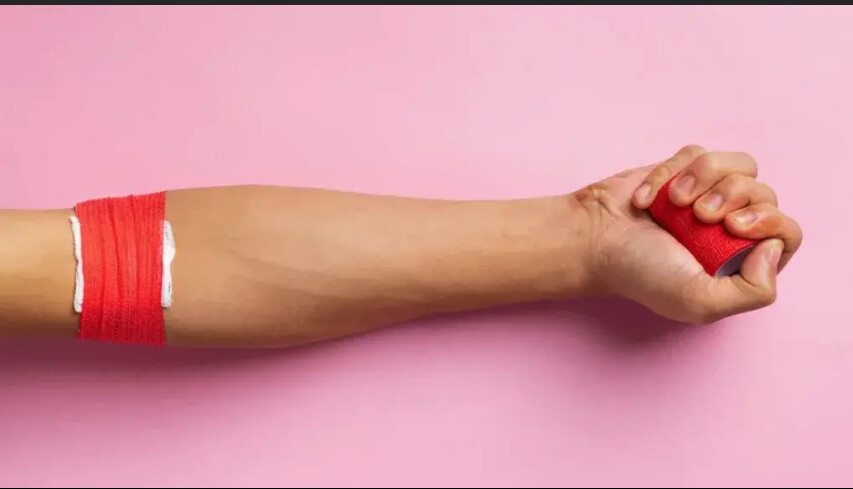
However, the supply of blood is continuously under threat. Even today, multiple blood banks across the country are reporting shortages, from New Jersey to Kentucky and California. Because blood has a limited shelf life and the demand is unpredictable, any change in the number of donors can dramatically impact supply. At any given time in the United States, as many as one in five medical centers are operating with a one-day supply of blood products, putting patients at significant risk.
So why is blood such an important resource for medical care? Blood is made up of several components and serves many purposes. After donation, whole blood is separated into its component parts so that each can be used for recipients who have specific needs.
Blood donation, explained
Red blood cells containing the oxygen carrying molecule hemoglobin are separated and made into a unit of PRBC-packed red blood cells, so that they can be reconstituted with saline and infused into patients with anemia for any number of reasons. Trauma victims, cancer patients, and patients undergoing major operations are just some examples of the people who benefit from PRBC. Platelets are important for blood clotting and various conditions can drop patient platelet counts dangerously low in which case bleeding can become an issue. Platelet transfusions may be life saving for them. Finally, the protein-rich plasma has many possible roles and can be given to patients with various types of ailments including autoimmune processes like Guillain Barre syndrome or Myasthenia Gravis or more recently, for patients with severe COVID-19-related illness.
Each year, 45 million units of blood are donated at blood banks throughout the western world, according to the American Red Cross. However, these donations are made by 4% only of the population. There are myriad reasons for why more people don't give blood, from fear of needles, to a lack of knowledge of the need and benefits of donating and for some, a perception that donating blood can have detrimental effects such as exposing the donor to the risk of infection (it does not).
But for endurance athletes training for a race, a common concern is how donating blood will affect their ability to train and race. When is is safe to exercise after giving blood and what should you expect as far as your performance?
How does donating blood affect athletic performance?
Endurance athletes have long known that receiving blood transfusions may enhance exercise performance by increasing hemoglobin concentration and allowing for improved oxygen delivery to the cells. So the logic stands that many athletes wonder if donating blood can have the opposite effect: Can lowering hemoglobin concentration by donating blood negatively impact exercise performance? Fortunately, there is a reasonable body of evidence on the subject that can help athletes make an educated decision on this important question.
After a typical blood donation, hemoglobin levels do indeed predictably decrease by an average of 7 percent and remain depressed for at least 14 days after donation. By then, they have recovered by about half, to a 4 percent decrease from pre-donation levels, according to a 2017 study in Transfusion. Hematocrit, or the measure of what percentage of blood volume is made up of red blood cells, also decreases for the first few days after a donation. Hematocrit also decreases by 5 percent 48 hours after donation, recovers within two weeks after the donation. This is because the new cells that have been synthesized in that two-week period contain less hemoglobin than more mature cells. As a result, the hematocrit recovers more quickly than the hemoglobin concentration.
Because hemoglobin is needed for carrying oxygen to tissues in the body, the decrease in hemoglobin seen with blood donation is associated with a decrease in oxygen-carrying capacity and delivery, accounting for a measurable 7 percent decrease in VO2 max in the 24-48 hours after donation. Interestingly, this decrease completely disappears by day three, suggesting that blood volume has re-expanded by that point and increases in heart rate likely compensate for the decreased hemoglobin to restore oxygen delivery to normal. Because VO2 max is a measure of oxygen utilization by peripheral tissues, if oxygen delivery is restored to near-normal levels by the third day after a donation, then it makes sense that VO2 max would recover, as cellular metabolism is unaffected by hemoglobin levels alone.
Along with the decrease in VO2 max, measured maximal exercise capacity as well as time to exhaustion when performing at threshold also decreases by about 10 percent after a blood donation, then fully recovers by one week. Submaximal efforts have never effectively been studied, so no clear conclusions can be made about efforts in that range after blood donation.
Taken together, these findings suggest that blood donation is indeed associated with a measurable decrease in exercise performance, principally at the highest levels of exertion. This effect is maximal for the first two days after a donation, and has disappeared by fourteen days after donation.
When can I exercise after donating blood?
Clearly, blood donation is compatible with endurance training. Athletes need only to incorporate such donations into their schedule so that they do not have high-intensity training for several days to a week after a donation, and certainly should not donate within two weeks of a race.
The satisfaction gained from the knowledge of having helped others in this way should be more than sufficient motivation to arrange one's schedule to make this possible. Please donate and do your part to help save a life.
(03/04/2023) Views: 1,053 ⚡AMPby Trail Runner Magazine
2023 Kaiser Permanente Napa Valley Marathon & Half at Full Capacity as Runners Gear Up for Race Weekend
The 2023 Kaiser Permanente Napa Valley Marathon & Half Marathon has officially sold out, with runners from around the world gearing up for the highly anticipated race. The event, scheduled for March 5th, has drawn runners of all abilities who are ready to tackle the scenic courses through California’s beautiful wine country.
The Napa Valley Marathon is a celebration of running, health, and wellness. The point-to-point race will feature several runners looking for their Olympic Marathon Trials qualifying time, including last year’s female champion and course record holder, Ann Centner (2:38:29). Others to watch include Peter Gilmore, Napa Valley Marathon’s 2009 champion who is now a top-level masters runner. This year’s field also includes wheelchair athlete Rob Balucas, who was injured in a biking accident in 2015 and became paralyzed. Rob hopes to qualify for the Boston Marathon.

Local runner Jonathan Pascual is a five-time finisher of the Napa Valley Marathon and is returning to the race this year after a seven-year absence due to health issues. Jonathan was diagnosed with stage IV cancer and had to put his running on hold. But this year, he is ready to tackle the course once again.
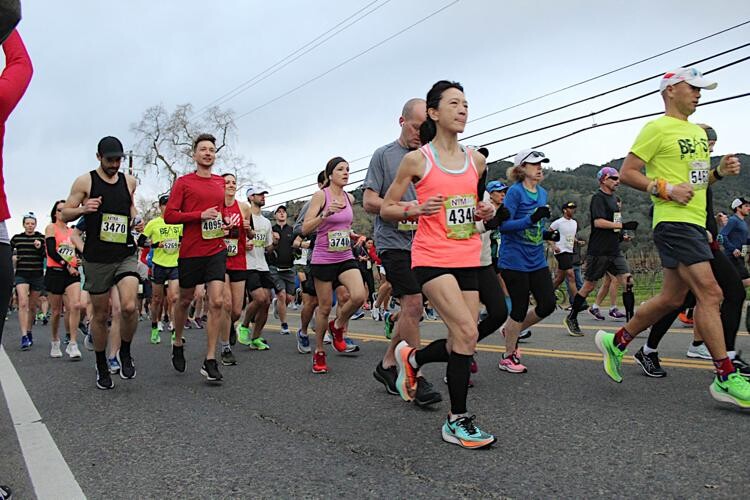
“It was through nutrition and my diligence in exercise that I could do a comeback running race in December 2022. I knew then that with the cancer treatments and continued training, I can keep getting stronger and fitter,” Jonathan said. “ I have accepted that I will no longer be the athlete I was once nor could I perform the way that I used to. So I decided that these are times of discovery. The challenge is to figure out what my mind and body can do athletically”.
According to Race Director, Michelle La Sala, “Whether runners are looking for a personal best, coming to celebrate a girl’s weekend, or seeking out a beautiful and inspiring course to achieve a goal, the Napa Valley Marathon offers it all. One of the largest sporting events in the valley and with proceeds supporting the local community, we are thrilled at the continued growth and notoriety this race brings. On behalf of the Napa Valley Marathon, Inc. board of directors and President Jonathan Williams, we look forward to welcoming runners to Napa and showing them a wonderful weekend!”
For more information about the 44th annual Napa Valley Marathon & Half Marathon, visit the event’s website at www.napavalleymarathon.org.
(03/01/2023) Views: 670 ⚡AMPby Running USA
Kaiser Napa Valley Marathon
As one of California's top tourist destinations, Napa Valley has been home to this race for decades. When it comes to scenic, it just doesn't get better than Napa in the spring. The narrow valley is covered in grape vines that stretch high up the hillsides on either side. The colors are crisp green, blue and yellow at that time...
more...Spencer, beloved Boston Marathon dog, dies after battle with cancer
Spencer, a golden retriever who became famous for cheering on runners each year during the Boston Marathon, has died.
Spencer's owners confirmed Tuesday that the "Official Dog of the Boston Marathon" died.

"We told him we loved him, and we thanked him until his last breath," Spencer's owner, Rich Powers said. "He was a gift given to us that we shared with the world, and we just gave it back."
Spencer was 13 years old and in October was diagnosed with untreatable liver cancer. It was the second time Spencer battled cancer, previously having a tumor removed in 2020.

"Throughout all of his treatments, I cannot stress this enough, this dog handled it like champ," Powers said. "He gave us his last gift to not make us wonder for the rest of our lives, 'Did we make the right decision?' We know we made the right decision."
In January, artists unveiled a massive portrait of Spencer at the Fairmont Copley Plaza as he was named the honorary canine ambassador for the hotel.
(02/22/2023) Views: 611 ⚡AMPBoston Marathon
Among the nation’s oldest athletic clubs, the B.A.A. was established in 1887, and, in 1896, more than half of the U.S. Olympic Team at the first modern games was composed of B.A.A. club members. The Olympic Games provided the inspiration for the first Boston Marathon, which culminated the B.A.A. Games on April 19, 1897. John J. McDermott emerged from a...
more...Want to Live Longer? One Study Says to Eat Like This.
It's no surprise that what people eat has an impact on their health, but trying to pinpoint exactly what diet out of the hundreds out there is most optimal for a long, healthy life can be overwhelming. A new study reports that there is no one optimal diet for longevity, but several general eating patterns that can shift life expectancy.
Published in the journal JAMA Internal Medicine, the study found that one can reduce their risk of an early death by nearly 20 percent by eating foods from one of four healthy eating patterns: A Mediterranean diet, a plant-based diet, the Alternative Healthy Eating Index and the Dietary Guidelines for Americans (more on those below). All four eating patterns emphasize whole grains, fruits, vegetables and legumes.

Professor and chair of Harvard's Department of Nutrition, Dr. Frank Hu, said in a statement, "It is critical to examine the associations between DGAs- recommended dietary patterns and long-term health outcomes, especially mortality."
Hu says there is a lot of flexibility when it comes to eating healthy and dietary choices can be tailored to individual preferences as long as they adhere to the basics of any of the four healthy eating styles. This means that even if you get tired of eating one way, you can switch over to another dietary plan. The study followed the eating habits of 75,000 women and 44,000 men over 36 years. Every four years, the participants would fill out questionnaires about what food they ate, and each person was scored based on how much they adhered to one or more of the eating patterns.
Participants who remained consistent with their healthy eating patterns could reduce their risk of dying from respiratory disease by 35 to 46 percent, cardiovascular disease by 6 to 13 percent and dying from cancer by 7 to 18 percent.
Most people are familiar with the Mediterranean diet and a plant-based diet, but what about the other half of the recommended four healthy eating patterns?
Alternative Healthy Eating Index
Developed by Harvard researchers, the Alternative Healthy Eating Index (AHEI) assigns ratings to foods for how well they prevent chronic diseases and illnesses including cancer, diabetes, heart attacks and strokes.
Some AHEI food choices include a variety of vegetables with a focus on leafy greens, four servings of fruit a day, whole grains, nuts, legumes and vegetable proteins like tofu, fish and healthy fats like olive oil. In following this eating pattern, it's suggested one avoids potatoes, refined grains, fruit juices and saturated fats.
Participants of the study who followed the AHEI eating pattern reduced risk of death by 20 percent.
The Dietary Guidelines for Americans (DGA) is a metric designed to measure diet quality by how closely one follows its recommendations: Focus on variety, nutrient density and portions, limit added sugars, saturated fats and sodium and avoid sugary beverages. The guidelines are less specific on what foods to eat, rather an outline on how to customize nutrient-dense meals, meeting dietary needs and staying within calorie limits.
Within this study, participants who followed this eating pattern had a 19 percent lower risk of dying.
(01/21/2023) Views: 742 ⚡AMP
by Trail Runner Magazine
British man completes 365 straight marathons, earning a well-deserved beer
On Saturday, Gary McKee completed his 365-day run streak of a marathon every day in his hometown of Cleator Moor, U.K. Thousands of supporters and media were on hand to help him celebrate his accomplishment of covering more than 9,500 miles (15,289 kilometers) while raising more than $2,000,000 for charity.
McKee’s marathon streak was not the only streak that ended. McKee went one year without drinking, and celebrated his huge run with a well-deserved cold one. The beer was a personalized craft IPA from Ennerdale Brewery in Cumbria, U.K., called “The Marathon Man 365 IPA”.

McKee ran the final stretch with his friends and family and immediately thanked everyone who came out for all their support during his challenge: “The reason I’m doing this is that I’m lucky enough to be able to take on a physical challenge of this scale, and every day I think about all the people going through cancer treatment who face their own physical and emotional challenges.”
McKee ran for Macmillan Cancer Support and Hospice in West Cumbria, which supported his father through a cancer diagnosis in 1997. His father recovered from cancer, but died from an unrelated illness in 2005.

McKee, who is himself a father of three, routinely woke up at 5 a.m. and headed out on his marathon before starting his work shift at 2 p.m.
Although McKee is considered to be the first British runner to run 365 consecutive marathons, Spanish ultrarunner Ricardo Abad Martinez holds the world record, with 607 marathons in 607 days between October 2010 and February 2012.
McKee told local news he will take a break from marathoning over the next couple of weeks to spend time with his family before planning his next challenge.
(01/03/2023) Views: 716 ⚡AMPby Running Magazine
Covid Completely Changed the Way We Stay Healthy—Here's How
Which hard-earned lessons about staying well have stuck.The height of the Covid pandemic was brutal. Three years after this all started, leading scientists tell us what hard-learned lessons have stuck when it comes to staying healthy now—and through whatever comes next.
Risk Management Is Huge

Before the pandemic, how often did you really think about defending yourself from respiratory bugs? “Most people were shrugging off the risk. Respiratory viruses weren’t that big of a thing,” says Amesh Adalja, M.D., an infectious-disease physician at the Johns Hopkins Center for Health Security. Covid forced us all to take viruses seriously on a daily basis, and it highlighted the power our personal habits—handwashing, masking, getting vaccinated, determining which indoor situations to take the risk on or not—can have over the likelihood of getting sick. Covid also made it clear that not managing risk had consequences beyond a tough stay in the hospital or, in mild cases, losing a few sick days. One 2022 study found that a person infected with Covid was 33 times as likely to suffer from a first-time arterial blood clot during the first week of infection as someone who had never had the disease. Respiratory viruses can trigger other real medical emergencies, and these compounding factors can damage major organs and raise your risk of autoimmune conditions. Even relatively mild Covid can cramp your breathing and gym stamina for months.
Vitamin D Is a Health Hero
Prepandemic, it was easy to think of vitamin D as a bone-building nutrient found in milk, and that was kind of it. But then Covid-era research showed a higher risk of testing positive for the disease among people with a vitamin D deficiency compared with people whose levels were fine. Experts suspected that optimal amounts of the vitamin may help shield you from Covid, as it does with other respiratory illnesses.
There’s no clear conclusion on that yet, says Eric Feigl-Ding, Sc.D., chief of the Covid-risk task force at the New England Complex Systems Institute. But doctors have long known that the nutrient plays a crucial role in immune health—and about one in three American adults is not getting enough.
Vitamin D helps your immune system “across the board,” says Feigl-Ding. It rallies parts of that system to get working against microbes, and it may also reduce inflammation—a process that plays a role in a huge number of health conditions, including cancer, heart disease, type 2 diabetes, Alzheimer’s, rheumatoid arthritis, and even depression.
If you already have enough vitamin D, extra won’t benefit you. (A blood test can tell you your level.) To stay at a healthy amount, aim for five to 30 minutes of midday, sunscreen-free sun exposure at least twice a week (your body uses it to make its own vitamin D) and eat D-rich foods. That’s salmon, trout, and fortified cow’s or plant milk. If you don’t eat these foods or get that much direct sunlight, consider taking a supplement as an “insurance policy” in the winter, Feigl-Ding advises.
Long Covid Is Helping Us Understand Other Illnesses
Even one of the pandemic’s most devastating and puzzling legacies, long Covid, may help drive up our understanding of health. This wide swath of troubles that linger for about half of people who’ve had symptomatic Covid—everything from joint pain to brain fog—may not end up being unique to this virus. And it’s creating a surge of interest in studying seemingly similar but often dismissed conditions like chronic fatigue syndrome (CFS) and post-treatment Lyme disease syndrome.
We’re still learning about long Covid, but among the theories about what causes these symptoms are organ damage, chronic inflammation (including of the central nervous system), and reservoirs of virus remaining in the body, Feigl-Ding says. These are some of the same factors scientists think may be involved in CFS.
Knowing more about long Covid could shed light on these other conditions, too, explains Dr. Adalja. What’s very clear, at least, is that “these illnesses are valid,” says William Schaffner, M.D., a professor of preventive medicine and infectious diseases at the Vanderbilt University School of Medicine.
The Basics Are a Big Deal
Health issues that develop over time, like stroke and type 2 diabetes, have been on the rise for years. About 60 percent of U. S. adults have at least one chronic illness, while four in ten have two or more. Yet until you’re diagnosed with one, the danger of chronic illness can feel far off.
Covid made it clear that people with chronic conditions were at a higher risk for severe illness, and it made people take an honest look at their health habits. Obesity, for instance, went from being “something I’ll get around to dealing with” to being a risk factor for complications from a scary new virus, says Dr. Schaffner. To clarify the synergy, Dr. Feigl-Ding tells people to “picture a glass.” Every risk factor—eating excess sugar, not exercising, not treating high blood pressure—adds water to the cup, while healthy habits decrease the water level. Covid can push the water over the rim and uh-oh.
The takeaway here is more of a reminder, really: You know what to do. You can prevent chronic illnesses by eating well, being active, avoiding tobacco, and being moderate with alcohol. Those small lifestyle habits may well save your life.
(01/02/2023) Views: 735 ⚡AMPby Men's Health
British man Gary McKee to make history for most marathons in one year
Some people’s New Year’s resolution is to quit drinking. For others, it’s to run a marathon. But for Gary McKee of Cleator Moor, in northwestern England, his resolution was to quit drinking and run a marathon–every single day for a year. McKee is two days away from completing his unbelievable challenge of running 365 consecutive marathons.
McKee, who has gained the nickname The Marathon Man, has covered more than 9,500 miles (15,289 kilometers) in 363 days while raising more than $2,000,000 for charity. His distance covered is equivalent to running across Canada three and half times. McKee’s challenge will come to an end on New Year’s Eve.

McKee, 53, told The Guardian, that he intends to have one celebratory beer to celebrate his efforts and year-long drought.
The father of three routinely wakes up at 5 a.m. and heads out on his marathon before starting his work shift at a nearby power plant at 2 p.m.
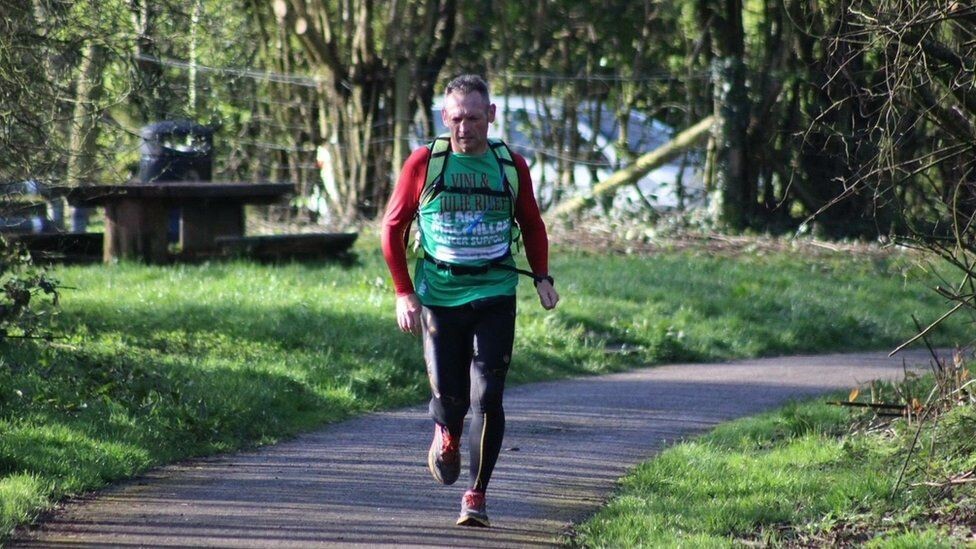
McKee has completed most of his marathons between three and a half and four hours. In 2021, McKee completed 110 marathons in a row.
McKee is running for Macmillan Cancer Support and Hospice in West Cumbria, which supported his father through a cancer diagnosis in 1997. His father fully recovered from cancer but died from an unrelated illness in 2005.
You can follow McKee’s 365 challenge on his Strava or Twitter page.
(12/30/2022) Views: 722 ⚡AMPby Marley Dickinson
Do Runners Drink Too Much Alcohol?
A growing body of research says that no amount of alcohol is good for our fitness and health. It’s time to rethink our relationship with booze.
Pro ultrarunner Coree Woltering doesn’t do anything halfway. “If I’m going to do it, I want to do like 120 percent, no matter what it is,” he says. When he brings that attitude to his running and racing, the results speak for themselves—like setting a new fastest known time on the 1,000-plus-mile Ice Age Trail across Wisconsin in 2020.

However, Woltering also brought that attitude to the bar. “It wasn’t just a ‘let’s have two beers and be done’ thing,” says the 32-year-old from Dalton, Georgia. Two beers at his house would lead to four more at the bar. “Six a night would be normal.” The results were noteworthy—but in all the wrong ways. His training became inconsistent. After long nights out, he’d sometimes skip sessions. When he did get out to run, he found his focus and mental fortitude lacking. Woltering doesn’t take over-the-counter pain management medications like Tylenol or ibuprofen. Instead, he’d slam a beer or two late in a race, hoping to hush the screaming of his feet and legs.
This approach is not unusual, says David Wyrick, PhD, a public health education professor and the director of the Institute to Promote Athlete Health & Wellness at the University of North Carolina, Greensboro. Wyrick studies alcohol use among student-athletes. Pain control is one of three primary reasons athletes report using alcohol (along with stress management and as a way to celebrate). Though, when it comes to pain, “there’s no evidence that alcohol has medicinal benefits,” says Wyrick.
Almost all the benefits Americans attribute to alcohol—that it is good for the heart, helps you sleep, eases pain—are false, says George F. Koob, PhD, director of the National Institute on Alcohol Abuse and Alcoholism. “The truth is, there’s no safe amount of alcohol, not even one drink a day,” he says.
And yet: Running culture—which is otherwise populated by protein-shake-drinking, heart-rate-tracking, health-obsessed fitness nuts—is enmeshed with drinking. From brewery-based runs to the infamous beer mile to groups with the motto “a drinking club with a running problem,” alcohol is as much a part of the fabric of our sport as energy gels. But the fact is, alcohol destroys lives and families. Running culture that glibly celebrates it is feeding that destruction.
Pulling them apart doesn’t mean eliminating alcohol. Koob has spent the last eight years working on issues around alcohol abuse, yet he describes his own approach to alcohol as “one eye open.” A glass of beer or wine every now and then? That’s fine for most runners. But blithely telling yourself beer is a recovery drink because it has carbs and your Tuesday night run ends at a bar? Not so much.
It’s time to take a good look at what we know—and don’t know—about alcohol’s relationship to our health, running performance, and mental well-being.
Booze and Sleep Don’t Mix

Three years ago, journalist Lisa Slade, a 38-year-old recreational marathoner, purchased a Whoop wearable device. Each morning, Whoop prompted her to input data about what she did before bed. Questions included: Did you eat a big meal? Are you under a lot of stress? Did you consume alcohol last night?
At the end of the first month, Slade got a summary of her data. “Pretty much the only thing I noticed that negatively impacted me to an alarming amount was alcohol,” she says. Slade had considered herself a light drinker—maybe a beer while making dinner, or two cocktails if she was out with friends. Even that low dose, though, was affecting her recovery times and sleep quality by as much as 20 percent. “I could tell that I was having a harder time recovering from it,” she says. After “just one or two drinks, I’d wake up and wouldn’t feel so good, like I hadn’t slept super well.”
Emily Capidolupo, senior vice president of data science and research at Whoop, says Slade’s revelation is common among new Whoop users. She adds that many cut back on drinking after a few months of using the wearable, which uses biometric data like heart rate, heart-rate variability, respiration rate, and sleep quality to score a user’s overall recovery. Alcohol “is one of those things we know is bad for us, but we don’t realize quite how bad,” she says. When Whoop presents the data in a tidy end-of-month report, it’s clear for many users that alcohol is a poison. “It’s a fun poison,” says Capidolupo. “But it’s poison.”
When you head out for beers after an evening run, you put an extra task on your body’s to-do list. In addition to recovering, it now must divert energy to breaking down the alcohol entering your bloodstream, inhibiting crucial functions like repairing exercise-induced muscle damage. Alcohol also impacts your immune system, blocking inflammatory responses vital to this process. For chronic drinkers, the negative effect on immunity can lead to more illness and fewer training days.
Compounding the issue, though, is that the most popular time to imbibe is in the hours before bed. Alcohol wrecks sleep quality, says Christopher Winter, MD, a Charlottesville, Virginia–based sleep specialist and host of the Sleep Unplugged podcast. If this seems counterintuitive, and a single beer makes you drowsy, you’re not alone. Alcohol is the most popular sleep aid in the country, he says, but that’s because most people don’t understand the difference between being sedated and being asleep.
Alcohol suppresses your central nervous system. That is not high-quality rest. Since alcohol relaxes a lot of the muscles involved with breathing, you may breathe less deeply as you sleep, lowering your oxygen saturation levels, says Winter. When you’re not getting enough oxygen, your body’s natural response is to wake you up. Alcohol also suppresses deep sleep, which is when your body makes growth hormone.
“If you’re grinding out the miles and trying to recover before a race or your next training session, alcohol impairs your ability to do that,” he says. It may also interfere with the secretion of melatonin, a hormone associated with sleep, which can mess with your shut-eye schedule causing daytime drowsiness and nighttime restlessness—so you reach for another beer. If you do plan to drink, drink less and do it very early, says Winter. “There really is no way to sidestep its negative properties.”
Not being able to fall asleep can cause extreme anxiety, especially as you count the minutes wide awake until the alarm says it’s time to get up. Many people turn to alcohol to dull anxiety, though it’s neither good nor effective, says Winter. It may mask the issue for a night, but it won’t give you the rest you need. If you’re struggling to get to sleep at night, first clean up your sleep hygiene by logging off devices and stress-inducing news sources at least an hour before bed. Consider meditation or quiet journaling, which can help you unwind, says Winter. And if you’re still worried about your sleep quality, take the issue to a sleep specialist.
The Pandemic Didn’t Help
J.R. Jamison, a 43-year-old Indiana-based author and NPR host, took up running 10 years ago and eventually lost 80 pounds. He was healthy and fit and loved how running got him out into the world. But when the pandemic hit, he found it difficult to differentiate between weekends and weekdays.
Jamison admits his weekend drinking habits had always been on the heavy side. But when Tuesday night started to feel just like a Friday night and no one was going anywhere, weekend drinking became everyday drinking. Next thing he knew, the running habit that had changed his life had fallen by the wayside. “There’s no doubt that substance use disorders have skyrocketed since the pandemic,” says Dave Rabin, MD, PhD, a San Francisco–based psychiatrist. A CDC report from August of 2020 found that 13 percent of Americans started or increased their use of substances like alcohol during the first six months of 2020.
Rabin says that, at its core, substance use stems from a human desire to avoid discomfort like stress, anxiety, or lack of control. And if we haven’t learned healthy, long-term strategies for managing discomfort, we look for something to alleviate that discomfort. Alcohol often produces the desired numbing effect.
As Jamison found himself drinking more, he had less energy and motivation. He’d wake up with brain fog and struggle through a day of work. With no impetus to run, and little accomplished professionally, he’d reach for a drink each night.
What’s so insidious about alcohol and other sedatives, says Rabin, is that these drugs numb our frontal-cortex activity, decreasing our insight and judgment. As a result, we unwittingly train ourselves to embrace a casual attitude toward self-reflection—and wind up oblivious to our problematic behavior, he says.
Running, however, does the opposite. It results in a neurochemical response in the brain, with endogenous pleasure molecules, endogenous opioid molecules, and endogenous cannabinoid molecules, plus dopamine and serotonin, all releasing on cue like one glorious feel-good chorus. This is why addiction specialists often recommend it as a coping mechanism for those struggling with alcohol use disorder, says Rabin.
But running won’t help if you can’t summon the motivation to do it. It took Jamison more than a year to rediscover his enthusiasm. As 2021 came to a close, he committed to Dry January. “I didn’t have a drop to drink throughout January, and I started to notice that I wasn’t waking up anymore with headaches,” he says. He started running again. “I liked the way I felt. I was happier. I just decided not to drink again, and I haven’t.”
The Myth of Healthy Drinking
Not long after Lisa Slade saw the effect of alcohol on her Whoop data, she clicked around the Internet looking for more info on why the impact was so dramatic. “We’ve been told our whole lives that a beer or a glass of wine is heart-healthy,” says Slade, who has since cut back her drinking. “But I was reading studies about the effects of alcohol and it turns out that maybe it’s not good for you at all.”
Alcohol is a known carcinogen, a substance that can cause cancer, says Tim Rebbeck, MD, a professor of cancer prevention at Harvard University. When you drink, your body relies on two enzymes to break alcohol molecules into pieces small enough for removal from the body. That breakdown process creates a byproduct called acetaldehyde. Laboratory, animal, and human studies have all shown that acetaldehyde causes DNA damage to cells, and this damage can lead to cancerous tumors. “We are sure that alcohol is a causative factor in some cancers, and it’s supported by lots of different lines of evidence,” says Rebbeck.
Getting the word out that alcohol—like tobacco—is a carcinogen has been difficult for several reasons. For one thing, alcohol is socially acceptable and even socially encouraged. Furthermore, the relationship between alcohol and cancer is more complicated than smoking’s direct link to lung cancer. Head, neck, liver, and breast cancer all have strong links to alcohol, says Rebbeck. But, of course, some people who never drank a drop will still get breast cancer and vice versa. “It’s a complex story, and people have a hard time digesting complex stories,” he says. And how much of a role alcohol played in any one person’s cancer development is an impossible equation to tease out.
As for a glass of wine being heart-healthy, recent research has debunked that advice, says Koob. The early studies concluding that it helps your heart were based on the resveratrol in red wine, but the amount you’d have to drink to get the benefits of the compound would tear your liver up, he says. A 2019 study published in the Journal of The American Heart Association confirms this, finding that heavy drinking is a risk factor for cardiovascular disease.
Even studies that find some benefit to drinking may not hold up under scrutiny. Over the years, a handful of meta-analyses of all-cause mortality among drinkers versus nondrinkers found a “J-shaped curve” between the two. Basically, mortality was slightly higher for nondrinkers, but dipped for moderate drinkers, and then rose sharply for heavy drinkers, forming a J. This would appear to make the “glass of wine for heart health” statement true. But in 2015, researchers took a closer look at these studies. When they teased out exactly why many abstainers did so, they found a confounding variable: These people were eschewing alcohol because of existing health concerns. In other words, they were less healthy than the moderate-drinking group to begin with. When researchers adjusted the data to account for abstainers with outstanding health concerns, the initial hump on the J flattened out.
Studying alcohol use and health effects is difficult, in part because people often don’t remember how much they consumed or because they aren’t being honest about it, says Rebbeck. That makes giving recommendations on how much and how often to drink difficult, too.
Interestingly, not a single expert interviewed for this story told us to stop drinking. Several mentioned that they occasionally enjoy wine and beer. “‘Don’t ever do anything that might harm you’ is not useful messaging,” says Rebbeck. Life is full of things that can harm us. Overly charred toast. Processed meats. The flame retardant on our couches. Uneven sidewalks waiting for unsuspecting runners.
A better approach is to consider your personal risk factors, your tolerance for risk, and the joy that alcohol—in moderation—brings you. If you have a family history of breast cancer, or head and neck cancers, you may decide the risk isn’t worth it. If you don’t, drinking in moderation may be a risk you’re willing to take. However, “limiting your exposure to alcohol is the bottom-line answer,” Rebbeck says. “You are consuming a carcinogen. How much of that do you really want?”
The Longest Race: Sobriety
For Coree Woltering, that amount was zero. On November 1, 2021, Woltering got sober. In past years, he’d taken time away from drinking and seen an improvement in his training. But then he’d go back to drinking—and plunge off the deep end. There wasn’t a happy medium where he just had one beer every other night. “It wasn’t just like I drank to get drunk,” he says. “I really enjoyed the taste of certain wines, certain beers. But that’s part of the problem, I enjoyed it to 150 percent.”
A week of sobriety passed. Then another. He jumped in to crew a friend through an ultra and got offered a shot of Fireball at an aid station. When he turned it down, everyone was surprised. “They’re like, ‘Oh, are you not feeling well?’ I’m like, ‘No, I feel great. I’m just not drinking.’ And everyone’s like, ‘Oh, are you sick?’ ‘No, I’m not sick. I’m just literally not drinking.’” That drinking culture and running culture knot is tight.
In the first month, Woltering focused on consistency. He set a goal to run every day in December and hit 30 of the 31 days. Over time, the awkwardness with friends abated, and Woltering found a community of similarly sober athletes. But his performance wasn’t doing the about-face he’d hoped for.
The second month was the rough one. “It was like, ‘Oh, now I feel every little pain in my body,’” he remembers. And then there was the FOMO. “It’s like, for the rest of my life, am I missing out on all these beers and wine that I haven’t tasted yet?”
It would take Woltering six months to get back to a place where he felt good. Yet he wasn’t seeing the times he’d hit in previous training peaks. That was frustrating. Giving up alcohol was supposed to be this golden ticket to better health.
Finally, eight months into sobriety, things started to click. His times began to improve. Those better numbers bolstered his commitment to the sober path. And then, in October of 2022, three weeks before hitting a year of sobriety, Woltering won the Blue Ridge Ultra 50K. It was his first ultra victory since 2019. He celebrated with cake and ice cream.
(12/25/2022) Views: 970 ⚡AMPby Runner’s World
Cranberries Can Prevent UTIs, Support Performance, and Offer More Health-Boosting Benefits
This holiday staple offers more than festive flare.
If you’re only eating cranberries once a year, you’re missing out on a wide array of nutrients and creative dishes. Cranberries have adorned Thanksgiving and holiday tables for hundreds of years. But this naturally tart red berry has many culinary uses. Plus, cranberries are packed with vitamins, minerals, and antioxidants and have been shown to improve heart health, reduce inflammation, and may even enhance performance.

Not to mention that cranberries come in several forms—fresh, dried, and juiced—so you have multiple ways to add them to your diet.
Here, everything to know about cranberries’ benefits, including just how easy they are to add to your plate.
What nutrients will you get from cranberries?
Fresh cranberries are a good source of vitamin K and an excellent source of fiber and vitamin C. Beyond the nutrition label, they also have polyphenols or plant compounds that have been studied for their beneficial role in many health conditions.
According to the USDA, one cup of fresh, whole cranberries has:
46 calories
0.5 g protein
<1 g total fat
12 g carbohydrates
4 g fiber
4 g sugar
14 mg vitamin C
8 mg calcium
80 mg potassium
What are the health benefits of cranberries?
The Dietary Guidelines for Americans recommend two servings of fruit per day, thanks to the plethora of nutrients they offer. Cranberries, in particular, have been studied for their health properties, including these benefits:
1. They can lower your risk of chronic disease
“Cranberries are loaded with antioxidants, so they help defend your body against oxidative stress,” says Samantha Cassetty, MS, RD, plant-focused nutrition and wellness expert and co-author of Sugar Shock. Oxidative stress occurs when free radicals (cell-damaging compounds) outnumber antioxidants in the body.
Research links excessive oxidative stress to chronic conditions, including heart disease, type 2 diabetes, cognitive decline, and cancer. Recent research has found that eating cranberries boosts the antioxidant effect in the body and may fend off these conditions. “When you consume antioxidant-rich foods like cranberries, it helps to correct the imbalance [of free radicals],” adds Cassetty. The same research also points out the anti-inflammatory properties of cranberries—another important component of disease prevention.
2. They benefit your heart
“Cranberries provide numerous cardiovascular benefits,” says Lauren Harris-Pincus, MS, RDN, founder of NutritionStarringYOU.com and author of The Everything Easy Pre-Diabetes Cookbook . An abundance of research suggests that berries, in general, reduce (bad) LDL cholesterol, triglyceries and blood pressure, while increasing (good) HDL cholesterol.
“Additionally, cranberries may help improve the flexibility of your arteries,” says Cassetty. “When arteries become stiff, it can lead to high blood pressure.” The research suggests that cranberries can improve several risk factors for heart disease.
3. They prevent urinary tract infections
You’ve probably heard that cranberry juice can treat a urinary tract infection (UTI). While that’s not necessarily the case, cranberries have been studied for their role in urinary tract health. “Cranberries naturally contain the flavonoid, proanthocyanidin (PAC),” says Harris-Pincus. And it’s this flavonoid that likely blocks the buildup of bacteria and helps to prevent urinary tract infections.
A meta-analysis involving 23 studies and more than 3,900 participants backs up the claim that cranberries can help prevent UTIs in susceptible populations. The study found that those who drank cranberry juice had the biggest reduction in risk of UTIs, compared to those who took a capsule or tablet. In other words, having cranberries in your diet may stop UTIs before they start.
4. They may contribute to a healthy gut microbiome
“A growing body of [new] research suggests that the use of cranberries as part of a healthy diet can help maintain a beneficial population of gut microbiota,” says Harris-Pincus. Small studies in humans and animals show that eating cranberries may alter the gut microbiome in a positive way.
“Your microbiome regulates immune function, inflammation, cholesterol, blood sugar levels and mood, so it pays off when you have a healthy microbiome,” says Cassetty. Yet, more research is definitely needed before making general recommendations about cranberries and the microbiome.
5. They can support endurance performance
Fueling before a run is crucial for maximizing performance, and dried cranberries may be the perfect prerun snack. Packed with easy-to-digest carbohydrates (they have added sugar to improve palatability), they offer up energy for your muscles to maintain long miles.
In addition, the inflammation-fighting compounds in cranberries may help athletes recover faster.
The research on cranberries in the athletic population is lacking, but one study in rowers did find that supplementing with cranberry extract increased postexercise levels of antioxidants in the blood. This is important because strenuous physical activity can raise oxidative stress, and antioxidants can bring it down, as mentioned earlier.
How to add cranberries to your meals
“Cranberries are amazing because of their culinary versatility,” says Harris-Pincus. “Fresh, frozen, and dried cranberries are tasty assets to both sweet and savory dishes,” she adds. Here are some simple ways to add cranberries to your diet, from Cassetty and Harris-Pincus:
Bake cranberries into quickbreads, muffins, pancakes, and crumbles, because the sugar in the baked good will balance the tartness of the berries.
Use dried cranberries in nutritious dishes, like salads, roasted veggies, and grain-based bowls.
Add dried cranberries to a homemade trail mix made with popcorn and nuts.
Include fresh cranberries in baked oatmeal with a dash of maple syrup.
Create a cranberry compote in the microwave with fresh berries, water, your choice of sweetener and citrus. Enjoy it on waffles, pancakes, crepes, oatmeal, or as a sandwich spread.
Drop a few cranberries in a glass of champagne for a healthy garnish.
Add 1 to 2 tablespoons of cranberry juice to your favorite vinaigrette recipe for a tart pink dressing.
Replace the raisins with dried cranberries in your favorite childhood snack, peanut butter over celery, and make “red ants on a log.”
Combine cranberries with sweet potatoes and drizzle with maple syrup and olive oil. Roast for 30 minutes for a sweet and sour side dish.
The bottom line on the benefits of cranberries
Cranberries are affordable, versatile, and underutilized. Not only are they pretty to look at, but they are also good for your health. Whether you like them fresh, dried, or juiced, cranberries are worth adding to your meals. Incorporate them during heavy training seasons to get an added antioxidant boost.
(12/18/2022) Views: 1,161 ⚡AMPby Runner’s World


